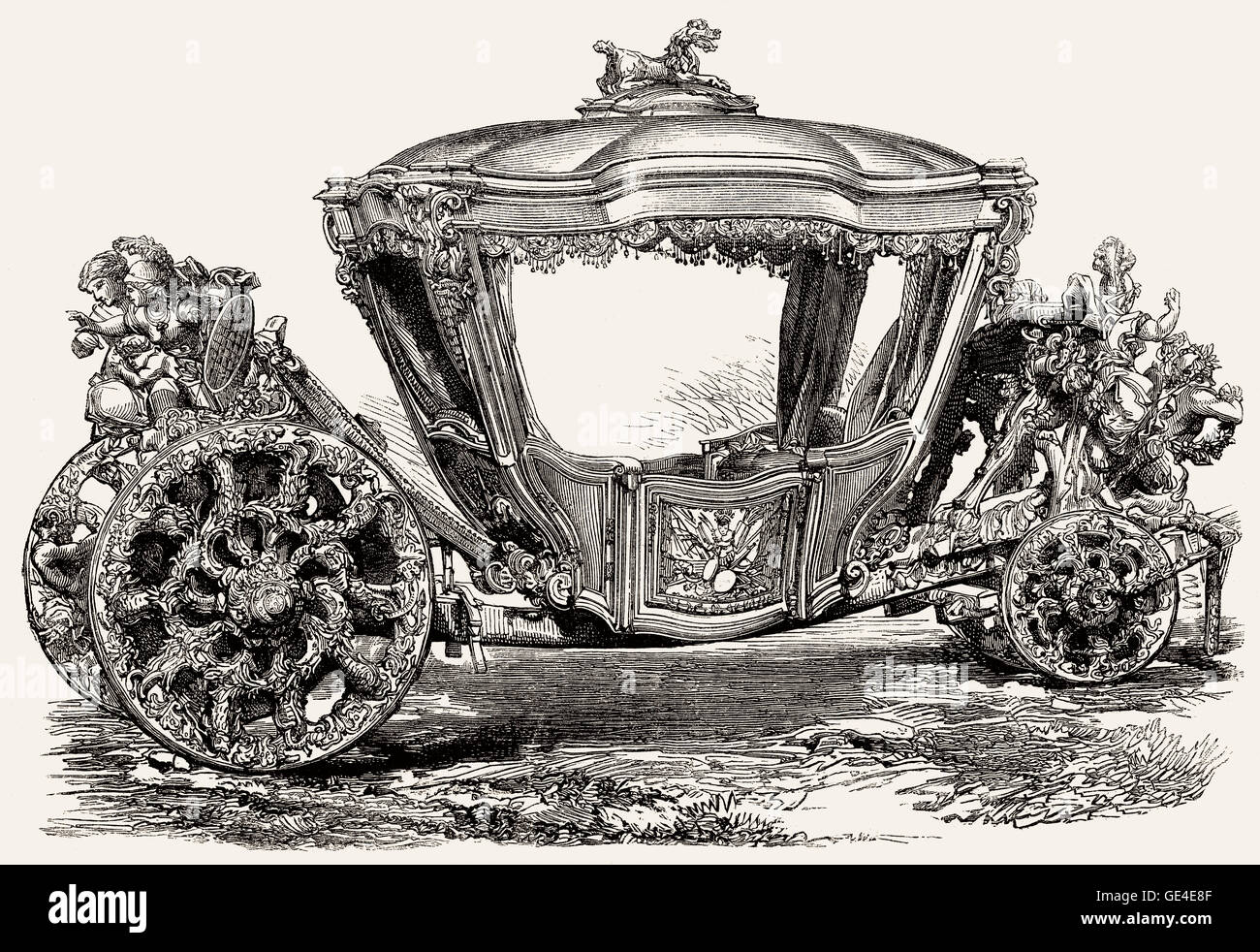Quick filters:
17th century horse cart Stock Photos and Images
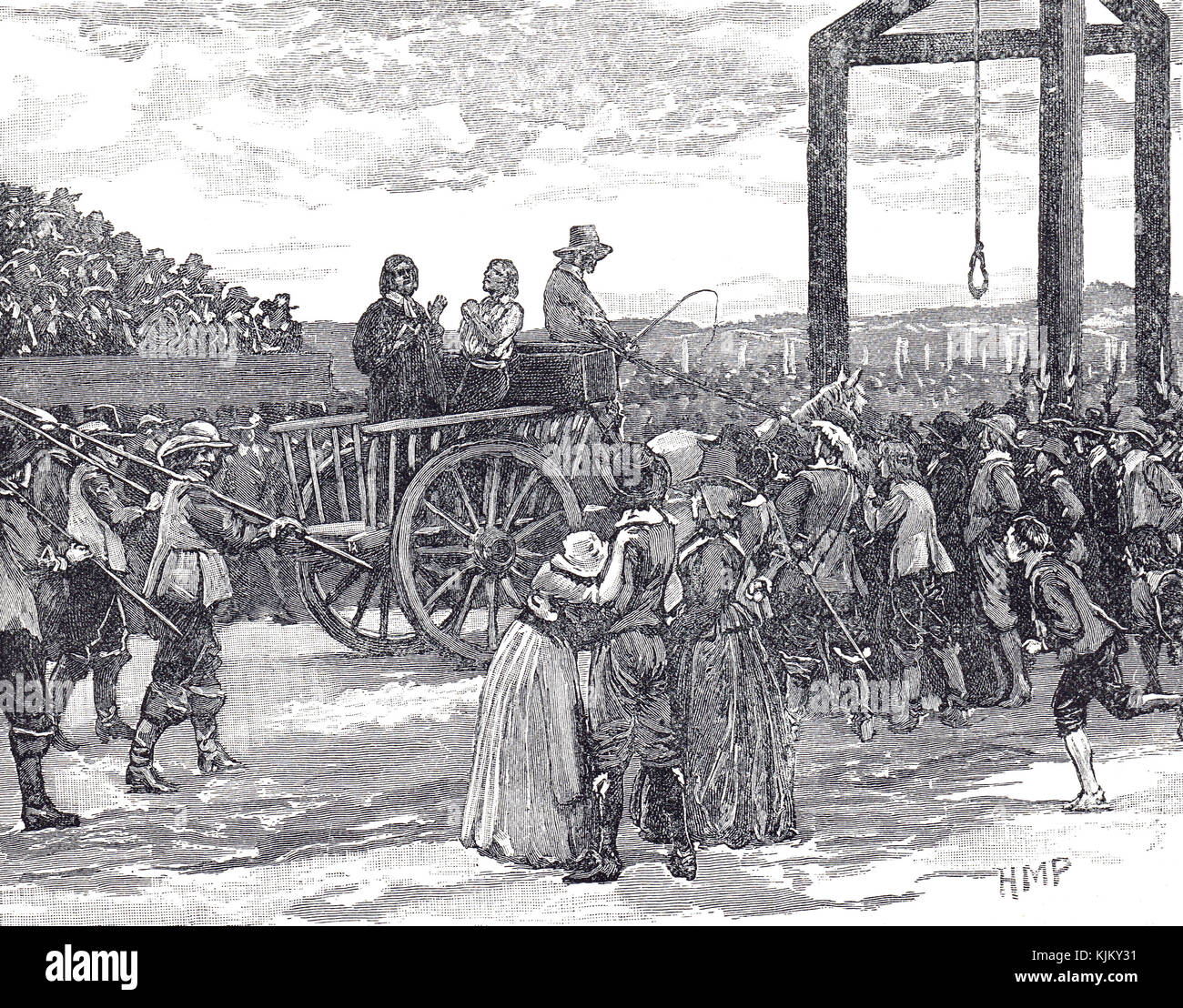 Tyburn Gallows at the time of Charles I Stock Photohttps://www.alamy.com/image-license-details/?v=1https://www.alamy.com/stock-image-tyburn-gallows-at-the-time-of-charles-i-166395461.html
Tyburn Gallows at the time of Charles I Stock Photohttps://www.alamy.com/image-license-details/?v=1https://www.alamy.com/stock-image-tyburn-gallows-at-the-time-of-charles-i-166395461.htmlRMKJKY31–Tyburn Gallows at the time of Charles I
 1870: Horse and cart in outside the 17th-century inn or hostel in White Horse Close, or 'Whitehorse Close'. It was formerly known as 'Ord's Close', after Laurence Ord, the putative builder who built the inn in the enclosed courtyard off the Canongate at the foot of the Royal Mile at the eastern end of the Old Town of Edinburgh, Scotland Stock Photohttps://www.alamy.com/image-license-details/?v=1https://www.alamy.com/1870-horse-and-cart-in-outside-the-17th-century-inn-or-hostel-in-white-image151658921.html
1870: Horse and cart in outside the 17th-century inn or hostel in White Horse Close, or 'Whitehorse Close'. It was formerly known as 'Ord's Close', after Laurence Ord, the putative builder who built the inn in the enclosed courtyard off the Canongate at the foot of the Royal Mile at the eastern end of the Old Town of Edinburgh, Scotland Stock Photohttps://www.alamy.com/image-license-details/?v=1https://www.alamy.com/1870-horse-and-cart-in-outside-the-17th-century-inn-or-hostel-in-white-image151658921.htmlRMJPMJE1–1870: Horse and cart in outside the 17th-century inn or hostel in White Horse Close, or 'Whitehorse Close'. It was formerly known as 'Ord's Close', after Laurence Ord, the putative builder who built the inn in the enclosed courtyard off the Canongate at the foot of the Royal Mile at the eastern end of the Old Town of Edinburgh, Scotland
 fireback, Anonymous, second half 17th century, cast, General: 97 x 69 x 1.7cm 970 x 690 x 17mm, horse, angel, man, wagon, Iron fireback depicting Admiral M.Hz. Trumpet on the waters on a victory cart. He holds a trident in one hand and the reins in the other. The carriage is pulled by horses. Two angels can be seen on the left and right. At the top right, a trumpet angel floats, with two more angels on the left. There is a flag on the trumpet that says EER EN LOF ZY TROMP. The performance is framed by a pearl rim. Around it is a frame with flowers and fruits. The hob is rectangular, with a Stock Photohttps://www.alamy.com/image-license-details/?v=1https://www.alamy.com/fireback-anonymous-second-half-17th-century-cast-general-97-x-69-x-17cm-970-x-690-x-17mm-horse-angel-man-wagon-iron-fireback-depicting-admiral-mhz-trumpet-on-the-waters-on-a-victory-cart-he-holds-a-trident-in-one-hand-and-the-reins-in-the-other-the-carriage-is-pulled-by-horses-two-angels-can-be-seen-on-the-left-and-right-at-the-top-right-a-trumpet-angel-floats-with-two-more-angels-on-the-left-there-is-a-flag-on-the-trumpet-that-says-eer-en-lof-zy-tromp-the-performance-is-framed-by-a-pearl-rim-around-it-is-a-frame-with-flowers-and-fruits-the-hob-is-rectangular-with-a-image386383717.html
fireback, Anonymous, second half 17th century, cast, General: 97 x 69 x 1.7cm 970 x 690 x 17mm, horse, angel, man, wagon, Iron fireback depicting Admiral M.Hz. Trumpet on the waters on a victory cart. He holds a trident in one hand and the reins in the other. The carriage is pulled by horses. Two angels can be seen on the left and right. At the top right, a trumpet angel floats, with two more angels on the left. There is a flag on the trumpet that says EER EN LOF ZY TROMP. The performance is framed by a pearl rim. Around it is a frame with flowers and fruits. The hob is rectangular, with a Stock Photohttps://www.alamy.com/image-license-details/?v=1https://www.alamy.com/fireback-anonymous-second-half-17th-century-cast-general-97-x-69-x-17cm-970-x-690-x-17mm-horse-angel-man-wagon-iron-fireback-depicting-admiral-mhz-trumpet-on-the-waters-on-a-victory-cart-he-holds-a-trident-in-one-hand-and-the-reins-in-the-other-the-carriage-is-pulled-by-horses-two-angels-can-be-seen-on-the-left-and-right-at-the-top-right-a-trumpet-angel-floats-with-two-more-angels-on-the-left-there-is-a-flag-on-the-trumpet-that-says-eer-en-lof-zy-tromp-the-performance-is-framed-by-a-pearl-rim-around-it-is-a-frame-with-flowers-and-fruits-the-hob-is-rectangular-with-a-image386383717.htmlRM2DCH8AD–fireback, Anonymous, second half 17th century, cast, General: 97 x 69 x 1.7cm 970 x 690 x 17mm, horse, angel, man, wagon, Iron fireback depicting Admiral M.Hz. Trumpet on the waters on a victory cart. He holds a trident in one hand and the reins in the other. The carriage is pulled by horses. Two angels can be seen on the left and right. At the top right, a trumpet angel floats, with two more angels on the left. There is a flag on the trumpet that says EER EN LOF ZY TROMP. The performance is framed by a pearl rim. Around it is a frame with flowers and fruits. The hob is rectangular, with a
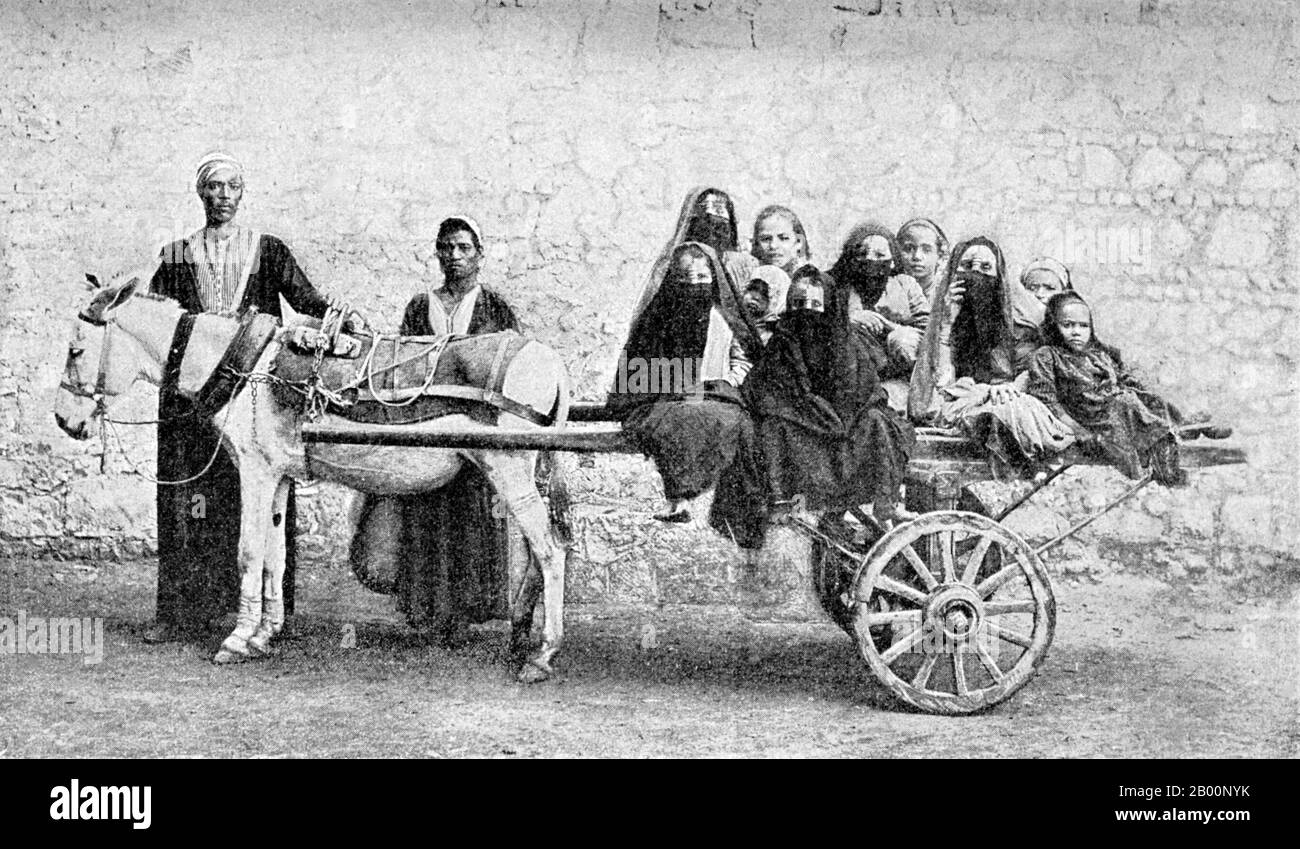 Turkey: Transporting veiled women and children by horse cart, Vlas Mikhailovich Doroshevich, c. 1900. The Ottoman Empire's power and prestige peaked in the 16th and 17th centuries, particularly during the reign of Suleiman the Magnificent. The empire was often at odds with the Holy Roman Empire in its steady advance towards Central Europe through the Balkans and the southern part of the Polish-Lithuanian Commonwealth. At sea, the empire contended with the Holy Leagues, composed of Habsburg Spain, the Republic of Venice and the Knights of St. John, for control of the Mediterranean. Stock Photohttps://www.alamy.com/image-license-details/?v=1https://www.alamy.com/turkey-transporting-veiled-women-and-children-by-horse-cart-vlas-mikhailovich-doroshevich-c-1900-the-ottoman-empires-power-and-prestige-peaked-in-the-16th-and-17th-centuries-particularly-during-the-reign-of-suleiman-the-magnificent-the-empire-was-often-at-odds-with-the-holy-roman-empire-in-its-steady-advance-towards-central-europe-through-the-balkans-and-the-southern-part-of-the-polish-lithuanian-commonwealth-at-sea-the-empire-contended-with-the-holy-leagues-composed-of-habsburg-spain-the-republic-of-venice-and-the-knights-of-st-john-for-control-of-the-mediterranean-image344224599.html
Turkey: Transporting veiled women and children by horse cart, Vlas Mikhailovich Doroshevich, c. 1900. The Ottoman Empire's power and prestige peaked in the 16th and 17th centuries, particularly during the reign of Suleiman the Magnificent. The empire was often at odds with the Holy Roman Empire in its steady advance towards Central Europe through the Balkans and the southern part of the Polish-Lithuanian Commonwealth. At sea, the empire contended with the Holy Leagues, composed of Habsburg Spain, the Republic of Venice and the Knights of St. John, for control of the Mediterranean. Stock Photohttps://www.alamy.com/image-license-details/?v=1https://www.alamy.com/turkey-transporting-veiled-women-and-children-by-horse-cart-vlas-mikhailovich-doroshevich-c-1900-the-ottoman-empires-power-and-prestige-peaked-in-the-16th-and-17th-centuries-particularly-during-the-reign-of-suleiman-the-magnificent-the-empire-was-often-at-odds-with-the-holy-roman-empire-in-its-steady-advance-towards-central-europe-through-the-balkans-and-the-southern-part-of-the-polish-lithuanian-commonwealth-at-sea-the-empire-contended-with-the-holy-leagues-composed-of-habsburg-spain-the-republic-of-venice-and-the-knights-of-st-john-for-control-of-the-mediterranean-image344224599.htmlRM2B00NYK–Turkey: Transporting veiled women and children by horse cart, Vlas Mikhailovich Doroshevich, c. 1900. The Ottoman Empire's power and prestige peaked in the 16th and 17th centuries, particularly during the reign of Suleiman the Magnificent. The empire was often at odds with the Holy Roman Empire in its steady advance towards Central Europe through the Balkans and the southern part of the Polish-Lithuanian Commonwealth. At sea, the empire contended with the Holy Leagues, composed of Habsburg Spain, the Republic of Venice and the Knights of St. John, for control of the Mediterranean.
 17th century - The Triumph of Henry IV - Pierre Paul Rubens (1630) - Metropolitan Museum of Art - New York Oil on wood Stock Photohttps://www.alamy.com/image-license-details/?v=1https://www.alamy.com/stock-photo-17th-century-the-triumph-of-henry-iv-pierre-paul-rubens-1630-metropolitan-59410099.html
17th century - The Triumph of Henry IV - Pierre Paul Rubens (1630) - Metropolitan Museum of Art - New York Oil on wood Stock Photohttps://www.alamy.com/image-license-details/?v=1https://www.alamy.com/stock-photo-17th-century-the-triumph-of-henry-iv-pierre-paul-rubens-1630-metropolitan-59410099.htmlRMDCJA57–17th century - The Triumph of Henry IV - Pierre Paul Rubens (1630) - Metropolitan Museum of Art - New York Oil on wood
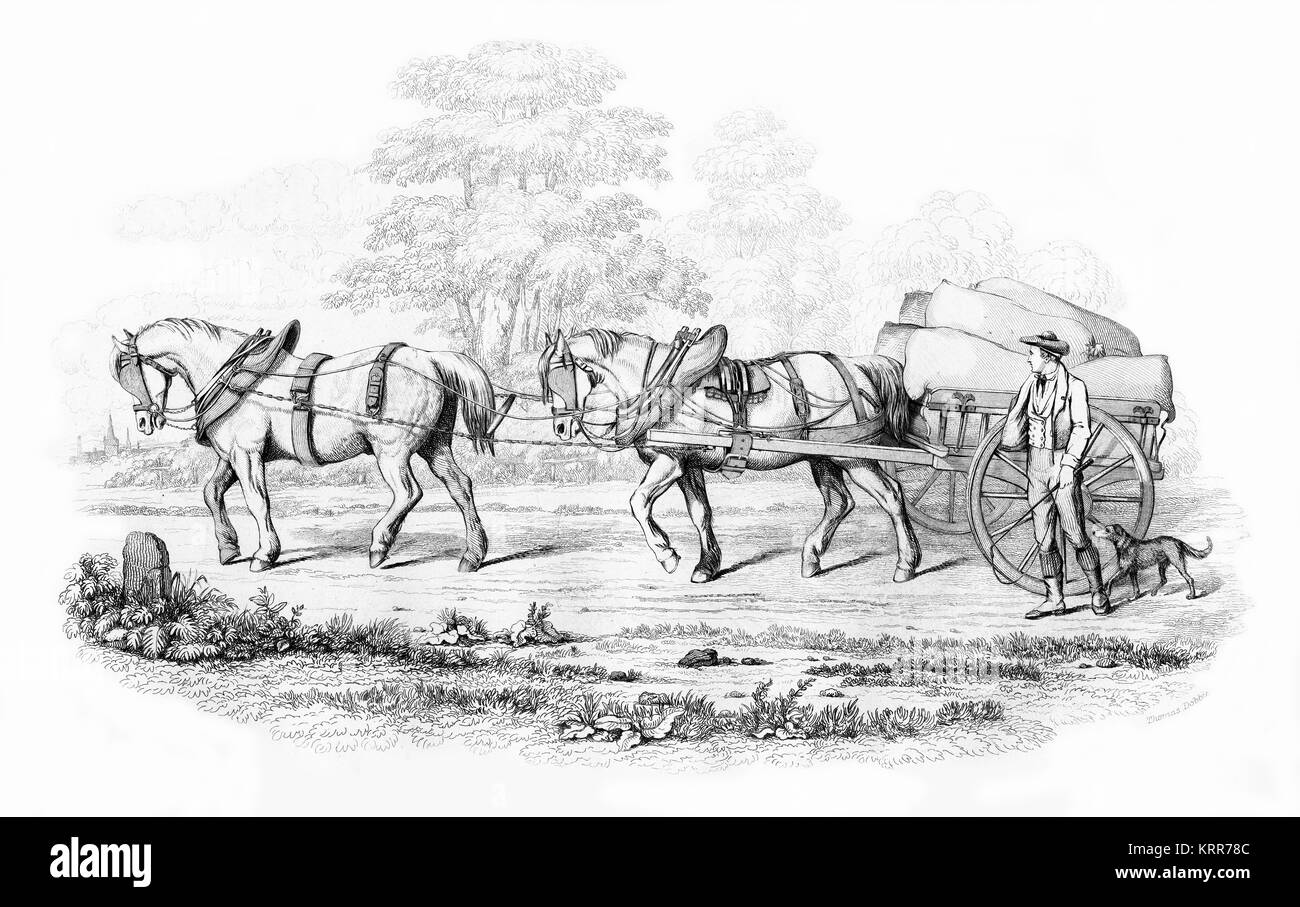 Engraving of a two horse cart, commonly used in England. From an original engraving made in the 1890s Stock Photohttps://www.alamy.com/image-license-details/?v=1https://www.alamy.com/stock-image-engraving-of-a-two-horse-cart-commonly-used-in-england-from-an-original-169541020.html
Engraving of a two horse cart, commonly used in England. From an original engraving made in the 1890s Stock Photohttps://www.alamy.com/image-license-details/?v=1https://www.alamy.com/stock-image-engraving-of-a-two-horse-cart-commonly-used-in-england-from-an-original-169541020.htmlRFKRR78C–Engraving of a two horse cart, commonly used in England. From an original engraving made in the 1890s
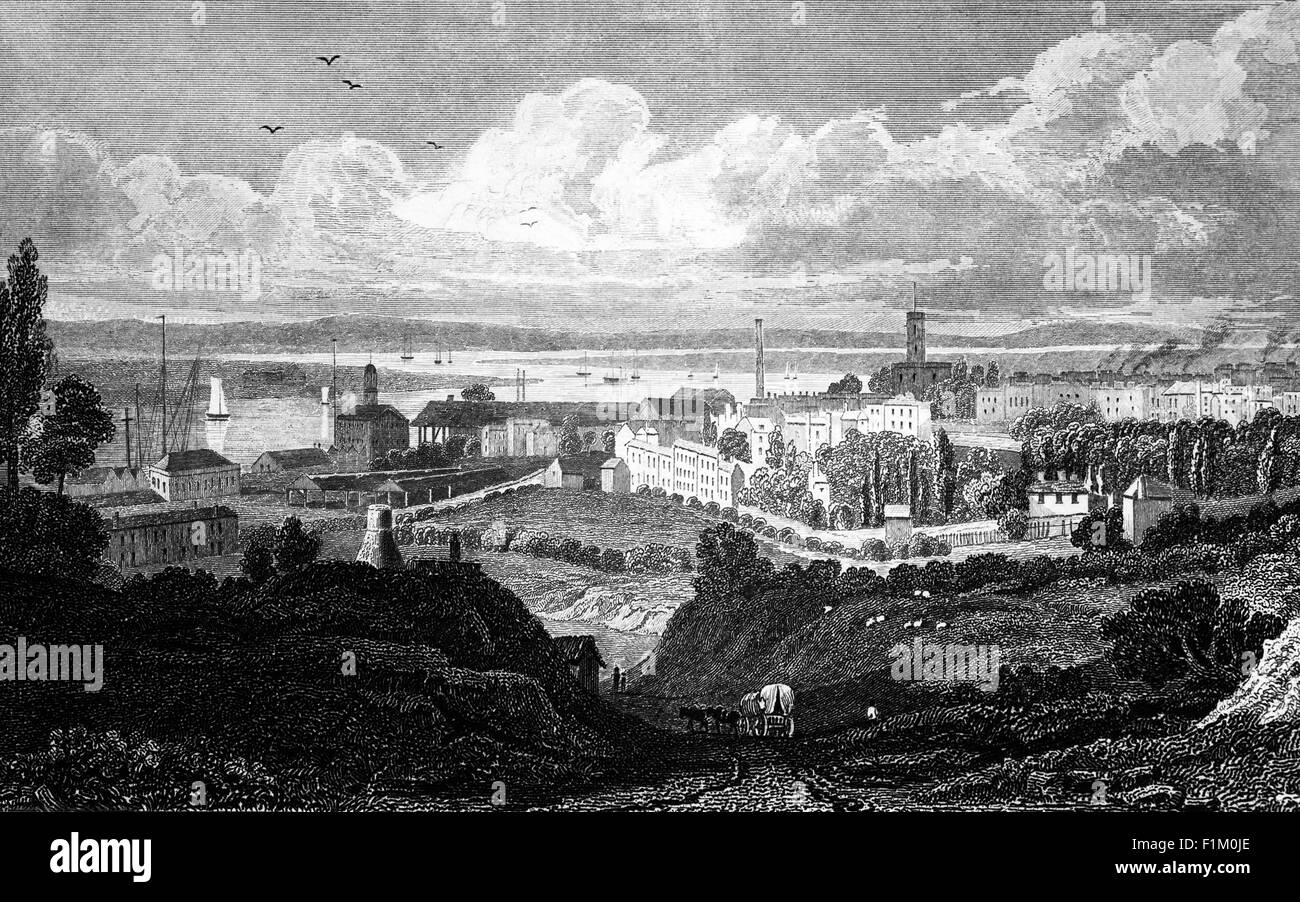 A distant 19th century view of the Royal Arsenal, Woolwich on the south bank of the River Thames in Woolwich in south-east London, England. It was originally known as the Woolwich Warren, having begun on land previously used as a domestic warren in the grounds of a Tudor house, Tower Place. Much of the initial history of the site is linked with that of the Office of Ordnance, which purchased the Warren in the late 17th century in order to expand an earlier base at Gun Wharf in Woolwich Dockyard. Over the next two centuries, the site expanded massively. Stock Photohttps://www.alamy.com/image-license-details/?v=1https://www.alamy.com/stock-photo-a-distant-19th-century-view-of-the-royal-arsenal-woolwich-on-the-south-87106054.html
A distant 19th century view of the Royal Arsenal, Woolwich on the south bank of the River Thames in Woolwich in south-east London, England. It was originally known as the Woolwich Warren, having begun on land previously used as a domestic warren in the grounds of a Tudor house, Tower Place. Much of the initial history of the site is linked with that of the Office of Ordnance, which purchased the Warren in the late 17th century in order to expand an earlier base at Gun Wharf in Woolwich Dockyard. Over the next two centuries, the site expanded massively. Stock Photohttps://www.alamy.com/image-license-details/?v=1https://www.alamy.com/stock-photo-a-distant-19th-century-view-of-the-royal-arsenal-woolwich-on-the-south-87106054.htmlRMF1M0JE–A distant 19th century view of the Royal Arsenal, Woolwich on the south bank of the River Thames in Woolwich in south-east London, England. It was originally known as the Woolwich Warren, having begun on land previously used as a domestic warren in the grounds of a Tudor house, Tower Place. Much of the initial history of the site is linked with that of the Office of Ordnance, which purchased the Warren in the late 17th century in order to expand an earlier base at Gun Wharf in Woolwich Dockyard. Over the next two centuries, the site expanded massively.
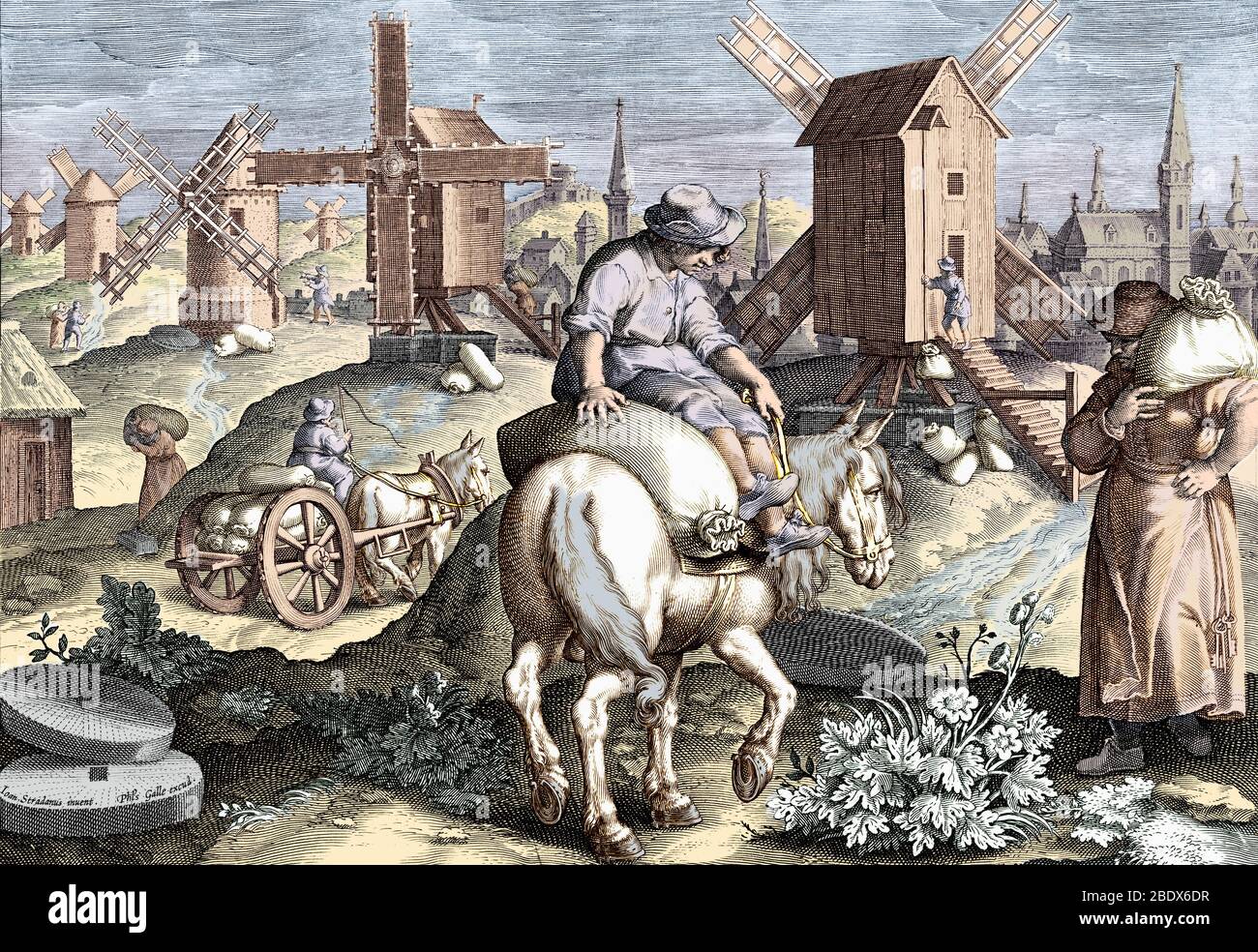 The Invention of the Windmill, Nova Reperta, 16th Century Stock Photohttps://www.alamy.com/image-license-details/?v=1https://www.alamy.com/the-invention-of-the-windmill-nova-reperta-16th-century-image352773731.html
The Invention of the Windmill, Nova Reperta, 16th Century Stock Photohttps://www.alamy.com/image-license-details/?v=1https://www.alamy.com/the-invention-of-the-windmill-nova-reperta-16th-century-image352773731.htmlRM2BDX6DR–The Invention of the Windmill, Nova Reperta, 16th Century
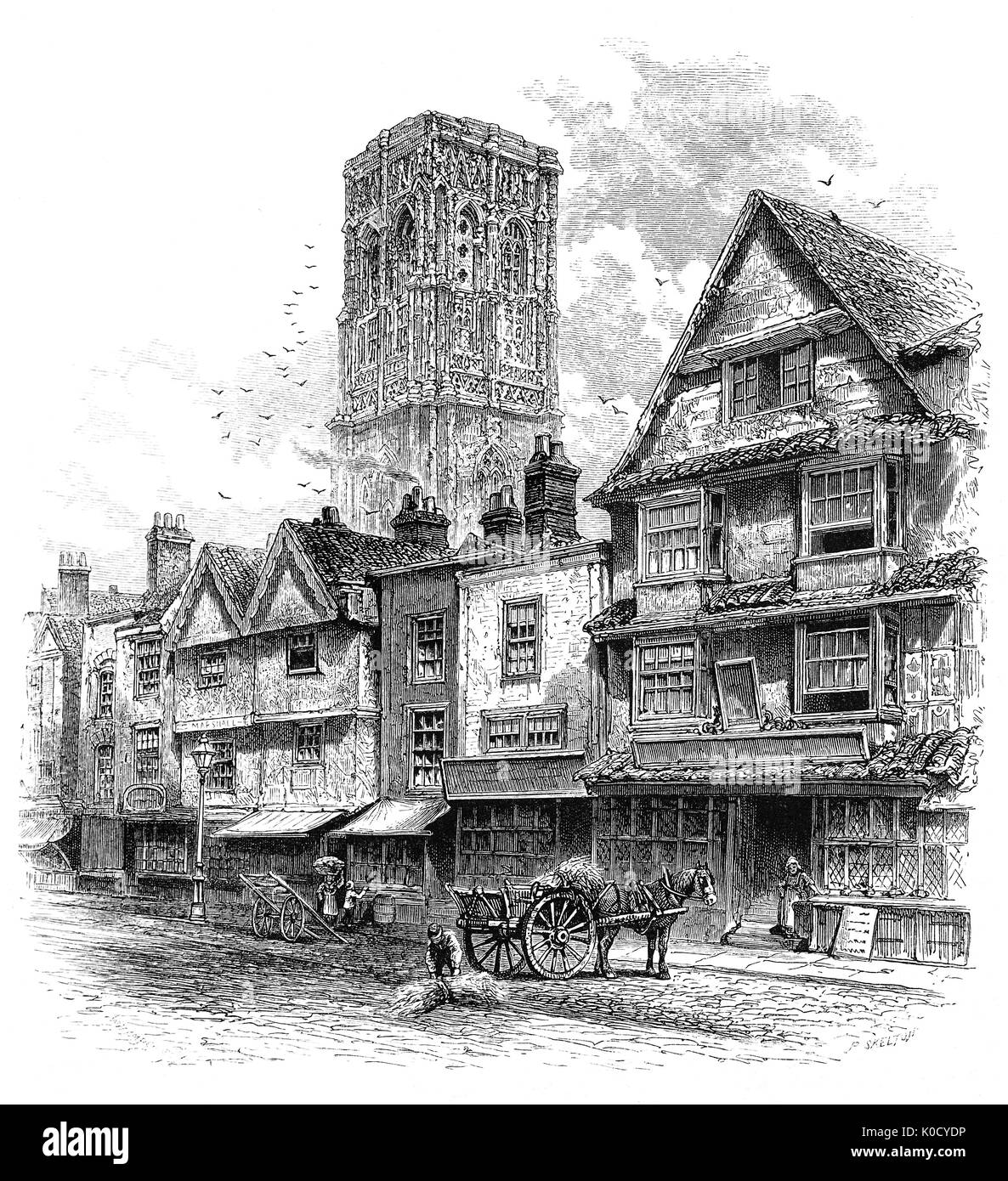 1870: A sketch of Temple Street in Bristol, virtually unchanged since the days of Queen Elizabeth I. Flemish weavers, brought to England by King Edward III settled there, and thrived until the cloth trade moved north. Stock Photohttps://www.alamy.com/image-license-details/?v=1https://www.alamy.com/1870-a-sketch-of-temple-street-in-bristol-virtually-unchanged-since-image155178290.html
1870: A sketch of Temple Street in Bristol, virtually unchanged since the days of Queen Elizabeth I. Flemish weavers, brought to England by King Edward III settled there, and thrived until the cloth trade moved north. Stock Photohttps://www.alamy.com/image-license-details/?v=1https://www.alamy.com/1870-a-sketch-of-temple-street-in-bristol-virtually-unchanged-since-image155178290.htmlRMK0CYDP–1870: A sketch of Temple Street in Bristol, virtually unchanged since the days of Queen Elizabeth I. Flemish weavers, brought to England by King Edward III settled there, and thrived until the cloth trade moved north.
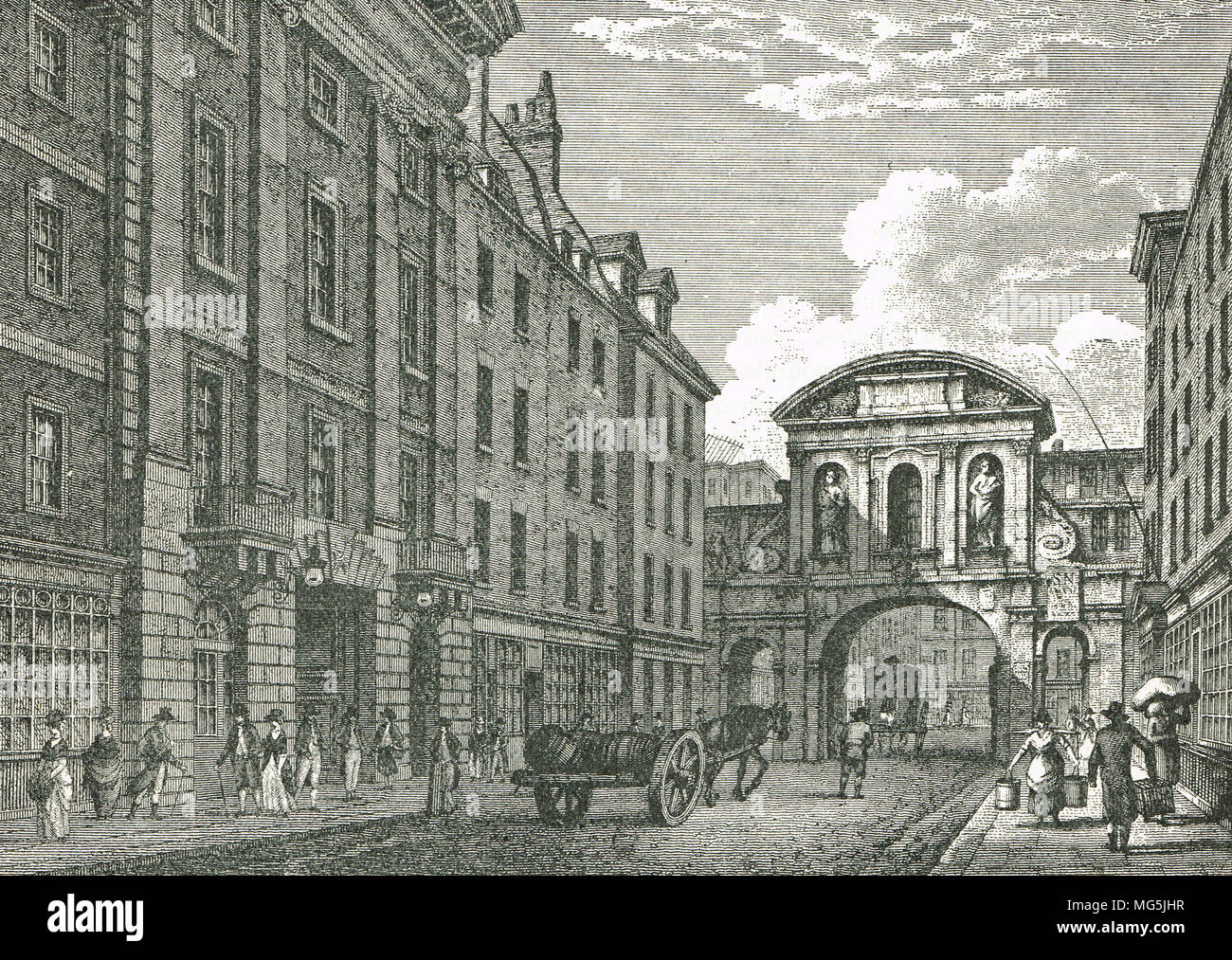 Temple Bar, London, England in 1800 Stock Photohttps://www.alamy.com/image-license-details/?v=1https://www.alamy.com/temple-bar-london-england-in-1800-image182062547.html
Temple Bar, London, England in 1800 Stock Photohttps://www.alamy.com/image-license-details/?v=1https://www.alamy.com/temple-bar-london-england-in-1800-image182062547.htmlRMMG5JHR–Temple Bar, London, England in 1800
 In 17th and 18th century Britain, several people demonstrated that coal, when heated, gave off a gas which burned with a bright flame but it was the Scottish engineer William Murdoch who first put this to practical use, lighting his house in Cornwall with it in 1792. The basic process for making gas from coal used in the early 19th century remained essentially unchanged and was created in a gas factory, starting with the delivery of coal. Stock Photohttps://www.alamy.com/image-license-details/?v=1https://www.alamy.com/in-17th-and-18th-century-britain-several-people-demonstrated-that-coal-when-heated-gave-off-a-gas-which-burned-with-a-bright-flame-but-it-was-the-scottish-engineer-william-murdoch-who-first-put-this-to-practical-use-lighting-his-house-in-cornwall-with-it-in-1792-the-basic-process-for-making-gas-from-coal-used-in-the-early-19th-century-remained-essentially-unchanged-and-was-created-in-a-gas-factory-starting-with-the-delivery-of-coal-image235305735.html
In 17th and 18th century Britain, several people demonstrated that coal, when heated, gave off a gas which burned with a bright flame but it was the Scottish engineer William Murdoch who first put this to practical use, lighting his house in Cornwall with it in 1792. The basic process for making gas from coal used in the early 19th century remained essentially unchanged and was created in a gas factory, starting with the delivery of coal. Stock Photohttps://www.alamy.com/image-license-details/?v=1https://www.alamy.com/in-17th-and-18th-century-britain-several-people-demonstrated-that-coal-when-heated-gave-off-a-gas-which-burned-with-a-bright-flame-but-it-was-the-scottish-engineer-william-murdoch-who-first-put-this-to-practical-use-lighting-his-house-in-cornwall-with-it-in-1792-the-basic-process-for-making-gas-from-coal-used-in-the-early-19th-century-remained-essentially-unchanged-and-was-created-in-a-gas-factory-starting-with-the-delivery-of-coal-image235305735.htmlRMRJR2T7–In 17th and 18th century Britain, several people demonstrated that coal, when heated, gave off a gas which burned with a bright flame but it was the Scottish engineer William Murdoch who first put this to practical use, lighting his house in Cornwall with it in 1792. The basic process for making gas from coal used in the early 19th century remained essentially unchanged and was created in a gas factory, starting with the delivery of coal.
 Lord Ganesh Ganpati riding on Rat Mouse Mushika. 17th century wooden carvings in Meenakashi Sundareswarer temple's chariot at Madurai, Tamil Nadu Stock Photohttps://www.alamy.com/image-license-details/?v=1https://www.alamy.com/lord-ganesh-ganpati-riding-on-rat-mouse-mushika-17th-century-wooden-carvings-in-meenakashi-sundareswarer-temples-chariot-at-madurai-tamil-nadu-image543359297.html
Lord Ganesh Ganpati riding on Rat Mouse Mushika. 17th century wooden carvings in Meenakashi Sundareswarer temple's chariot at Madurai, Tamil Nadu Stock Photohttps://www.alamy.com/image-license-details/?v=1https://www.alamy.com/lord-ganesh-ganpati-riding-on-rat-mouse-mushika-17th-century-wooden-carvings-in-meenakashi-sundareswarer-temples-chariot-at-madurai-tamil-nadu-image543359297.htmlRF2PG0495–Lord Ganesh Ganpati riding on Rat Mouse Mushika. 17th century wooden carvings in Meenakashi Sundareswarer temple's chariot at Madurai, Tamil Nadu
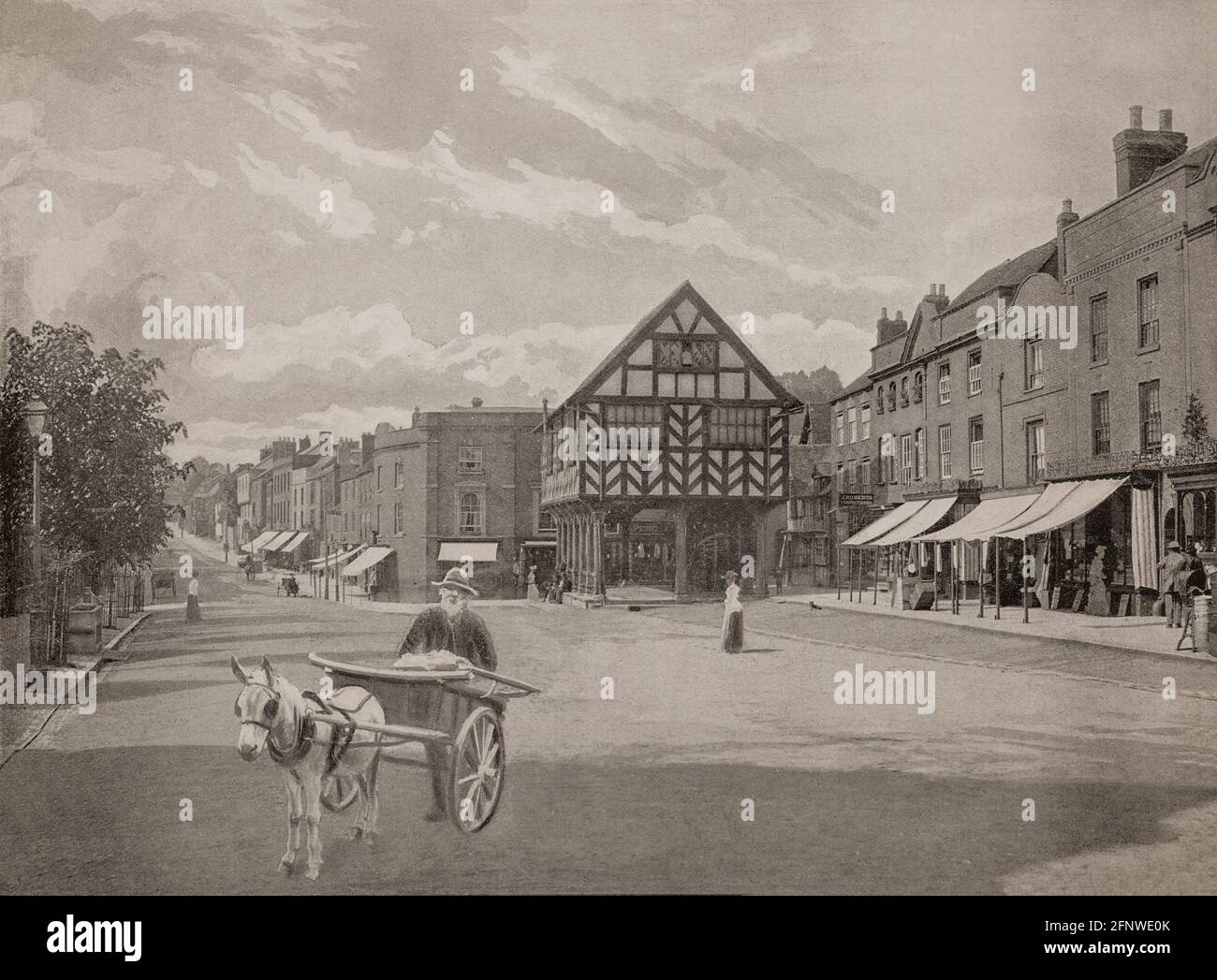 A late 19th Century view of the old Market House dating from 1617 and the Market Place in Ledbury, a market town in the county of Herefordshire, England. It was home to poet Elizabeth Barrett Browning, who spent her childhood at Hope End, and also the birthplace of poet laureate John Masefield. Stock Photohttps://www.alamy.com/image-license-details/?v=1https://www.alamy.com/a-late-19th-century-view-of-the-old-market-house-dating-from-1617-and-the-market-place-in-ledbury-a-market-town-in-the-county-of-herefordshire-england-it-was-home-to-poet-elizabeth-barrett-browning-who-spent-her-childhood-at-hope-end-and-also-the-birthplace-of-poet-laureate-john-masefield-image426516403.html
A late 19th Century view of the old Market House dating from 1617 and the Market Place in Ledbury, a market town in the county of Herefordshire, England. It was home to poet Elizabeth Barrett Browning, who spent her childhood at Hope End, and also the birthplace of poet laureate John Masefield. Stock Photohttps://www.alamy.com/image-license-details/?v=1https://www.alamy.com/a-late-19th-century-view-of-the-old-market-house-dating-from-1617-and-the-market-place-in-ledbury-a-market-town-in-the-county-of-herefordshire-england-it-was-home-to-poet-elizabeth-barrett-browning-who-spent-her-childhood-at-hope-end-and-also-the-birthplace-of-poet-laureate-john-masefield-image426516403.htmlRM2FNWE0K–A late 19th Century view of the old Market House dating from 1617 and the Market Place in Ledbury, a market town in the county of Herefordshire, England. It was home to poet Elizabeth Barrett Browning, who spent her childhood at Hope End, and also the birthplace of poet laureate John Masefield.
 Victims of the black plague, being buried in London, 1665. Woodcut: 1834. Stock Photohttps://www.alamy.com/image-license-details/?v=1https://www.alamy.com/stock-photo-victims-of-the-black-plague-being-buried-in-london-1665-woodcut-1834-50027598.html
Victims of the black plague, being buried in London, 1665. Woodcut: 1834. Stock Photohttps://www.alamy.com/image-license-details/?v=1https://www.alamy.com/stock-photo-victims-of-the-black-plague-being-buried-in-london-1665-woodcut-1834-50027598.htmlRMCWAXKX–Victims of the black plague, being buried in London, 1665. Woodcut: 1834.
 Horse riders, soldiers killing tiger. 17th century wooden carvings in Meenakashi Sundareswarer temple's chariot at Madurai, Tamil Nadu, South India Stock Photohttps://www.alamy.com/image-license-details/?v=1https://www.alamy.com/horse-riders-soldiers-killing-tiger-17th-century-wooden-carvings-in-meenakashi-sundareswarer-temples-chariot-at-madurai-tamil-nadu-south-india-image543359358.html
Horse riders, soldiers killing tiger. 17th century wooden carvings in Meenakashi Sundareswarer temple's chariot at Madurai, Tamil Nadu, South India Stock Photohttps://www.alamy.com/image-license-details/?v=1https://www.alamy.com/horse-riders-soldiers-killing-tiger-17th-century-wooden-carvings-in-meenakashi-sundareswarer-temples-chariot-at-madurai-tamil-nadu-south-india-image543359358.htmlRF2PG04BA–Horse riders, soldiers killing tiger. 17th century wooden carvings in Meenakashi Sundareswarer temple's chariot at Madurai, Tamil Nadu, South India
!['This 17th century engraving shows the ''Electoral Residence City of Berlin and Cölln [Alt-Kölln]'' with the city wall and the various churches. [automated translation]' Stock Photo 'This 17th century engraving shows the ''Electoral Residence City of Berlin and Cölln [Alt-Kölln]'' with the city wall and the various churches. [automated translation]' Stock Photo](https://c8.alamy.com/comp/2GY4PTD/this-17th-century-engraving-shows-the-electoral-residence-city-of-berlin-and-clln-alt-klln-with-the-city-wall-and-the-various-churches-automated-translation-2GY4PTD.jpg) 'This 17th century engraving shows the ''Electoral Residence City of Berlin and Cölln [Alt-Kölln]'' with the city wall and the various churches. [automated translation]' Stock Photohttps://www.alamy.com/image-license-details/?v=1https://www.alamy.com/this-17th-century-engraving-shows-the-electoral-residence-city-of-berlin-and-clln-alt-klln-with-the-city-wall-and-the-various-churches-automated-translation-image446960653.html
'This 17th century engraving shows the ''Electoral Residence City of Berlin and Cölln [Alt-Kölln]'' with the city wall and the various churches. [automated translation]' Stock Photohttps://www.alamy.com/image-license-details/?v=1https://www.alamy.com/this-17th-century-engraving-shows-the-electoral-residence-city-of-berlin-and-clln-alt-klln-with-the-city-wall-and-the-various-churches-automated-translation-image446960653.htmlRM2GY4PTD–'This 17th century engraving shows the ''Electoral Residence City of Berlin and Cölln [Alt-Kölln]'' with the city wall and the various churches. [automated translation]'
 A late 19th century view of the Treaty Stone located on the Clare end of Thomond Bridge crossing the River Shannon in Limerick City, Ireland. According to tradition the Treaty of Limerick was signed on the stone after the 1691 war between William of Orange and James II. The stone has rested on a pedestal erected in May 1865 by John Richard Tinsley, mayor of the city. Stock Photohttps://www.alamy.com/image-license-details/?v=1https://www.alamy.com/a-late-19th-century-view-of-the-treaty-stone-located-on-the-clare-end-of-thomond-bridge-crossing-the-river-shannon-in-limerick-city-ireland-according-to-tradition-the-treaty-of-limerick-was-signed-on-the-stone-after-the-1691-war-between-william-of-orange-and-james-ii-the-stone-has-rested-on-a-pedestal-erected-in-may-1865-by-john-richard-tinsley-mayor-of-the-city-image438819872.html
A late 19th century view of the Treaty Stone located on the Clare end of Thomond Bridge crossing the River Shannon in Limerick City, Ireland. According to tradition the Treaty of Limerick was signed on the stone after the 1691 war between William of Orange and James II. The stone has rested on a pedestal erected in May 1865 by John Richard Tinsley, mayor of the city. Stock Photohttps://www.alamy.com/image-license-details/?v=1https://www.alamy.com/a-late-19th-century-view-of-the-treaty-stone-located-on-the-clare-end-of-thomond-bridge-crossing-the-river-shannon-in-limerick-city-ireland-according-to-tradition-the-treaty-of-limerick-was-signed-on-the-stone-after-the-1691-war-between-william-of-orange-and-james-ii-the-stone-has-rested-on-a-pedestal-erected-in-may-1865-by-john-richard-tinsley-mayor-of-the-city-image438819872.htmlRM2GDWY68–A late 19th century view of the Treaty Stone located on the Clare end of Thomond Bridge crossing the River Shannon in Limerick City, Ireland. According to tradition the Treaty of Limerick was signed on the stone after the 1691 war between William of Orange and James II. The stone has rested on a pedestal erected in May 1865 by John Richard Tinsley, mayor of the city.
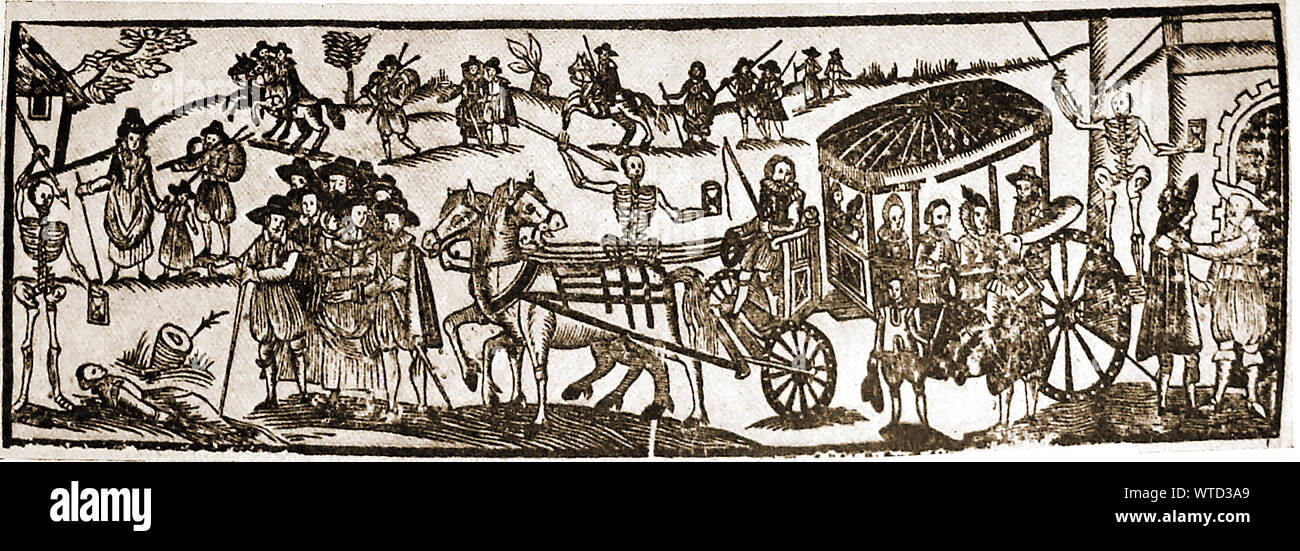 17th century medicine in Britain - a 1630 illustration showing rich and poor alike fleeing from outbreaks of the plague, walking,riding and by coach. Skeletons are around them signifying the disease and one pulls the bell ringer on a mansion or castle gate (right), whilst a woman lies dead on the road (left). In the centre a skelton holds sands of time . Stock Photohttps://www.alamy.com/image-license-details/?v=1https://www.alamy.com/17th-century-medicine-in-britain-a-1630-illustration-showing-rich-and-poor-alike-fleeing-from-outbreaks-of-the-plague-walkingriding-and-by-coach-skeletons-are-around-them-signifying-the-disease-and-one-pulls-the-bell-ringer-on-a-mansion-or-castle-gate-right-whilst-a-woman-lies-dead-on-the-road-left-in-the-centre-a-skelton-holds-sands-of-time-image273195281.html
17th century medicine in Britain - a 1630 illustration showing rich and poor alike fleeing from outbreaks of the plague, walking,riding and by coach. Skeletons are around them signifying the disease and one pulls the bell ringer on a mansion or castle gate (right), whilst a woman lies dead on the road (left). In the centre a skelton holds sands of time . Stock Photohttps://www.alamy.com/image-license-details/?v=1https://www.alamy.com/17th-century-medicine-in-britain-a-1630-illustration-showing-rich-and-poor-alike-fleeing-from-outbreaks-of-the-plague-walkingriding-and-by-coach-skeletons-are-around-them-signifying-the-disease-and-one-pulls-the-bell-ringer-on-a-mansion-or-castle-gate-right-whilst-a-woman-lies-dead-on-the-road-left-in-the-centre-a-skelton-holds-sands-of-time-image273195281.htmlRMWTD3A9–17th century medicine in Britain - a 1630 illustration showing rich and poor alike fleeing from outbreaks of the plague, walking,riding and by coach. Skeletons are around them signifying the disease and one pulls the bell ringer on a mansion or castle gate (right), whilst a woman lies dead on the road (left). In the centre a skelton holds sands of time .
 The Great Plague of 1665, (c1850). Artist: Unknown Stock Photohttps://www.alamy.com/image-license-details/?v=1https://www.alamy.com/stock-photo-the-great-plague-of-1665-c1850-artist-unknown-11063126.html
The Great Plague of 1665, (c1850). Artist: Unknown Stock Photohttps://www.alamy.com/image-license-details/?v=1https://www.alamy.com/stock-photo-the-great-plague-of-1665-c1850-artist-unknown-11063126.htmlRMA4JGHY–The Great Plague of 1665, (c1850). Artist: Unknown
 Italian Landscape with an Ox-cart. Date/Period: Mid-17th century. Painting. Oil on canvas Oil. Height: 491 mm (19.33 in); Width: 408 mm (16.06 in). Author: Attributed to Both, Jan. Jan Both. Stock Photohttps://www.alamy.com/image-license-details/?v=1https://www.alamy.com/italian-landscape-with-an-ox-cart-dateperiod-mid-17th-century-painting-oil-on-canvas-oil-height-491-mm-1933-in-width-408-mm-1606-in-author-attributed-to-both-jan-jan-both-image219729315.html
Italian Landscape with an Ox-cart. Date/Period: Mid-17th century. Painting. Oil on canvas Oil. Height: 491 mm (19.33 in); Width: 408 mm (16.06 in). Author: Attributed to Both, Jan. Jan Both. Stock Photohttps://www.alamy.com/image-license-details/?v=1https://www.alamy.com/italian-landscape-with-an-ox-cart-dateperiod-mid-17th-century-painting-oil-on-canvas-oil-height-491-mm-1933-in-width-408-mm-1606-in-author-attributed-to-both-jan-jan-both-image219729315.htmlRMPNDEYF–Italian Landscape with an Ox-cart. Date/Period: Mid-17th century. Painting. Oil on canvas Oil. Height: 491 mm (19.33 in); Width: 408 mm (16.06 in). Author: Attributed to Both, Jan. Jan Both.
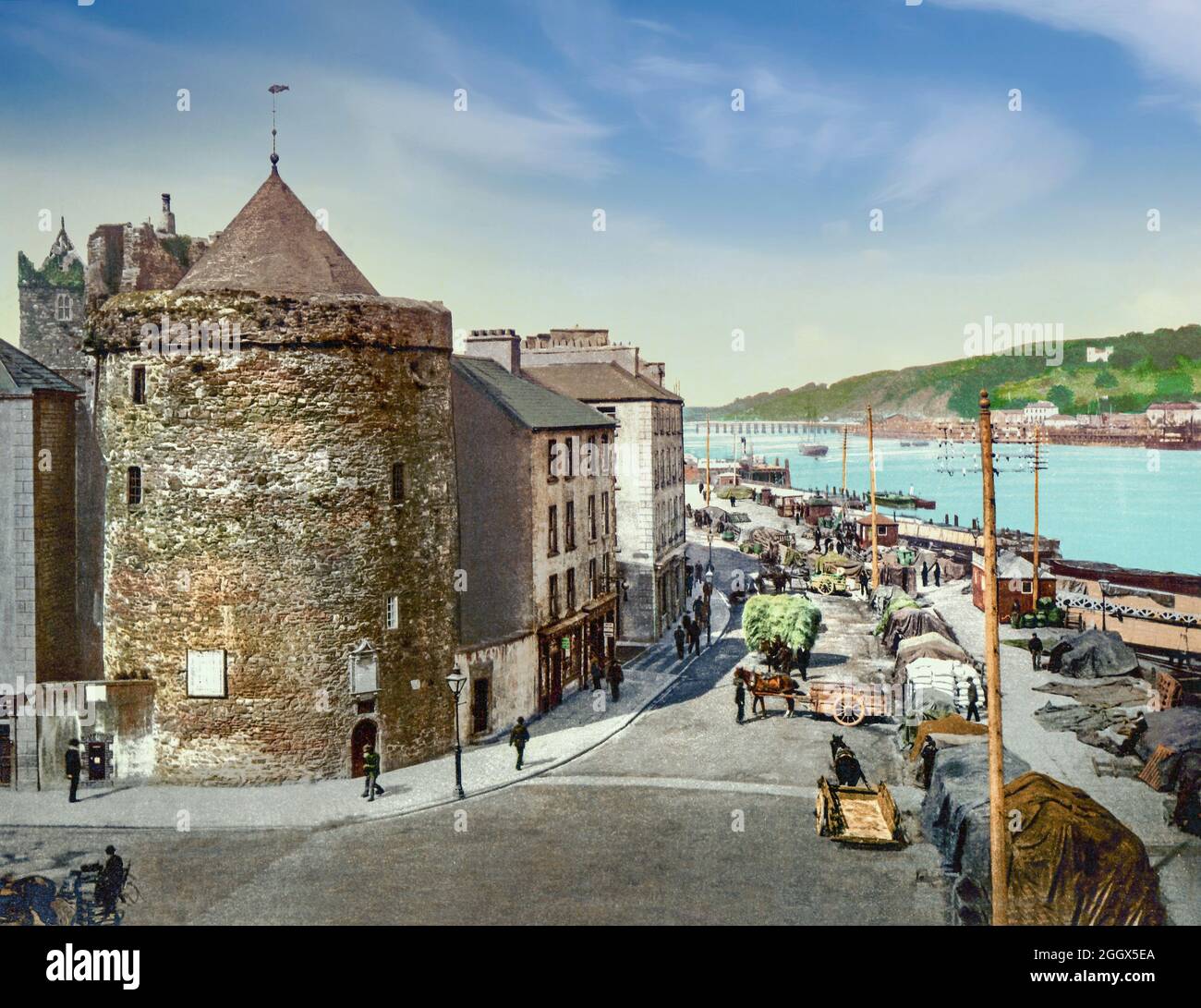 An early 20th century view of the south quays along the River Suir as it flows through Waterford, the oldest city in the Republic of Ireland. To the left is Reginald's Tower, built by the Anglo-Normans after their conquest of Waterford, it replaced an earlier Viking fortification in the 13th century. During the 17th and 18th centuries the Tower was used as a munitions store and in the early 19th century it became the residence of the Chief Constable of Waterford. Stock Photohttps://www.alamy.com/image-license-details/?v=1https://www.alamy.com/an-early-20th-century-view-of-the-south-quays-along-the-river-suir-as-it-flows-through-waterford-the-oldest-city-in-the-republic-of-ireland-to-the-left-is-reginalds-tower-built-by-the-anglo-normans-after-their-conquest-of-waterford-it-replaced-an-earlier-viking-fortification-in-the-13th-century-during-the-17th-and-18th-centuries-the-tower-was-used-as-a-munitions-store-and-in-the-early-19th-century-it-became-the-residence-of-the-chief-constable-of-waterford-image440668770.html
An early 20th century view of the south quays along the River Suir as it flows through Waterford, the oldest city in the Republic of Ireland. To the left is Reginald's Tower, built by the Anglo-Normans after their conquest of Waterford, it replaced an earlier Viking fortification in the 13th century. During the 17th and 18th centuries the Tower was used as a munitions store and in the early 19th century it became the residence of the Chief Constable of Waterford. Stock Photohttps://www.alamy.com/image-license-details/?v=1https://www.alamy.com/an-early-20th-century-view-of-the-south-quays-along-the-river-suir-as-it-flows-through-waterford-the-oldest-city-in-the-republic-of-ireland-to-the-left-is-reginalds-tower-built-by-the-anglo-normans-after-their-conquest-of-waterford-it-replaced-an-earlier-viking-fortification-in-the-13th-century-during-the-17th-and-18th-centuries-the-tower-was-used-as-a-munitions-store-and-in-the-early-19th-century-it-became-the-residence-of-the-chief-constable-of-waterford-image440668770.htmlRM2GGX5EA–An early 20th century view of the south quays along the River Suir as it flows through Waterford, the oldest city in the Republic of Ireland. To the left is Reginald's Tower, built by the Anglo-Normans after their conquest of Waterford, it replaced an earlier Viking fortification in the 13th century. During the 17th and 18th centuries the Tower was used as a munitions store and in the early 19th century it became the residence of the Chief Constable of Waterford.
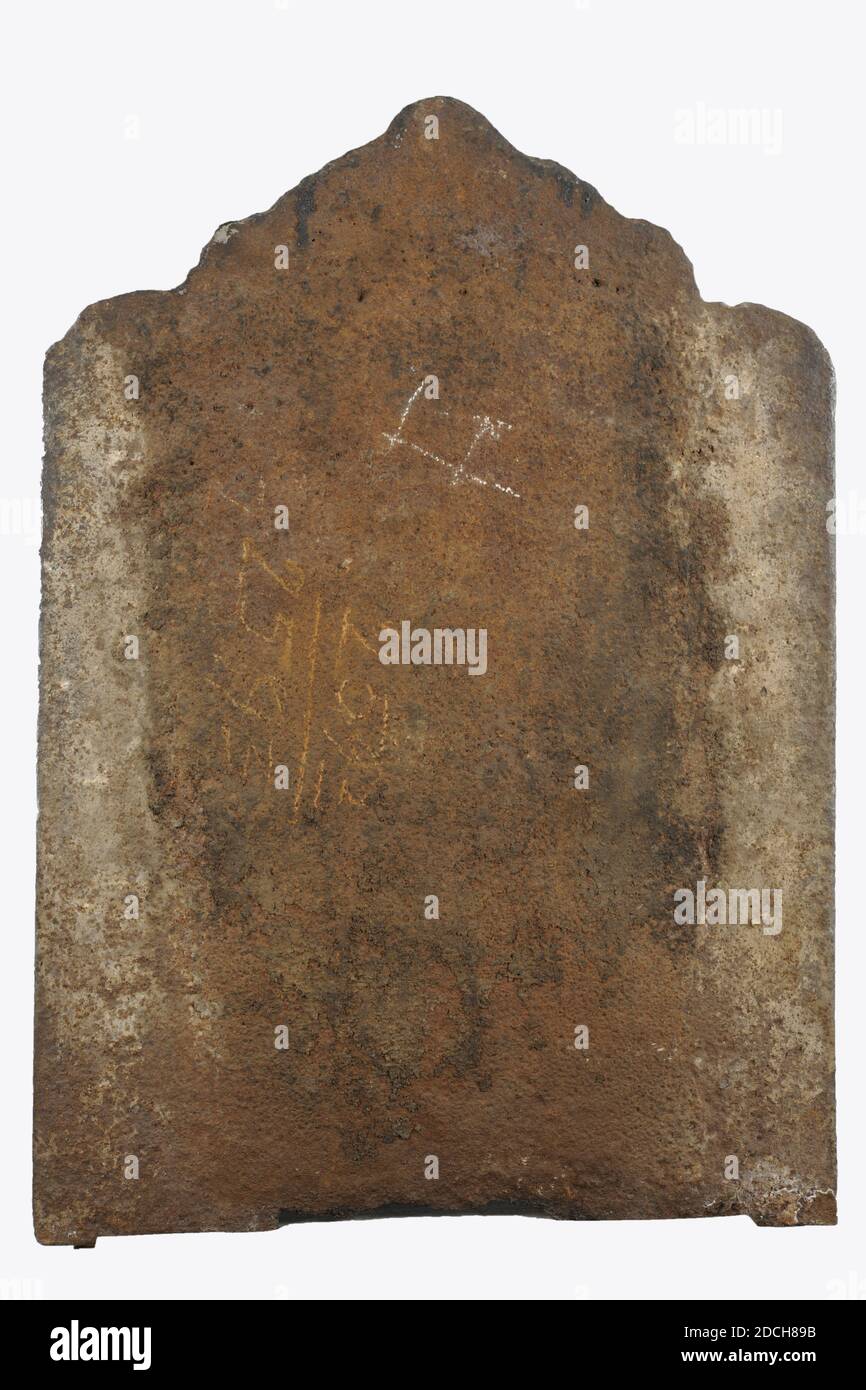 fireback, Anonymous, second half 17th century, cast, General: 97 x 69 x 1.7cm 970 x 690 x 17mm, horse, angel, man, wagon, Iron fireback depicting Admiral M.Hz. Trumpet on the waters on a victory cart. He holds a trident in one hand and the reins in the other. The carriage is pulled by horses. Two angels can be seen on the left and right. At the top right, a trumpet angel floats, with two more angels on the left. There is a flag on the trumpet that says EER EN LOF ZY TROMP. The performance is framed by a pearl rim. Around it is a frame with flowers and fruits. The hob is rectangular, with a Stock Photohttps://www.alamy.com/image-license-details/?v=1https://www.alamy.com/fireback-anonymous-second-half-17th-century-cast-general-97-x-69-x-17cm-970-x-690-x-17mm-horse-angel-man-wagon-iron-fireback-depicting-admiral-mhz-trumpet-on-the-waters-on-a-victory-cart-he-holds-a-trident-in-one-hand-and-the-reins-in-the-other-the-carriage-is-pulled-by-horses-two-angels-can-be-seen-on-the-left-and-right-at-the-top-right-a-trumpet-angel-floats-with-two-more-angels-on-the-left-there-is-a-flag-on-the-trumpet-that-says-eer-en-lof-zy-tromp-the-performance-is-framed-by-a-pearl-rim-around-it-is-a-frame-with-flowers-and-fruits-the-hob-is-rectangular-with-a-image386383687.html
fireback, Anonymous, second half 17th century, cast, General: 97 x 69 x 1.7cm 970 x 690 x 17mm, horse, angel, man, wagon, Iron fireback depicting Admiral M.Hz. Trumpet on the waters on a victory cart. He holds a trident in one hand and the reins in the other. The carriage is pulled by horses. Two angels can be seen on the left and right. At the top right, a trumpet angel floats, with two more angels on the left. There is a flag on the trumpet that says EER EN LOF ZY TROMP. The performance is framed by a pearl rim. Around it is a frame with flowers and fruits. The hob is rectangular, with a Stock Photohttps://www.alamy.com/image-license-details/?v=1https://www.alamy.com/fireback-anonymous-second-half-17th-century-cast-general-97-x-69-x-17cm-970-x-690-x-17mm-horse-angel-man-wagon-iron-fireback-depicting-admiral-mhz-trumpet-on-the-waters-on-a-victory-cart-he-holds-a-trident-in-one-hand-and-the-reins-in-the-other-the-carriage-is-pulled-by-horses-two-angels-can-be-seen-on-the-left-and-right-at-the-top-right-a-trumpet-angel-floats-with-two-more-angels-on-the-left-there-is-a-flag-on-the-trumpet-that-says-eer-en-lof-zy-tromp-the-performance-is-framed-by-a-pearl-rim-around-it-is-a-frame-with-flowers-and-fruits-the-hob-is-rectangular-with-a-image386383687.htmlRM2DCH89B–fireback, Anonymous, second half 17th century, cast, General: 97 x 69 x 1.7cm 970 x 690 x 17mm, horse, angel, man, wagon, Iron fireback depicting Admiral M.Hz. Trumpet on the waters on a victory cart. He holds a trident in one hand and the reins in the other. The carriage is pulled by horses. Two angels can be seen on the left and right. At the top right, a trumpet angel floats, with two more angels on the left. There is a flag on the trumpet that says EER EN LOF ZY TROMP. The performance is framed by a pearl rim. Around it is a frame with flowers and fruits. The hob is rectangular, with a
 Siva standing with Rishaba Dwarabala standing, Laxmi Narayana, Laxmi seated on the lap of Vishnu. 17th century wooden carvings in Meenakashi Stock Photohttps://www.alamy.com/image-license-details/?v=1https://www.alamy.com/siva-standing-with-rishaba-dwarabala-standing-laxmi-narayana-laxmi-seated-on-the-lap-of-vishnu-17th-century-wooden-carvings-in-meenakashi-image543359469.html
Siva standing with Rishaba Dwarabala standing, Laxmi Narayana, Laxmi seated on the lap of Vishnu. 17th century wooden carvings in Meenakashi Stock Photohttps://www.alamy.com/image-license-details/?v=1https://www.alamy.com/siva-standing-with-rishaba-dwarabala-standing-laxmi-narayana-laxmi-seated-on-the-lap-of-vishnu-17th-century-wooden-carvings-in-meenakashi-image543359469.htmlRF2PG04F9–Siva standing with Rishaba Dwarabala standing, Laxmi Narayana, Laxmi seated on the lap of Vishnu. 17th century wooden carvings in Meenakashi
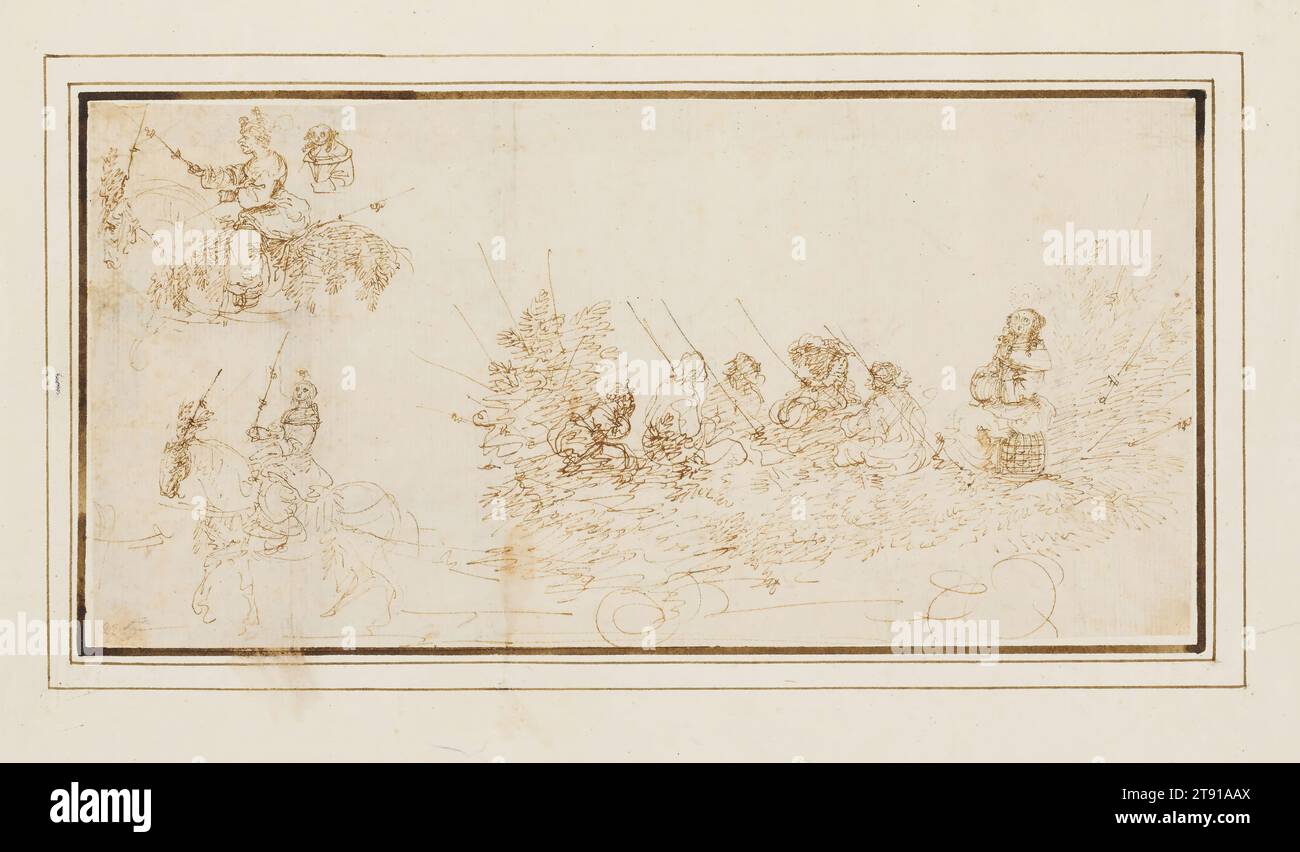 A Horse-Drawn Festival Cart with Studies of a Horseman and a Masquerader, 17th century, Stefano della Bella, Italian (Florence), Italian (Florence), 1610–1664, 4 9/16 x 9 7/16 in. (11.59 x 23.97 cm) (sheet)19 3/4 x 23 3/4 in. (50.17 x 60.33 cm) (outer frame), Pen and brown ink on laid paper, Italy, 17th century Stock Photohttps://www.alamy.com/image-license-details/?v=1https://www.alamy.com/a-horse-drawn-festival-cart-with-studies-of-a-horseman-and-a-masquerader-17th-century-stefano-della-bella-italian-florence-italian-florence-16101664-4-916-x-9-716-in-1159-x-2397-cm-sheet19-34-x-23-34-in-5017-x-6033-cm-outer-frame-pen-and-brown-ink-on-laid-paper-italy-17th-century-image573504146.html
A Horse-Drawn Festival Cart with Studies of a Horseman and a Masquerader, 17th century, Stefano della Bella, Italian (Florence), Italian (Florence), 1610–1664, 4 9/16 x 9 7/16 in. (11.59 x 23.97 cm) (sheet)19 3/4 x 23 3/4 in. (50.17 x 60.33 cm) (outer frame), Pen and brown ink on laid paper, Italy, 17th century Stock Photohttps://www.alamy.com/image-license-details/?v=1https://www.alamy.com/a-horse-drawn-festival-cart-with-studies-of-a-horseman-and-a-masquerader-17th-century-stefano-della-bella-italian-florence-italian-florence-16101664-4-916-x-9-716-in-1159-x-2397-cm-sheet19-34-x-23-34-in-5017-x-6033-cm-outer-frame-pen-and-brown-ink-on-laid-paper-italy-17th-century-image573504146.htmlRM2T91AAX–A Horse-Drawn Festival Cart with Studies of a Horseman and a Masquerader, 17th century, Stefano della Bella, Italian (Florence), Italian (Florence), 1610–1664, 4 9/16 x 9 7/16 in. (11.59 x 23.97 cm) (sheet)19 3/4 x 23 3/4 in. (50.17 x 60.33 cm) (outer frame), Pen and brown ink on laid paper, Italy, 17th century
 St Mary-le-Bow is a historic church rebuilt after the Great Fire of 1666 by Sir Christopher Wren in the City of London on the main east–west thoroughfare, Cheapside. According to tradition a true Cockney must be born within earshot of the sound of Bow Bells. Stock Photohttps://www.alamy.com/image-license-details/?v=1https://www.alamy.com/st-mary-le-bow-is-a-historic-church-rebuilt-after-the-great-fire-of-1666-by-sir-christopher-wren-in-the-city-of-london-on-the-main-eastwest-thoroughfare-cheapside-according-to-tradition-a-true-cockney-must-be-born-within-earshot-of-the-sound-of-bow-bells-image227946102.html
St Mary-le-Bow is a historic church rebuilt after the Great Fire of 1666 by Sir Christopher Wren in the City of London on the main east–west thoroughfare, Cheapside. According to tradition a true Cockney must be born within earshot of the sound of Bow Bells. Stock Photohttps://www.alamy.com/image-license-details/?v=1https://www.alamy.com/st-mary-le-bow-is-a-historic-church-rebuilt-after-the-great-fire-of-1666-by-sir-christopher-wren-in-the-city-of-london-on-the-main-eastwest-thoroughfare-cheapside-according-to-tradition-a-true-cockney-must-be-born-within-earshot-of-the-sound-of-bow-bells-image227946102.htmlRMR6RRG6–St Mary-le-Bow is a historic church rebuilt after the Great Fire of 1666 by Sir Christopher Wren in the City of London on the main east–west thoroughfare, Cheapside. According to tradition a true Cockney must be born within earshot of the sound of Bow Bells.
 1676 A company of strolling players or jongleurs arriving in London ready to replace those on the stage at Smithfield Market (Seen behind them) Stock Photohttps://www.alamy.com/image-license-details/?v=1https://www.alamy.com/1676-a-company-of-strolling-players-or-jongleurs-arriving-in-london-ready-to-replace-those-on-the-stage-at-smithfield-market-seen-behind-them-image262336681.html
1676 A company of strolling players or jongleurs arriving in London ready to replace those on the stage at Smithfield Market (Seen behind them) Stock Photohttps://www.alamy.com/image-license-details/?v=1https://www.alamy.com/1676-a-company-of-strolling-players-or-jongleurs-arriving-in-london-ready-to-replace-those-on-the-stage-at-smithfield-market-seen-behind-them-image262336681.htmlRMW6PD35–1676 A company of strolling players or jongleurs arriving in London ready to replace those on the stage at Smithfield Market (Seen behind them)
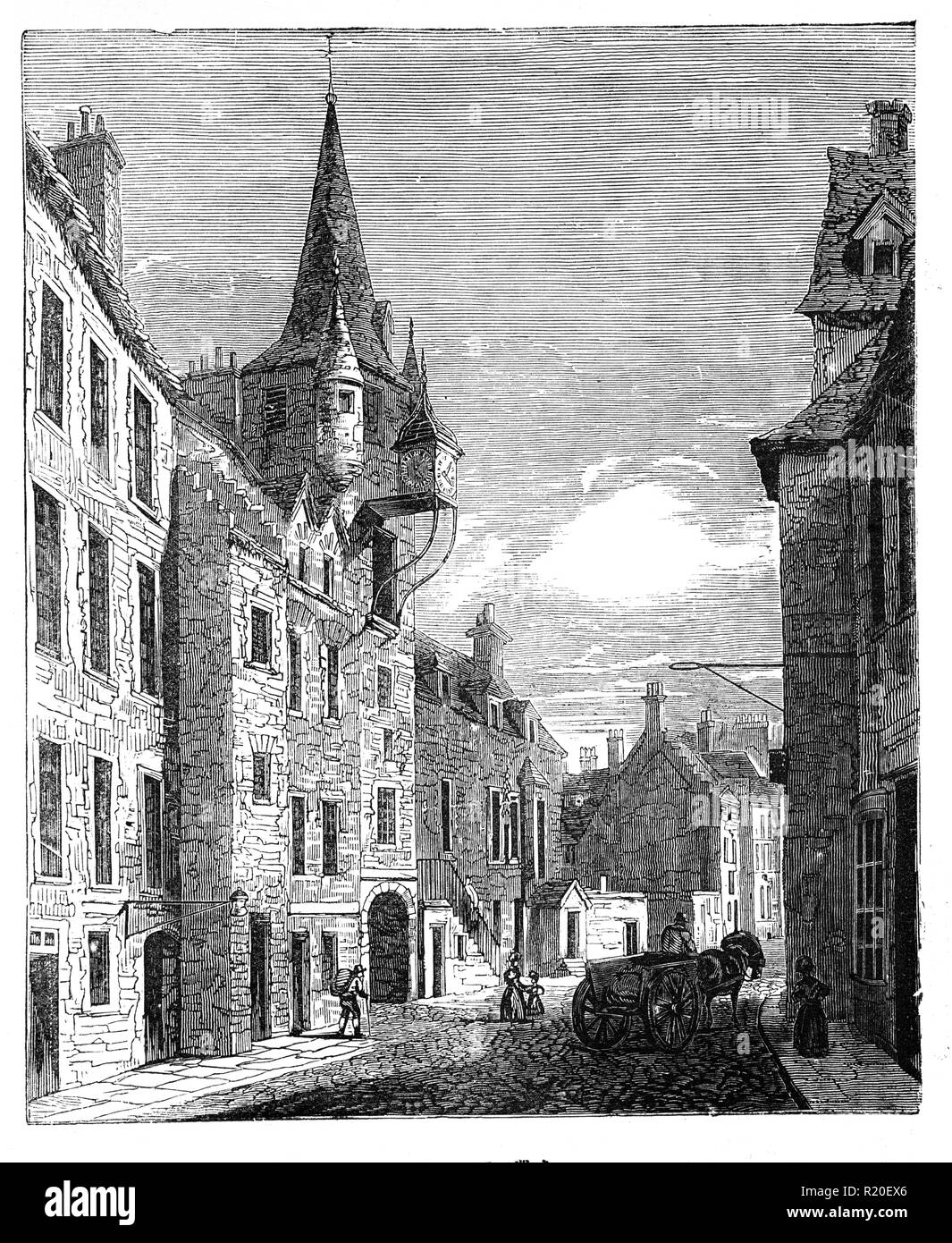 The Canongate Tolbooth was built in 1591 and would have formed the local hub for the Canongate burgh, along with the nearby Mercat Cross where merchants met and conducted their business. The Tolbooth would have had many functions, serving as courthouse, burgh jail and meeting place of the town council. The building was constructed for Sir Lewis Bellenden, the justice-clerk for the burgh, and his initials can still be seen over the archway to Tolbooth Wynd. Edinburgh, Scotland Stock Photohttps://www.alamy.com/image-license-details/?v=1https://www.alamy.com/the-canongate-tolbooth-was-built-in-1591-and-would-have-formed-the-local-hub-for-the-canongate-burgh-along-with-the-nearby-mercat-cross-where-merchants-met-and-conducted-their-business-the-tolbooth-would-have-had-many-functions-serving-as-courthouse-burgh-jail-and-meeting-place-of-the-town-council-the-building-was-constructed-for-sir-lewis-bellenden-the-justice-clerk-for-the-burgh-and-his-initials-can-still-be-seen-over-the-archway-to-tolbooth-wynd-edinburgh-scotland-image224975806.html
The Canongate Tolbooth was built in 1591 and would have formed the local hub for the Canongate burgh, along with the nearby Mercat Cross where merchants met and conducted their business. The Tolbooth would have had many functions, serving as courthouse, burgh jail and meeting place of the town council. The building was constructed for Sir Lewis Bellenden, the justice-clerk for the burgh, and his initials can still be seen over the archway to Tolbooth Wynd. Edinburgh, Scotland Stock Photohttps://www.alamy.com/image-license-details/?v=1https://www.alamy.com/the-canongate-tolbooth-was-built-in-1591-and-would-have-formed-the-local-hub-for-the-canongate-burgh-along-with-the-nearby-mercat-cross-where-merchants-met-and-conducted-their-business-the-tolbooth-would-have-had-many-functions-serving-as-courthouse-burgh-jail-and-meeting-place-of-the-town-council-the-building-was-constructed-for-sir-lewis-bellenden-the-justice-clerk-for-the-burgh-and-his-initials-can-still-be-seen-over-the-archway-to-tolbooth-wynd-edinburgh-scotland-image224975806.htmlRMR20EX6–The Canongate Tolbooth was built in 1591 and would have formed the local hub for the Canongate burgh, along with the nearby Mercat Cross where merchants met and conducted their business. The Tolbooth would have had many functions, serving as courthouse, burgh jail and meeting place of the town council. The building was constructed for Sir Lewis Bellenden, the justice-clerk for the burgh, and his initials can still be seen over the archway to Tolbooth Wynd. Edinburgh, Scotland
 Summer Landscape with a Horse and Cart and Other Figures on a Path 17th century by Izaak van Oosten Stock Photohttps://www.alamy.com/image-license-details/?v=1https://www.alamy.com/summer-landscape-with-a-horse-and-cart-and-other-figures-on-a-path-17th-century-by-izaak-van-oosten-image562828222.html
Summer Landscape with a Horse and Cart and Other Figures on a Path 17th century by Izaak van Oosten Stock Photohttps://www.alamy.com/image-license-details/?v=1https://www.alamy.com/summer-landscape-with-a-horse-and-cart-and-other-figures-on-a-path-17th-century-by-izaak-van-oosten-image562828222.htmlRM2RKK13X–Summer Landscape with a Horse and Cart and Other Figures on a Path 17th century by Izaak van Oosten
 A late 19th century view of Castleconnell, a village in County Limerick on the banks of the River Shannon. The ruins of the 'Castle of Connell'from which the name of the village derives, was built on a rock outcrop overlooking the bend of the river. It was destroyed in a siege by the army of General Ginkel, fighting in support of the Army of William of Orange at the end of the 17th century. Stock Photohttps://www.alamy.com/image-license-details/?v=1https://www.alamy.com/a-late-19th-century-view-of-castleconnell-a-village-in-county-limerick-on-the-banks-of-the-river-shannon-the-ruins-of-the-castle-of-connellfrom-which-the-name-of-the-village-derives-was-built-on-a-rock-outcrop-overlooking-the-bend-of-the-river-it-was-destroyed-in-a-siege-by-the-army-of-general-ginkel-fighting-in-support-of-the-army-of-william-of-orange-at-the-end-of-the-17th-century-image554852214.html
A late 19th century view of Castleconnell, a village in County Limerick on the banks of the River Shannon. The ruins of the 'Castle of Connell'from which the name of the village derives, was built on a rock outcrop overlooking the bend of the river. It was destroyed in a siege by the army of General Ginkel, fighting in support of the Army of William of Orange at the end of the 17th century. Stock Photohttps://www.alamy.com/image-license-details/?v=1https://www.alamy.com/a-late-19th-century-view-of-castleconnell-a-village-in-county-limerick-on-the-banks-of-the-river-shannon-the-ruins-of-the-castle-of-connellfrom-which-the-name-of-the-village-derives-was-built-on-a-rock-outcrop-overlooking-the-bend-of-the-river-it-was-destroyed-in-a-siege-by-the-army-of-general-ginkel-fighting-in-support-of-the-army-of-william-of-orange-at-the-end-of-the-17th-century-image554852214.htmlRM2R6KKJE–A late 19th century view of Castleconnell, a village in County Limerick on the banks of the River Shannon. The ruins of the 'Castle of Connell'from which the name of the village derives, was built on a rock outcrop overlooking the bend of the river. It was destroyed in a siege by the army of General Ginkel, fighting in support of the Army of William of Orange at the end of the 17th century.
 'Landscape', late 16th or early 17th century. Artist: Jan Brueghel the Elder Stock Photohttps://www.alamy.com/image-license-details/?v=1https://www.alamy.com/landscape-late-16th-or-early-17th-century-artist-jan-brueghel-the-image60416191.html
'Landscape', late 16th or early 17th century. Artist: Jan Brueghel the Elder Stock Photohttps://www.alamy.com/image-license-details/?v=1https://www.alamy.com/landscape-late-16th-or-early-17th-century-artist-jan-brueghel-the-image60416191.htmlRMDE85D3–'Landscape', late 16th or early 17th century. Artist: Jan Brueghel the Elder
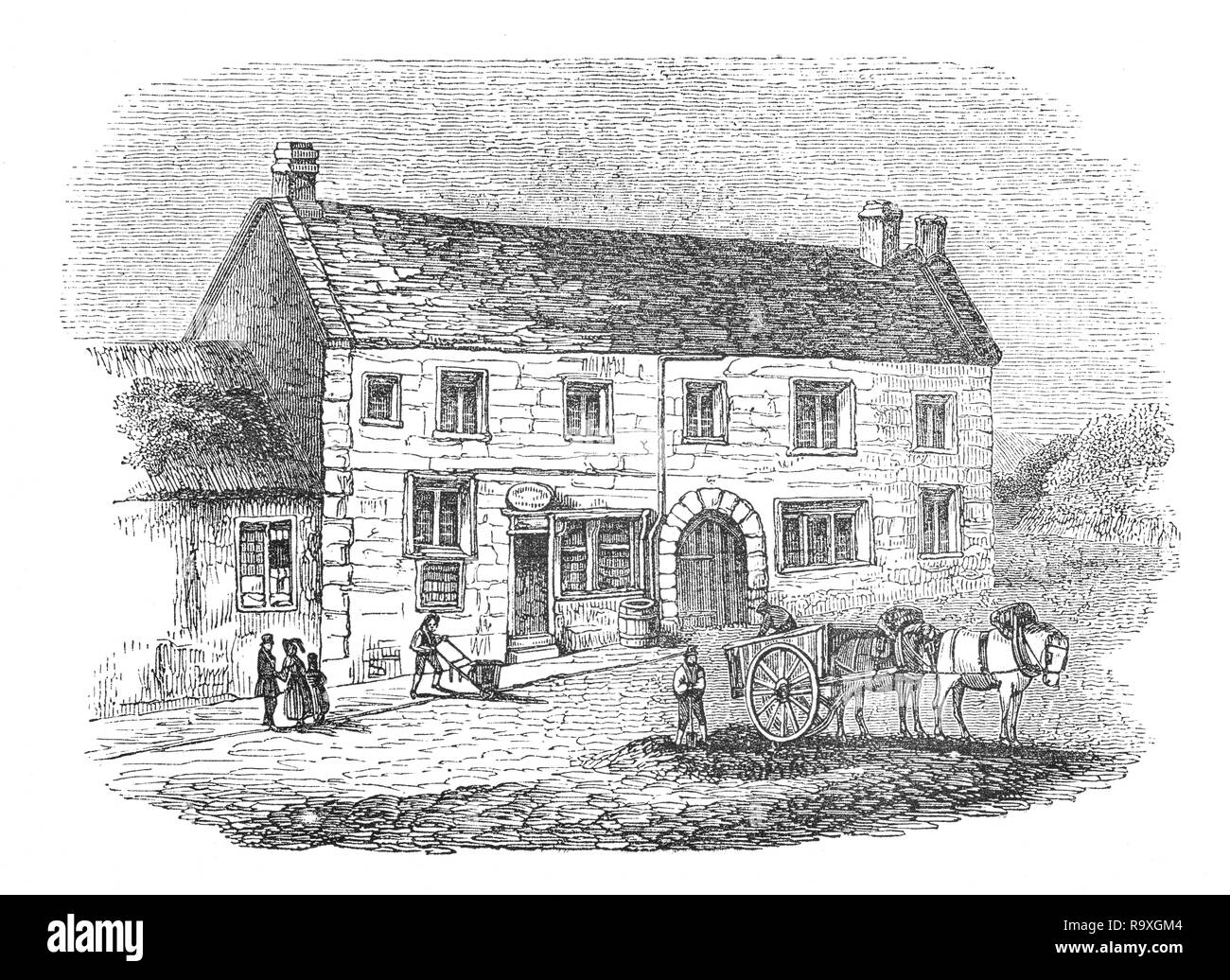 The inn at Charmouth in Dorset, England, now known as Abbots House, gave shelter to the disguised, fugitive King Charles II on 22 September 1651, when he came looking for a boat to take him to France following defeat at the Battle of Worcester. A small trading ship bound for St Malo was found, and the master, Stephen Limbry, agreed to pick up the King from Charmouth beach and transport him to the ship, but just two hours before the pick up Limbry told his wife, who locked him in his room and stole his clothes to ensure he would not become involved. The following day Charles left Charmouth. Stock Photohttps://www.alamy.com/image-license-details/?v=1https://www.alamy.com/the-inn-at-charmouth-in-dorset-england-now-known-as-abbots-house-gave-shelter-to-the-disguised-fugitive-king-charles-ii-on-22-september-1651-when-he-came-looking-for-a-boat-to-take-him-to-france-following-defeat-at-the-battle-of-worcester-a-small-trading-ship-bound-for-st-malo-was-found-and-the-master-stephen-limbry-agreed-to-pick-up-the-king-from-charmouth-beach-and-transport-him-to-the-ship-but-just-two-hours-before-the-pick-up-limbry-told-his-wife-who-locked-him-in-his-room-and-stole-his-clothes-to-ensure-he-would-not-become-involved-the-following-day-charles-left-charmouth-image229850548.html
The inn at Charmouth in Dorset, England, now known as Abbots House, gave shelter to the disguised, fugitive King Charles II on 22 September 1651, when he came looking for a boat to take him to France following defeat at the Battle of Worcester. A small trading ship bound for St Malo was found, and the master, Stephen Limbry, agreed to pick up the King from Charmouth beach and transport him to the ship, but just two hours before the pick up Limbry told his wife, who locked him in his room and stole his clothes to ensure he would not become involved. The following day Charles left Charmouth. Stock Photohttps://www.alamy.com/image-license-details/?v=1https://www.alamy.com/the-inn-at-charmouth-in-dorset-england-now-known-as-abbots-house-gave-shelter-to-the-disguised-fugitive-king-charles-ii-on-22-september-1651-when-he-came-looking-for-a-boat-to-take-him-to-france-following-defeat-at-the-battle-of-worcester-a-small-trading-ship-bound-for-st-malo-was-found-and-the-master-stephen-limbry-agreed-to-pick-up-the-king-from-charmouth-beach-and-transport-him-to-the-ship-but-just-two-hours-before-the-pick-up-limbry-told-his-wife-who-locked-him-in-his-room-and-stole-his-clothes-to-ensure-he-would-not-become-involved-the-following-day-charles-left-charmouth-image229850548.htmlRMR9XGM4–The inn at Charmouth in Dorset, England, now known as Abbots House, gave shelter to the disguised, fugitive King Charles II on 22 September 1651, when he came looking for a boat to take him to France following defeat at the Battle of Worcester. A small trading ship bound for St Malo was found, and the master, Stephen Limbry, agreed to pick up the King from Charmouth beach and transport him to the ship, but just two hours before the pick up Limbry told his wife, who locked him in his room and stole his clothes to ensure he would not become involved. The following day Charles left Charmouth.
 Expulsion of the Jews from Vienna. The expulsion was ordered and executed by Emperor Leopold. Already at the end of the 17th century, the Jews settled in Vienna again. Stock Photohttps://www.alamy.com/image-license-details/?v=1https://www.alamy.com/expulsion-of-the-jews-from-vienna-the-expulsion-was-ordered-and-executed-by-emperor-leopold-already-at-the-end-of-the-17th-century-the-jews-settled-in-vienna-again-image247163806.html
Expulsion of the Jews from Vienna. The expulsion was ordered and executed by Emperor Leopold. Already at the end of the 17th century, the Jews settled in Vienna again. Stock Photohttps://www.alamy.com/image-license-details/?v=1https://www.alamy.com/expulsion-of-the-jews-from-vienna-the-expulsion-was-ordered-and-executed-by-emperor-leopold-already-at-the-end-of-the-17th-century-the-jews-settled-in-vienna-again-image247163806.htmlRMTA37XP–Expulsion of the Jews from Vienna. The expulsion was ordered and executed by Emperor Leopold. Already at the end of the 17th century, the Jews settled in Vienna again.
 Kingsgate on the Isle of Thanet, Named after an occasion when in 1683, on a sea voyage, King Charles II was caught in a storm and was landed there, Near Broadstairs, Kent, England Stock Photohttps://www.alamy.com/image-license-details/?v=1https://www.alamy.com/stock-photo-kingsgate-on-the-isle-of-thanet-named-after-an-occasion-when-in-1683-87106268.html
Kingsgate on the Isle of Thanet, Named after an occasion when in 1683, on a sea voyage, King Charles II was caught in a storm and was landed there, Near Broadstairs, Kent, England Stock Photohttps://www.alamy.com/image-license-details/?v=1https://www.alamy.com/stock-photo-kingsgate-on-the-isle-of-thanet-named-after-an-occasion-when-in-1683-87106268.htmlRMF1M0X4–Kingsgate on the Isle of Thanet, Named after an occasion when in 1683, on a sea voyage, King Charles II was caught in a storm and was landed there, Near Broadstairs, Kent, England
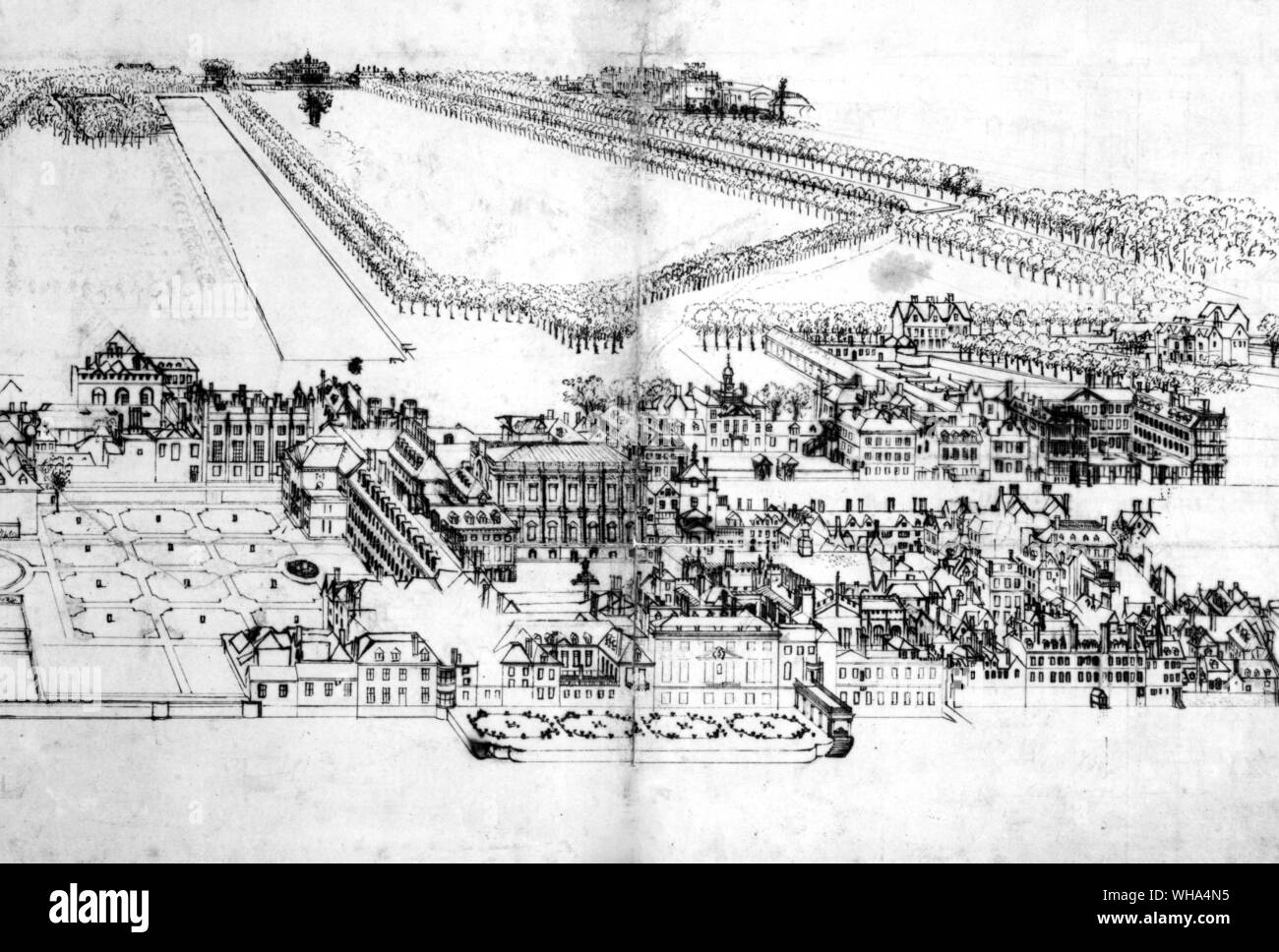 Palace of Whitehall, c.1694. The Banqueting House is in the centre with the Horse Guiards to its right and the Privy Garden on the left. The buildings were used both as official lodgings and as government offices. Across St James's Park, and close by the recently constructed ornamental water, les Arlington House (occupying roughly the site of the modern Buckingham palace), and (to the right), St James's Palace. Taken from Pepys, Samuel English diarist and naval administrator; kept diary 1660-1669 (published 1893-1899); president of Royal Society 1684-1686 1633-1703 Stock Photohttps://www.alamy.com/image-license-details/?v=1https://www.alamy.com/palace-of-whitehall-c1694-the-banqueting-house-is-in-the-centre-with-the-horse-guiards-to-its-right-and-the-privy-garden-on-the-left-the-buildings-were-used-both-as-official-lodgings-and-as-government-offices-across-st-jamess-park-and-close-by-the-recently-constructed-ornamental-water-les-arlington-house-occupying-roughly-the-site-of-the-modern-buckingham-palace-and-to-the-right-st-jamess-palace-taken-from-pepys-samuel-english-diarist-and-naval-administrator-kept-diary-1660-1669-published-1893-1899-president-of-royal-society-1684-1686-1633-1703-image268827921.html
Palace of Whitehall, c.1694. The Banqueting House is in the centre with the Horse Guiards to its right and the Privy Garden on the left. The buildings were used both as official lodgings and as government offices. Across St James's Park, and close by the recently constructed ornamental water, les Arlington House (occupying roughly the site of the modern Buckingham palace), and (to the right), St James's Palace. Taken from Pepys, Samuel English diarist and naval administrator; kept diary 1660-1669 (published 1893-1899); president of Royal Society 1684-1686 1633-1703 Stock Photohttps://www.alamy.com/image-license-details/?v=1https://www.alamy.com/palace-of-whitehall-c1694-the-banqueting-house-is-in-the-centre-with-the-horse-guiards-to-its-right-and-the-privy-garden-on-the-left-the-buildings-were-used-both-as-official-lodgings-and-as-government-offices-across-st-jamess-park-and-close-by-the-recently-constructed-ornamental-water-les-arlington-house-occupying-roughly-the-site-of-the-modern-buckingham-palace-and-to-the-right-st-jamess-palace-taken-from-pepys-samuel-english-diarist-and-naval-administrator-kept-diary-1660-1669-published-1893-1899-president-of-royal-society-1684-1686-1633-1703-image268827921.htmlRMWHA4N5–Palace of Whitehall, c.1694. The Banqueting House is in the centre with the Horse Guiards to its right and the Privy Garden on the left. The buildings were used both as official lodgings and as government offices. Across St James's Park, and close by the recently constructed ornamental water, les Arlington House (occupying roughly the site of the modern Buckingham palace), and (to the right), St James's Palace. Taken from Pepys, Samuel English diarist and naval administrator; kept diary 1660-1669 (published 1893-1899); president of Royal Society 1684-1686 1633-1703
 Le Chartier embourbé The Fables of La Fontaine, illustrated by François Chauveau. 1668 Stock Photohttps://www.alamy.com/image-license-details/?v=1https://www.alamy.com/le-chartier-embourb-the-fables-of-la-fontaine-illustrated-by-franois-chauveau-1668-image567965284.html
Le Chartier embourbé The Fables of La Fontaine, illustrated by François Chauveau. 1668 Stock Photohttps://www.alamy.com/image-license-details/?v=1https://www.alamy.com/le-chartier-embourb-the-fables-of-la-fontaine-illustrated-by-franois-chauveau-1668-image567965284.htmlRM2T011EC–Le Chartier embourbé The Fables of La Fontaine, illustrated by François Chauveau. 1668
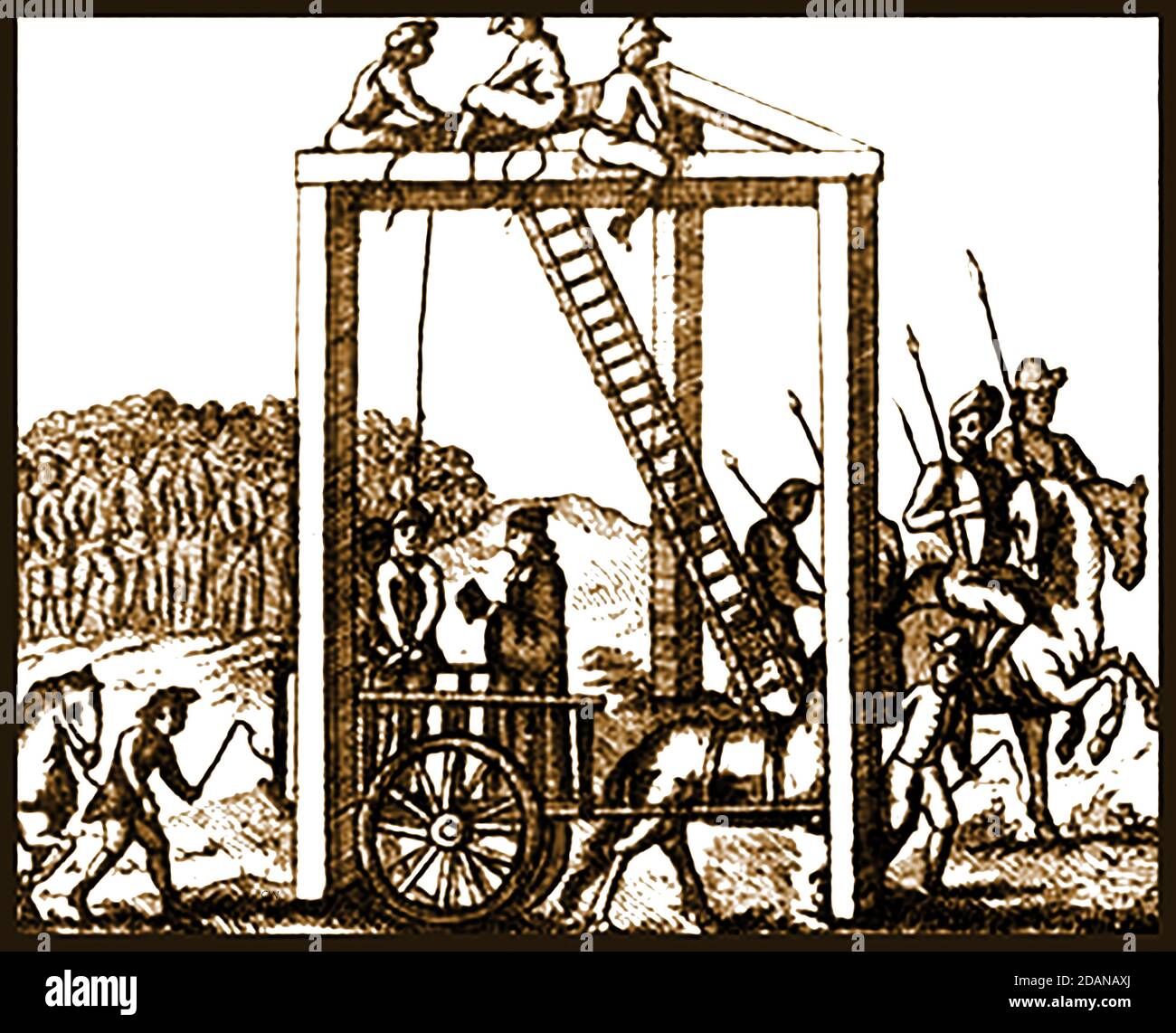 A late 17th century engraving of a hanging taking place on a 'Triple Tree' gibbet in England ('Tyburn Tree') Stock Photohttps://www.alamy.com/image-license-details/?v=1https://www.alamy.com/a-late-17th-century-engraving-of-a-hanging-taking-place-on-a-triple-tree-gibbet-in-england-tyburn-tree-image385244234.html
A late 17th century engraving of a hanging taking place on a 'Triple Tree' gibbet in England ('Tyburn Tree') Stock Photohttps://www.alamy.com/image-license-details/?v=1https://www.alamy.com/a-late-17th-century-engraving-of-a-hanging-taking-place-on-a-triple-tree-gibbet-in-england-tyburn-tree-image385244234.htmlRM2DANAXJ–A late 17th century engraving of a hanging taking place on a 'Triple Tree' gibbet in England ('Tyburn Tree')
 An old engraving of an early lead mine in Britain. This illustration shows that, where the mine was on a hillside, the lead bearing ore (or vein) could often be reached via a tunnel driven into the slope. By the 17th century lead was second in importance in the UK's economy only to wool. It was essential for the roofs, window glazing bars and ammunition. By the 17th century, however, most surface lead had been exhausted. Miners searched for the metal below the surface in known lead-rich areas such as The Peak District, Yorkshire and North Wales. Stock Photohttps://www.alamy.com/image-license-details/?v=1https://www.alamy.com/stock-image-an-old-engraving-of-an-early-lead-mine-in-britain-this-illustration-165352211.html
An old engraving of an early lead mine in Britain. This illustration shows that, where the mine was on a hillside, the lead bearing ore (or vein) could often be reached via a tunnel driven into the slope. By the 17th century lead was second in importance in the UK's economy only to wool. It was essential for the roofs, window glazing bars and ammunition. By the 17th century, however, most surface lead had been exhausted. Miners searched for the metal below the surface in known lead-rich areas such as The Peak District, Yorkshire and North Wales. Stock Photohttps://www.alamy.com/image-license-details/?v=1https://www.alamy.com/stock-image-an-old-engraving-of-an-early-lead-mine-in-britain-this-illustration-165352211.htmlRMKH0CC3–An old engraving of an early lead mine in Britain. This illustration shows that, where the mine was on a hillside, the lead bearing ore (or vein) could often be reached via a tunnel driven into the slope. By the 17th century lead was second in importance in the UK's economy only to wool. It was essential for the roofs, window glazing bars and ammunition. By the 17th century, however, most surface lead had been exhausted. Miners searched for the metal below the surface in known lead-rich areas such as The Peak District, Yorkshire and North Wales.
 Old carriage exhibited at Chippokes Plantation, VA, USA. Stock Photohttps://www.alamy.com/image-license-details/?v=1https://www.alamy.com/old-carriage-exhibited-at-chippokes-plantation-va-usa-image215349551.html
Old carriage exhibited at Chippokes Plantation, VA, USA. Stock Photohttps://www.alamy.com/image-license-details/?v=1https://www.alamy.com/old-carriage-exhibited-at-chippokes-plantation-va-usa-image215349551.htmlRMPEA0FB–Old carriage exhibited at Chippokes Plantation, VA, USA.
 Dutch school. Landscape with horseman and cart. 17th century. Author: Rembrandt (1606-1669). Stock Photohttps://www.alamy.com/image-license-details/?v=1https://www.alamy.com/dutch-school-landscape-with-horseman-and-cart-17th-century-author-rembrandt-1606-1669-image209488831.html
Dutch school. Landscape with horseman and cart. 17th century. Author: Rembrandt (1606-1669). Stock Photohttps://www.alamy.com/image-license-details/?v=1https://www.alamy.com/dutch-school-landscape-with-horseman-and-cart-17th-century-author-rembrandt-1606-1669-image209488831.htmlRMP4R13Y–Dutch school. Landscape with horseman and cart. 17th century. Author: Rembrandt (1606-1669).
 Horse and carriage in front of Halls Croft a 17th century house in Stratford upon Avon UK June 2005 Stock Photohttps://www.alamy.com/image-license-details/?v=1https://www.alamy.com/horse-and-carriage-in-front-of-halls-croft-a-17th-century-house-in-image7204439.html
Horse and carriage in front of Halls Croft a 17th century house in Stratford upon Avon UK June 2005 Stock Photohttps://www.alamy.com/image-license-details/?v=1https://www.alamy.com/horse-and-carriage-in-front-of-halls-croft-a-17th-century-house-in-image7204439.htmlRMAAENW8–Horse and carriage in front of Halls Croft a 17th century house in Stratford upon Avon UK June 2005
 ©Active Museu/MAXPPP - ActiveMuseum 0000501.jpg / Le triomphe de Henry IV - Pierre Paul Rubens (1630) - 1630 - / Pierre Paul Rubens / Peinture Active Museum / Le Pictorium Angel ,Armor ,Baroque ,Cart ,Crowd ,Drawing ,Flag ,Horizontal ,Horse ,King ,Laurel wreath ,Stick (walking) ,Sword ,Triumph ,Henry IV of France ,17th century ,Peter Paul Rubens ,Painting , Stock Photohttps://www.alamy.com/image-license-details/?v=1https://www.alamy.com/active-museumaxppp-activemuseum-0000501jpg-le-triomphe-de-henry-iv-pierre-paul-rubens-1630-1630-pierre-paul-rubens-peinture-active-museum-le-pictorium-angel-armor-baroque-cart-crowd-drawing-flag-horizontal-horse-king-laurel-wreath-stick-walking-sword-triumph-henry-iv-of-france-17th-century-peter-paul-rubens-painting-image486526003.html
©Active Museu/MAXPPP - ActiveMuseum 0000501.jpg / Le triomphe de Henry IV - Pierre Paul Rubens (1630) - 1630 - / Pierre Paul Rubens / Peinture Active Museum / Le Pictorium Angel ,Armor ,Baroque ,Cart ,Crowd ,Drawing ,Flag ,Horizontal ,Horse ,King ,Laurel wreath ,Stick (walking) ,Sword ,Triumph ,Henry IV of France ,17th century ,Peter Paul Rubens ,Painting , Stock Photohttps://www.alamy.com/image-license-details/?v=1https://www.alamy.com/active-museumaxppp-activemuseum-0000501jpg-le-triomphe-de-henry-iv-pierre-paul-rubens-1630-1630-pierre-paul-rubens-peinture-active-museum-le-pictorium-angel-armor-baroque-cart-crowd-drawing-flag-horizontal-horse-king-laurel-wreath-stick-walking-sword-triumph-henry-iv-of-france-17th-century-peter-paul-rubens-painting-image486526003.htmlRM2K7F4TK– ©Active Museu/MAXPPP - ActiveMuseum 0000501.jpg / Le triomphe de Henry IV - Pierre Paul Rubens (1630) - 1630 - / Pierre Paul Rubens / Peinture Active Museum / Le Pictorium Angel ,Armor ,Baroque ,Cart ,Crowd ,Drawing ,Flag ,Horizontal ,Horse ,King ,Laurel wreath ,Stick (walking) ,Sword ,Triumph ,Henry IV of France ,17th century ,Peter Paul Rubens ,Painting ,
 Sita midst of Agini or fire. 17th century wooden carvings in Meenakashi Sundareswarer temple's chariot at Madurai, Tamil Nadu, South India, India Stock Photohttps://www.alamy.com/image-license-details/?v=1https://www.alamy.com/sita-midst-of-agini-or-fire-17th-century-wooden-carvings-in-meenakashi-sundareswarer-temples-chariot-at-madurai-tamil-nadu-south-india-india-image543359347.html
Sita midst of Agini or fire. 17th century wooden carvings in Meenakashi Sundareswarer temple's chariot at Madurai, Tamil Nadu, South India, India Stock Photohttps://www.alamy.com/image-license-details/?v=1https://www.alamy.com/sita-midst-of-agini-or-fire-17th-century-wooden-carvings-in-meenakashi-sundareswarer-temples-chariot-at-madurai-tamil-nadu-south-india-india-image543359347.htmlRF2PG04AY–Sita midst of Agini or fire. 17th century wooden carvings in Meenakashi Sundareswarer temple's chariot at Madurai, Tamil Nadu, South India, India
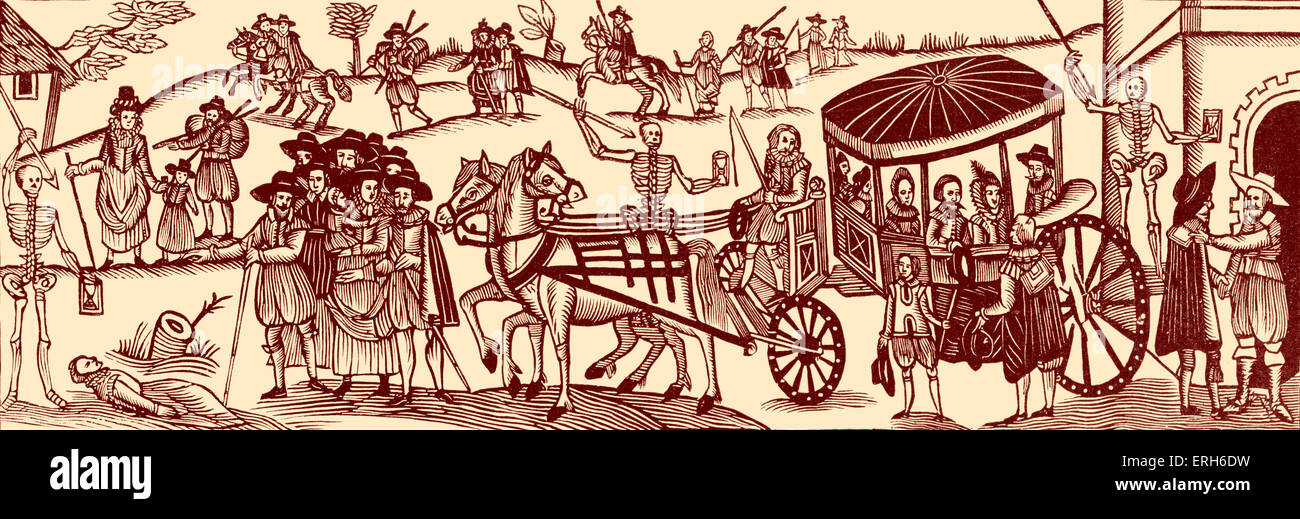 Flight of townspeople into the country to escape the plague, 1630. People travelling by horse cart. Plague depicted as skeleton Stock Photohttps://www.alamy.com/image-license-details/?v=1https://www.alamy.com/stock-photo-flight-of-townspeople-into-the-country-to-escape-the-plague-1630-people-83356837.html
Flight of townspeople into the country to escape the plague, 1630. People travelling by horse cart. Plague depicted as skeleton Stock Photohttps://www.alamy.com/image-license-details/?v=1https://www.alamy.com/stock-photo-flight-of-townspeople-into-the-country-to-escape-the-plague-1630-people-83356837.htmlRMERH6DW–Flight of townspeople into the country to escape the plague, 1630. People travelling by horse cart. Plague depicted as skeleton
 Dancing Shiva Nataraja. 17th century wooden carvings in Meenakashi Sundareswarer temple's chariot at Madurai, Tamil Nadu, South India, India, Asia Stock Photohttps://www.alamy.com/image-license-details/?v=1https://www.alamy.com/dancing-shiva-nataraja-17th-century-wooden-carvings-in-meenakashi-sundareswarer-temples-chariot-at-madurai-tamil-nadu-south-india-india-asia-image543359375.html
Dancing Shiva Nataraja. 17th century wooden carvings in Meenakashi Sundareswarer temple's chariot at Madurai, Tamil Nadu, South India, India, Asia Stock Photohttps://www.alamy.com/image-license-details/?v=1https://www.alamy.com/dancing-shiva-nataraja-17th-century-wooden-carvings-in-meenakashi-sundareswarer-temples-chariot-at-madurai-tamil-nadu-south-india-india-asia-image543359375.htmlRF2PG04BY–Dancing Shiva Nataraja. 17th century wooden carvings in Meenakashi Sundareswarer temple's chariot at Madurai, Tamil Nadu, South India, India, Asia
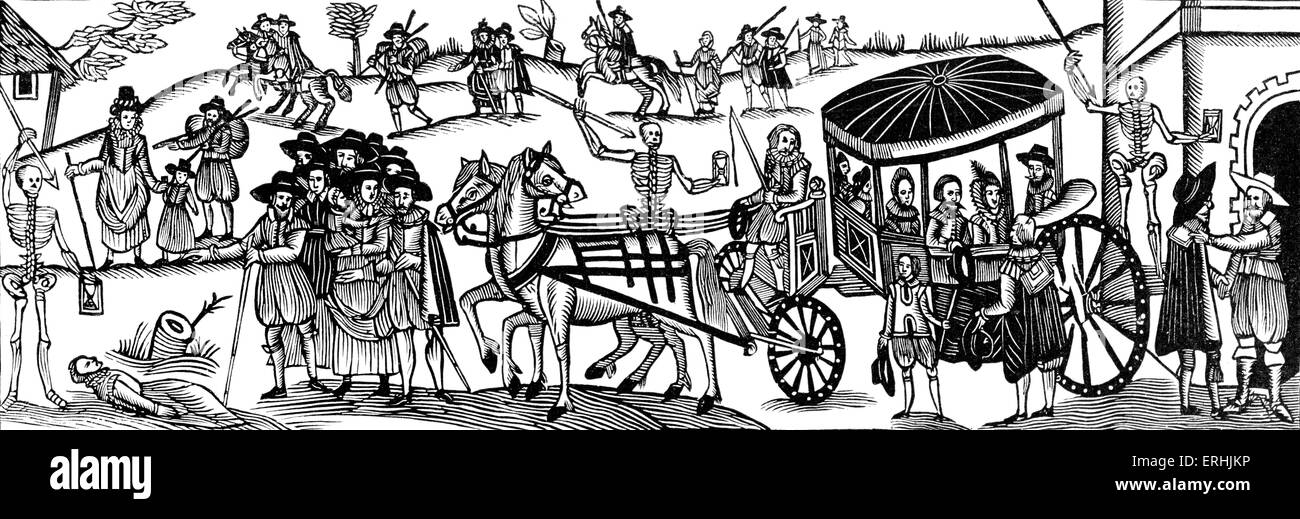 Flight of townspeople into the country to escape the plague, 1630. People travelling by horse cart. Plague depicted as skeleton Stock Photohttps://www.alamy.com/image-license-details/?v=1https://www.alamy.com/stock-photo-flight-of-townspeople-into-the-country-to-escape-the-plague-1630-people-83366410.html
Flight of townspeople into the country to escape the plague, 1630. People travelling by horse cart. Plague depicted as skeleton Stock Photohttps://www.alamy.com/image-license-details/?v=1https://www.alamy.com/stock-photo-flight-of-townspeople-into-the-country-to-escape-the-plague-1630-people-83366410.htmlRMERHJKP–Flight of townspeople into the country to escape the plague, 1630. People travelling by horse cart. Plague depicted as skeleton
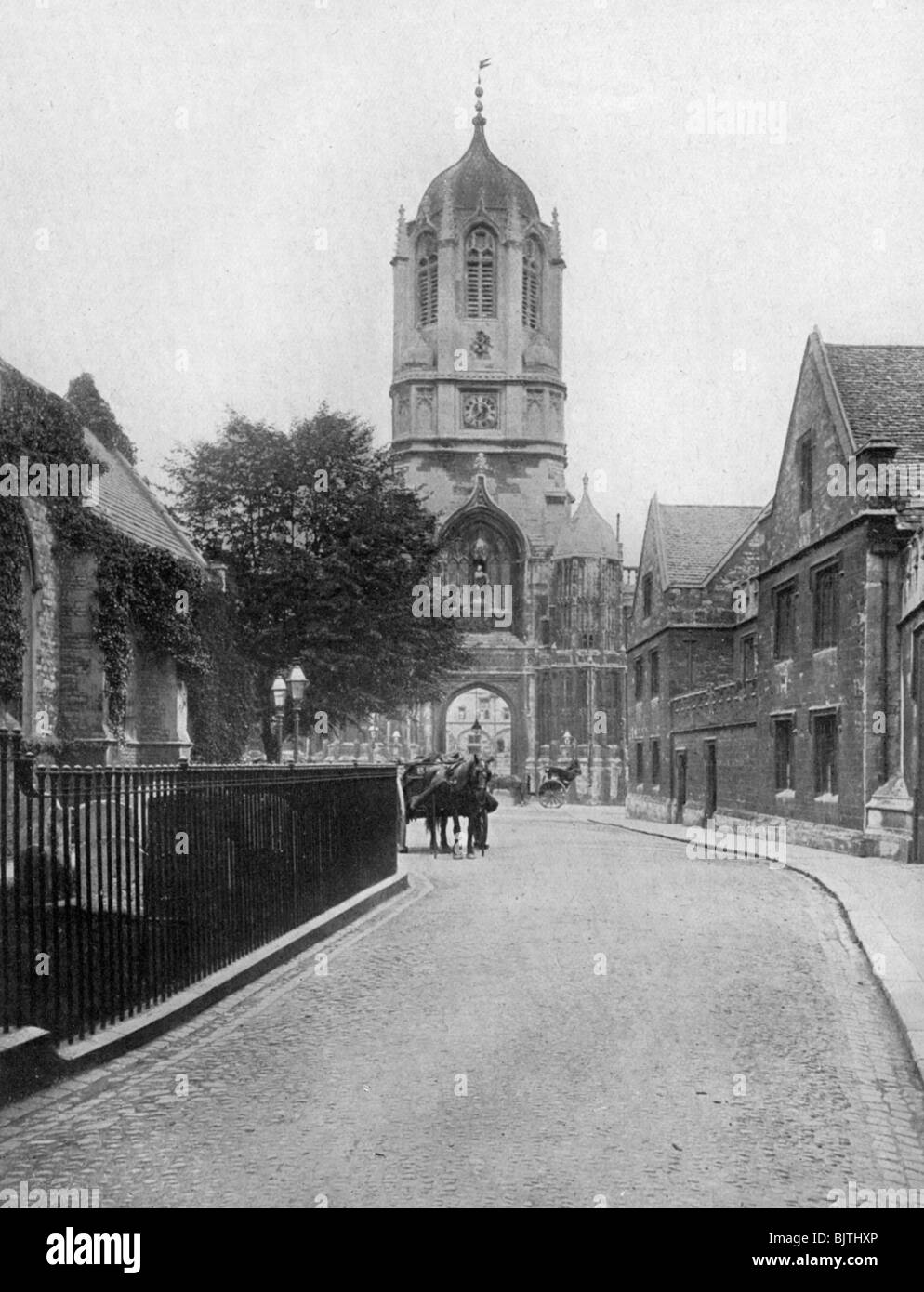 Tom Tower, Christchurch College, Oxford, Oxfordshire, 1924-1926. Artist: W Mann Stock Photohttps://www.alamy.com/image-license-details/?v=1https://www.alamy.com/stock-photo-tom-tower-christchurch-college-oxford-oxfordshire-1924-1926-artist-28815102.html
Tom Tower, Christchurch College, Oxford, Oxfordshire, 1924-1926. Artist: W Mann Stock Photohttps://www.alamy.com/image-license-details/?v=1https://www.alamy.com/stock-photo-tom-tower-christchurch-college-oxford-oxfordshire-1924-1926-artist-28815102.htmlRMBJTHXP–Tom Tower, Christchurch College, Oxford, Oxfordshire, 1924-1926. Artist: W Mann
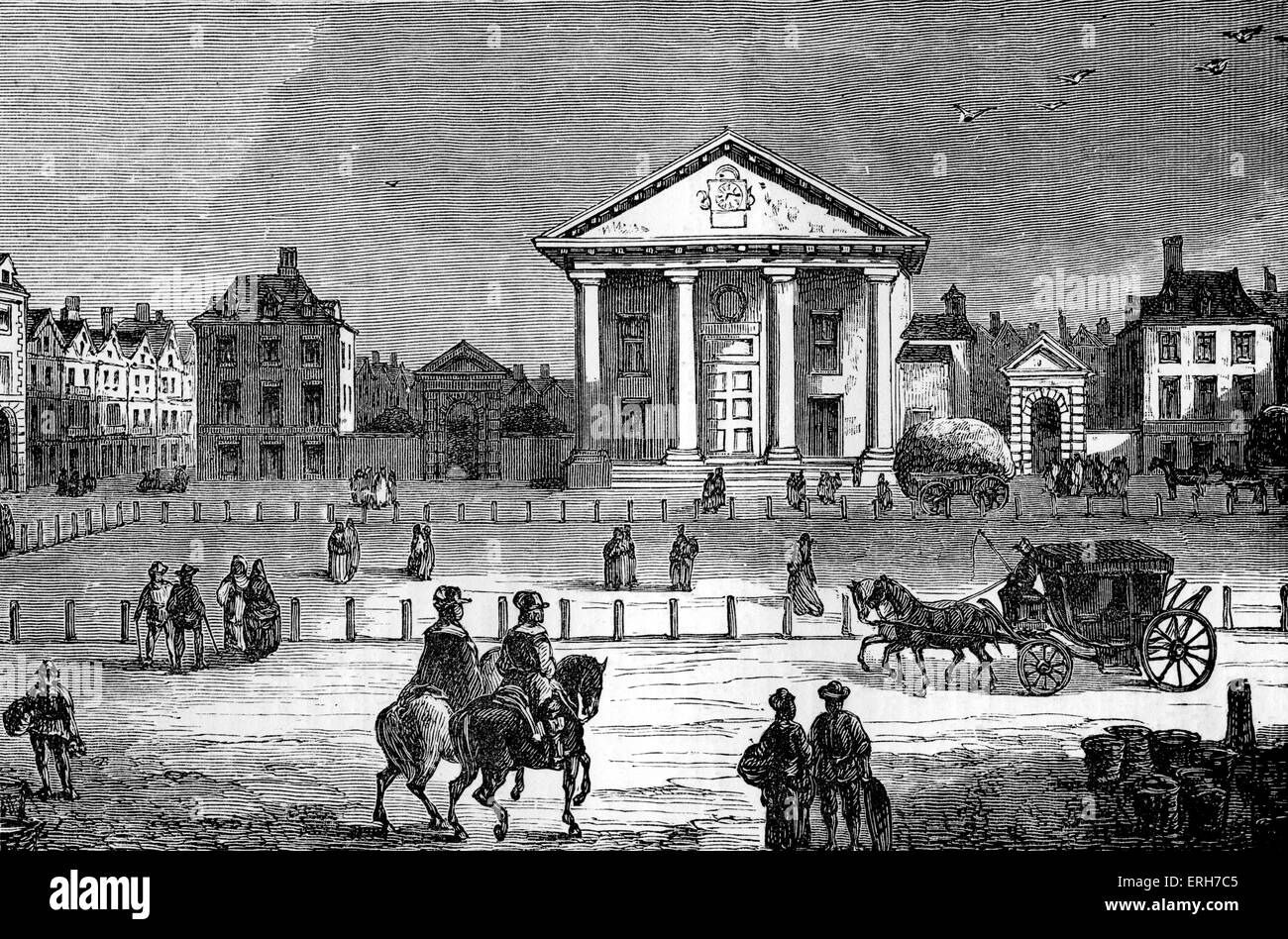 Covent Garden, London, in 1650. Street scene showing riders, carriages, horse and cart, and various passers-by. Stock Photohttps://www.alamy.com/image-license-details/?v=1https://www.alamy.com/stock-photo-covent-garden-london-in-1650-street-scene-showing-riders-carriages-83357573.html
Covent Garden, London, in 1650. Street scene showing riders, carriages, horse and cart, and various passers-by. Stock Photohttps://www.alamy.com/image-license-details/?v=1https://www.alamy.com/stock-photo-covent-garden-london-in-1650-street-scene-showing-riders-carriages-83357573.htmlRMERH7C5–Covent Garden, London, in 1650. Street scene showing riders, carriages, horse and cart, and various passers-by.
 A photographic view of part of Covent Garden (fruit and vegetable Market) circa 1930 , London, England (Originally it served as the convent garden for St. Peter's, hence its earlier name of Convent Market). In the mid 17th century pineapples were successfully grown here and for a time the pineapple was adopted as the symbol of Covent Garden Market Stock Photohttps://www.alamy.com/image-license-details/?v=1https://www.alamy.com/a-photographic-view-of-part-of-covent-garden-fruit-and-vegetable-market-circa-1930-london-england-originally-it-served-as-the-convent-garden-for-st-peters-hence-its-earlier-name-of-convent-market-in-the-mid-17th-century-pineapples-were-successfully-grown-here-and-for-a-time-the-pineapple-was-adopted-as-the-symbol-of-covent-garden-market-image235455982.html
A photographic view of part of Covent Garden (fruit and vegetable Market) circa 1930 , London, England (Originally it served as the convent garden for St. Peter's, hence its earlier name of Convent Market). In the mid 17th century pineapples were successfully grown here and for a time the pineapple was adopted as the symbol of Covent Garden Market Stock Photohttps://www.alamy.com/image-license-details/?v=1https://www.alamy.com/a-photographic-view-of-part-of-covent-garden-fruit-and-vegetable-market-circa-1930-london-england-originally-it-served-as-the-convent-garden-for-st-peters-hence-its-earlier-name-of-convent-market-in-the-mid-17th-century-pineapples-were-successfully-grown-here-and-for-a-time-the-pineapple-was-adopted-as-the-symbol-of-covent-garden-market-image235455982.htmlRMRK1XE6–A photographic view of part of Covent Garden (fruit and vegetable Market) circa 1930 , London, England (Originally it served as the convent garden for St. Peter's, hence its earlier name of Convent Market). In the mid 17th century pineapples were successfully grown here and for a time the pineapple was adopted as the symbol of Covent Garden Market
 'Landscape with a Chapel on a Hill', late 16th or 17th century. Artist: Joos de Momper, the younger Stock Photohttps://www.alamy.com/image-license-details/?v=1https://www.alamy.com/landscape-with-a-chapel-on-a-hill-late-16th-or-17th-century-artist-image60293481.html
'Landscape with a Chapel on a Hill', late 16th or 17th century. Artist: Joos de Momper, the younger Stock Photohttps://www.alamy.com/image-license-details/?v=1https://www.alamy.com/landscape-with-a-chapel-on-a-hill-late-16th-or-17th-century-artist-image60293481.htmlRMDE2GXH–'Landscape with a Chapel on a Hill', late 16th or 17th century. Artist: Joos de Momper, the younger
 Covent Garden, London, in 1650. Street scene showing riders, carriages, horse and cart, and various passers-by. Stock Photohttps://www.alamy.com/image-license-details/?v=1https://www.alamy.com/stock-photo-covent-garden-london-in-1650-street-scene-showing-riders-carriages-83358407.html
Covent Garden, London, in 1650. Street scene showing riders, carriages, horse and cart, and various passers-by. Stock Photohttps://www.alamy.com/image-license-details/?v=1https://www.alamy.com/stock-photo-covent-garden-london-in-1650-street-scene-showing-riders-carriages-83358407.htmlRMERH8DY–Covent Garden, London, in 1650. Street scene showing riders, carriages, horse and cart, and various passers-by.
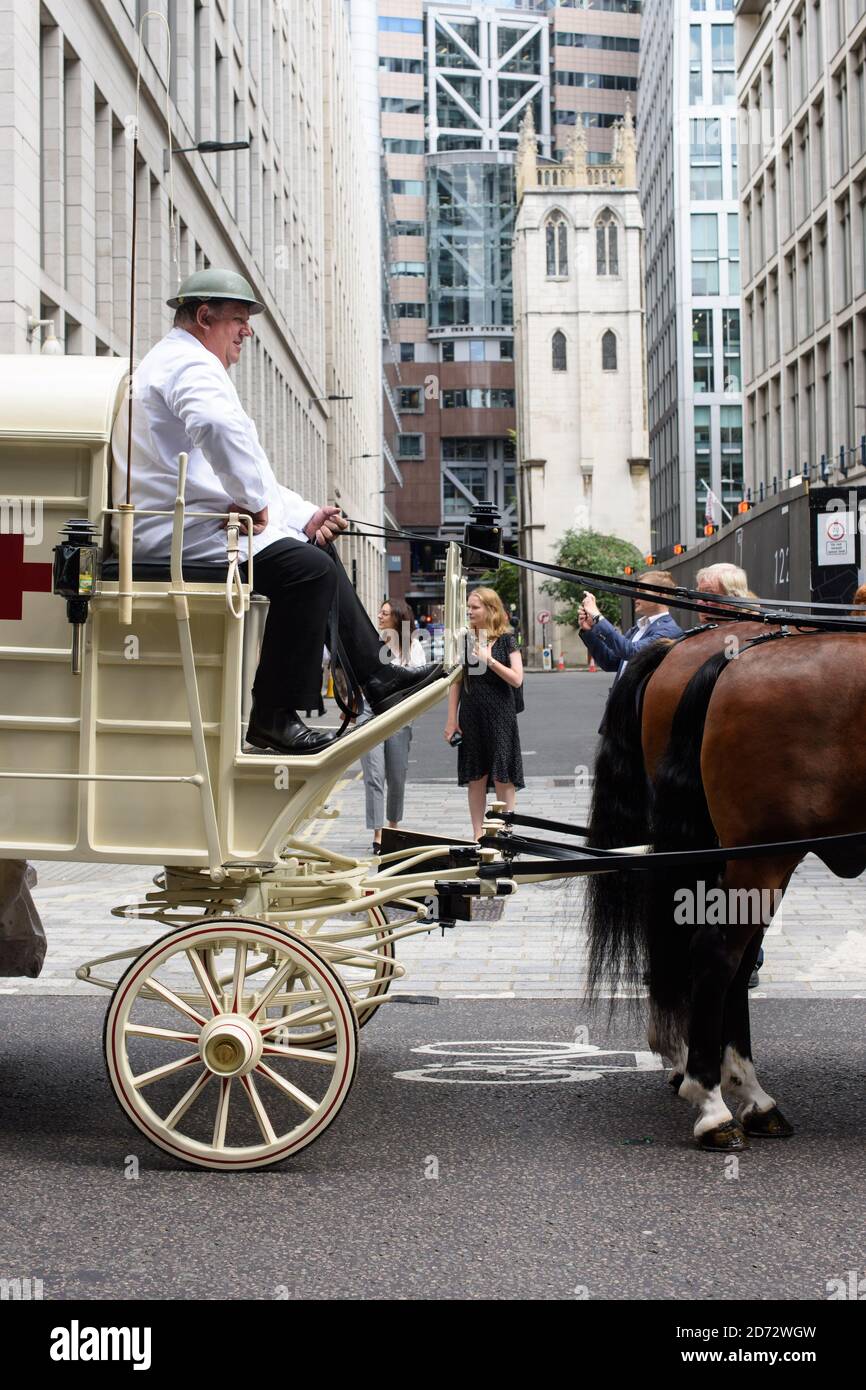 Members of the Worshipful Company of Carmen drive their historic carts and vehicles to Guildhall, in the City of London, for the annual Cart Marking Ceremony. The tradition, originating in the licensing of vehicles for hire in the 17th century, sees each vehicle branded with a letter to mark its official licensed status. Picture date: Wednesday July 18th, 2018. Photo credit should read: Matt Crossick/ EMPICS Entertainment. Stock Photohttps://www.alamy.com/image-license-details/?v=1https://www.alamy.com/members-of-the-worshipful-company-of-carmen-drive-their-historic-carts-and-vehicles-to-guildhall-in-the-city-of-london-for-the-annual-cart-marking-ceremony-the-tradition-originating-in-the-licensing-of-vehicles-for-hire-in-the-17th-century-sees-each-vehicle-branded-with-a-letter-to-mark-its-official-licensed-status-picture-date-wednesday-july-18th-2018-photo-credit-should-read-matt-crossick-empics-entertainment-image382994665.html
Members of the Worshipful Company of Carmen drive their historic carts and vehicles to Guildhall, in the City of London, for the annual Cart Marking Ceremony. The tradition, originating in the licensing of vehicles for hire in the 17th century, sees each vehicle branded with a letter to mark its official licensed status. Picture date: Wednesday July 18th, 2018. Photo credit should read: Matt Crossick/ EMPICS Entertainment. Stock Photohttps://www.alamy.com/image-license-details/?v=1https://www.alamy.com/members-of-the-worshipful-company-of-carmen-drive-their-historic-carts-and-vehicles-to-guildhall-in-the-city-of-london-for-the-annual-cart-marking-ceremony-the-tradition-originating-in-the-licensing-of-vehicles-for-hire-in-the-17th-century-sees-each-vehicle-branded-with-a-letter-to-mark-its-official-licensed-status-picture-date-wednesday-july-18th-2018-photo-credit-should-read-matt-crossick-empics-entertainment-image382994665.htmlRM2D72WGW–Members of the Worshipful Company of Carmen drive their historic carts and vehicles to Guildhall, in the City of London, for the annual Cart Marking Ceremony. The tradition, originating in the licensing of vehicles for hire in the 17th century, sees each vehicle branded with a letter to mark its official licensed status. Picture date: Wednesday July 18th, 2018. Photo credit should read: Matt Crossick/ EMPICS Entertainment.
 Tyburn during the reign of King Charles I. Site near Marble Arch, London, notorious for its gallows which could be used for mass hangings. Shows gallows, spectators, and condemned man and priest in horse and cart. Stock Photohttps://www.alamy.com/image-license-details/?v=1https://www.alamy.com/stock-photo-tyburn-during-the-reign-of-king-charles-i-site-near-marble-arch-london-83340270.html
Tyburn during the reign of King Charles I. Site near Marble Arch, London, notorious for its gallows which could be used for mass hangings. Shows gallows, spectators, and condemned man and priest in horse and cart. Stock Photohttps://www.alamy.com/image-license-details/?v=1https://www.alamy.com/stock-photo-tyburn-during-the-reign-of-king-charles-i-site-near-marble-arch-london-83340270.htmlRMERGDA6–Tyburn during the reign of King Charles I. Site near Marble Arch, London, notorious for its gallows which could be used for mass hangings. Shows gallows, spectators, and condemned man and priest in horse and cart.
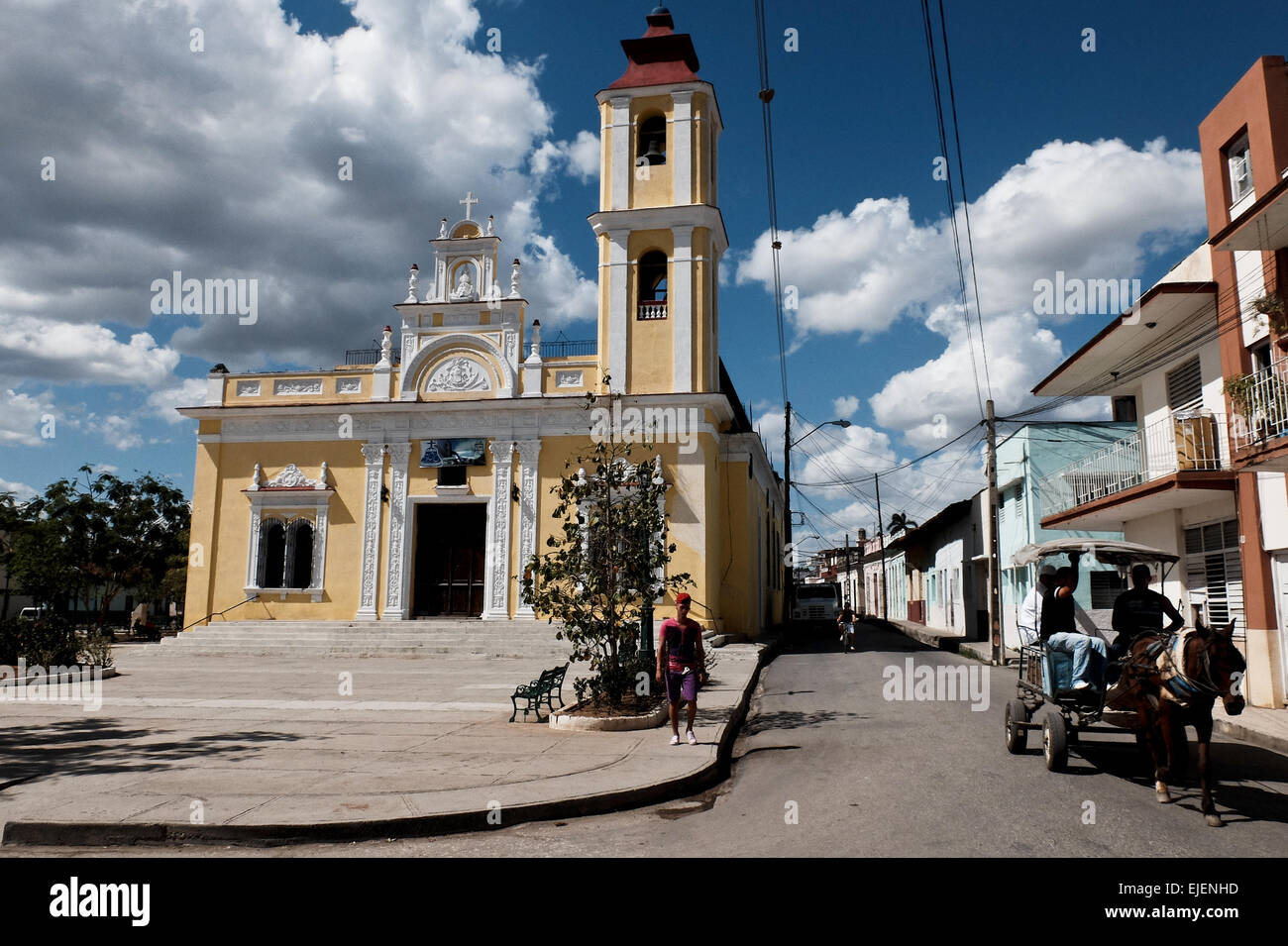 The Sancti Spiritus Church, 'Iglesia Parroquial Mayor del Espiritu Santo', built in 1522 was rebuilt in the 17th century with the same materials because it had been a victim of pirate attacks several times. Stock Photohttps://www.alamy.com/image-license-details/?v=1https://www.alamy.com/stock-photo-the-sancti-spiritus-church-iglesia-parroquial-mayor-del-espiritu-santo-80229561.html
The Sancti Spiritus Church, 'Iglesia Parroquial Mayor del Espiritu Santo', built in 1522 was rebuilt in the 17th century with the same materials because it had been a victim of pirate attacks several times. Stock Photohttps://www.alamy.com/image-license-details/?v=1https://www.alamy.com/stock-photo-the-sancti-spiritus-church-iglesia-parroquial-mayor-del-espiritu-santo-80229561.htmlRMEJENHD–The Sancti Spiritus Church, 'Iglesia Parroquial Mayor del Espiritu Santo', built in 1522 was rebuilt in the 17th century with the same materials because it had been a victim of pirate attacks several times.
 Tyburn during the reign of King Charles I. Site near Marble Arch, London, notorious for its gallows which could be used for mass hangings. Shows gallows, spectators, and condemned man and priest in horse and cart. Stock Photohttps://www.alamy.com/image-license-details/?v=1https://www.alamy.com/stock-photo-tyburn-during-the-reign-of-king-charles-i-site-near-marble-arch-london-83340973.html
Tyburn during the reign of King Charles I. Site near Marble Arch, London, notorious for its gallows which could be used for mass hangings. Shows gallows, spectators, and condemned man and priest in horse and cart. Stock Photohttps://www.alamy.com/image-license-details/?v=1https://www.alamy.com/stock-photo-tyburn-during-the-reign-of-king-charles-i-site-near-marble-arch-london-83340973.htmlRMERGE79–Tyburn during the reign of King Charles I. Site near Marble Arch, London, notorious for its gallows which could be used for mass hangings. Shows gallows, spectators, and condemned man and priest in horse and cart.
 VIENNA, AUSTRIA - NOV 26: famous horse drawm fiaker at the Stephans Dome by night on November 26,2010 in Vienna, Austria. Since the 17th century, the Stock Photohttps://www.alamy.com/image-license-details/?v=1https://www.alamy.com/vienna-austria-nov-26-famous-horse-drawm-fiaker-at-the-stephans-dome-by-night-on-november-262010-in-vienna-austria-since-the-17th-century-the-image560708401.html
VIENNA, AUSTRIA - NOV 26: famous horse drawm fiaker at the Stephans Dome by night on November 26,2010 in Vienna, Austria. Since the 17th century, the Stock Photohttps://www.alamy.com/image-license-details/?v=1https://www.alamy.com/vienna-austria-nov-26-famous-horse-drawm-fiaker-at-the-stephans-dome-by-night-on-november-262010-in-vienna-austria-since-the-17th-century-the-image560708401.htmlRF2RG6D81–VIENNA, AUSTRIA - NOV 26: famous horse drawm fiaker at the Stephans Dome by night on November 26,2010 in Vienna, Austria. Since the 17th century, the
 Fables de la Fontaine - Book 6, no.18. 'Le Chartier embourbé' ('The cart driver who got stuck in the mud'). Fables by Jean de la Fontaine: French fabulist and poet, 8 July 1621 – 13 April 1695. Illustration by Gustave Dore: 6 January 1832 – 23 January 1883. Stock Photohttps://www.alamy.com/image-license-details/?v=1https://www.alamy.com/stock-photo-fables-de-la-fontaine-book-6-no18-le-chartier-embourb-the-cart-driver-83369530.html
Fables de la Fontaine - Book 6, no.18. 'Le Chartier embourbé' ('The cart driver who got stuck in the mud'). Fables by Jean de la Fontaine: French fabulist and poet, 8 July 1621 – 13 April 1695. Illustration by Gustave Dore: 6 January 1832 – 23 January 1883. Stock Photohttps://www.alamy.com/image-license-details/?v=1https://www.alamy.com/stock-photo-fables-de-la-fontaine-book-6-no18-le-chartier-embourb-the-cart-driver-83369530.htmlRMERHPK6–Fables de la Fontaine - Book 6, no.18. 'Le Chartier embourbé' ('The cart driver who got stuck in the mud'). Fables by Jean de la Fontaine: French fabulist and poet, 8 July 1621 – 13 April 1695. Illustration by Gustave Dore: 6 January 1832 – 23 January 1883.
 The Carriere of Nancy, 1626, Jacques Callot, French, 1592–1635, 6 3/8 x 20 in. (16.19 x 50.8 cm) (plate)6 13/16 x 20 1/4 in. (17.3 x 51.44 cm) (sheet), Etching, France, 17th century, The carriere is described as the 'new street' where public festivals were staged; it was situated in close proximity to the Ducal Palace. As inscribed in the banderole (scroll) at the top of the composition, it is indicated that it was the site where jousting, tournaments, and other forms of recreation took place. The present theme may well be the pre-Lental carnival. Stock Photohttps://www.alamy.com/image-license-details/?v=1https://www.alamy.com/the-carriere-of-nancy-1626-jacques-callot-french-15921635-6-38-x-20-in-1619-x-508-cm-plate6-1316-x-20-14-in-173-x-5144-cm-sheet-etching-france-17th-century-the-carriere-is-described-as-the-new-street-where-public-festivals-were-staged-it-was-situated-in-close-proximity-to-the-ducal-palace-as-inscribed-in-the-banderole-scroll-at-the-top-of-the-composition-it-is-indicated-that-it-was-the-site-where-jousting-tournaments-and-other-forms-of-recreation-took-place-the-present-theme-may-well-be-the-pre-lental-carnival-image573507739.html
The Carriere of Nancy, 1626, Jacques Callot, French, 1592–1635, 6 3/8 x 20 in. (16.19 x 50.8 cm) (plate)6 13/16 x 20 1/4 in. (17.3 x 51.44 cm) (sheet), Etching, France, 17th century, The carriere is described as the 'new street' where public festivals were staged; it was situated in close proximity to the Ducal Palace. As inscribed in the banderole (scroll) at the top of the composition, it is indicated that it was the site where jousting, tournaments, and other forms of recreation took place. The present theme may well be the pre-Lental carnival. Stock Photohttps://www.alamy.com/image-license-details/?v=1https://www.alamy.com/the-carriere-of-nancy-1626-jacques-callot-french-15921635-6-38-x-20-in-1619-x-508-cm-plate6-1316-x-20-14-in-173-x-5144-cm-sheet-etching-france-17th-century-the-carriere-is-described-as-the-new-street-where-public-festivals-were-staged-it-was-situated-in-close-proximity-to-the-ducal-palace-as-inscribed-in-the-banderole-scroll-at-the-top-of-the-composition-it-is-indicated-that-it-was-the-site-where-jousting-tournaments-and-other-forms-of-recreation-took-place-the-present-theme-may-well-be-the-pre-lental-carnival-image573507739.htmlRM2T91EY7–The Carriere of Nancy, 1626, Jacques Callot, French, 1592–1635, 6 3/8 x 20 in. (16.19 x 50.8 cm) (plate)6 13/16 x 20 1/4 in. (17.3 x 51.44 cm) (sheet), Etching, France, 17th century, The carriere is described as the 'new street' where public festivals were staged; it was situated in close proximity to the Ducal Palace. As inscribed in the banderole (scroll) at the top of the composition, it is indicated that it was the site where jousting, tournaments, and other forms of recreation took place. The present theme may well be the pre-Lental carnival.
 Austria. Vienna. Panorama of the city in the 17th century from the bank of one of the channels of the river Danube. Lithography. Stock Photohttps://www.alamy.com/image-license-details/?v=1https://www.alamy.com/austria-vienna-panorama-of-the-city-in-the-17th-century-from-the-bank-of-one-of-the-channels-of-the-river-danube-lithography-image211448577.html
Austria. Vienna. Panorama of the city in the 17th century from the bank of one of the channels of the river Danube. Lithography. Stock Photohttps://www.alamy.com/image-license-details/?v=1https://www.alamy.com/austria-vienna-panorama-of-the-city-in-the-17th-century-from-the-bank-of-one-of-the-channels-of-the-river-danube-lithography-image211448577.htmlRMP808PW–Austria. Vienna. Panorama of the city in the 17th century from the bank of one of the channels of the river Danube. Lithography.
 Palazzo Maffei, Verona, Italy, late 19th or early 20th century(?). Artist: Unknown Stock Photohttps://www.alamy.com/image-license-details/?v=1https://www.alamy.com/palazzo-maffei-verona-italy-late-19th-or-early-20th-century-artist-unknown-image262768456.html
Palazzo Maffei, Verona, Italy, late 19th or early 20th century(?). Artist: Unknown Stock Photohttps://www.alamy.com/image-license-details/?v=1https://www.alamy.com/palazzo-maffei-verona-italy-late-19th-or-early-20th-century-artist-unknown-image262768456.htmlRMW7E3RM–Palazzo Maffei, Verona, Italy, late 19th or early 20th century(?). Artist: Unknown
 volante hired carriage Havana two-wheeled two-passenger Spanish hooded body carriage transort travel taxi cart ride horse dog t Stock Photohttps://www.alamy.com/image-license-details/?v=1https://www.alamy.com/stock-photo-volante-hired-carriage-havana-two-wheeled-two-passenger-spanish-hooded-22000516.html
volante hired carriage Havana two-wheeled two-passenger Spanish hooded body carriage transort travel taxi cart ride horse dog t Stock Photohttps://www.alamy.com/image-license-details/?v=1https://www.alamy.com/stock-photo-volante-hired-carriage-havana-two-wheeled-two-passenger-spanish-hooded-22000516.htmlRFB7P5TM–volante hired carriage Havana two-wheeled two-passenger Spanish hooded body carriage transort travel taxi cart ride horse dog t
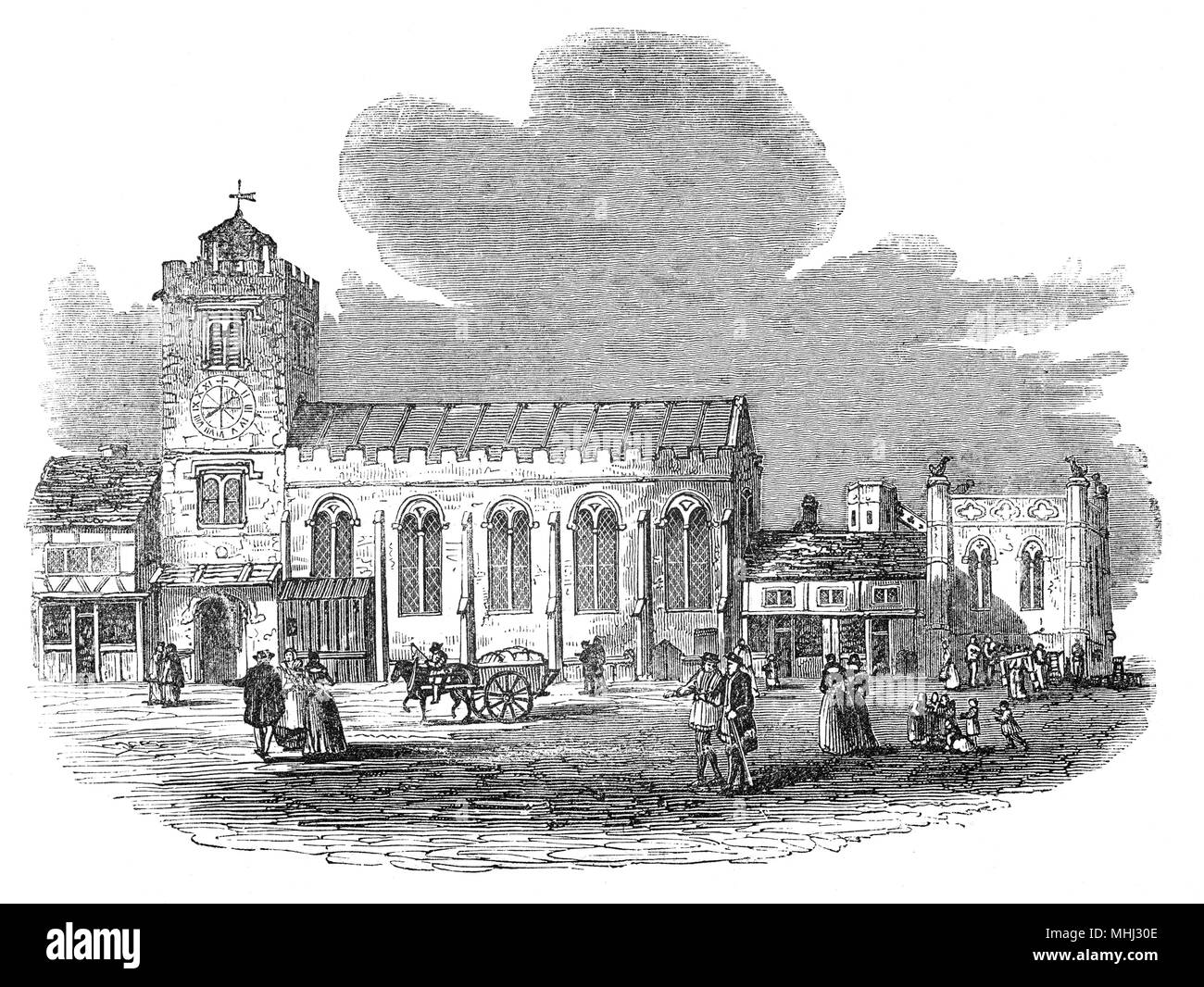 St Michael-le-Querne, also called St Michael ad Bladum, was a parish church that stood immediately to the north east of Paternoster Row in London. Its dedication derives from a 12th-century reference to its proximity to a corn market. St Michael's was rebuilt in 1430, but was destroyed in the Great Fire of London of 1666 and not rebuilt. Stock Photohttps://www.alamy.com/image-license-details/?v=1https://www.alamy.com/st-michael-le-querne-also-called-st-michael-ad-bladum-was-a-parish-church-that-stood-immediately-to-the-north-east-of-paternoster-row-in-london-its-dedication-derives-from-a-12th-century-reference-to-its-proximity-to-a-corn-market-st-michaels-was-rebuilt-in-1430-but-was-destroyed-in-the-great-fire-of-london-of-1666-and-not-rebuilt-image182950334.html
St Michael-le-Querne, also called St Michael ad Bladum, was a parish church that stood immediately to the north east of Paternoster Row in London. Its dedication derives from a 12th-century reference to its proximity to a corn market. St Michael's was rebuilt in 1430, but was destroyed in the Great Fire of London of 1666 and not rebuilt. Stock Photohttps://www.alamy.com/image-license-details/?v=1https://www.alamy.com/st-michael-le-querne-also-called-st-michael-ad-bladum-was-a-parish-church-that-stood-immediately-to-the-north-east-of-paternoster-row-in-london-its-dedication-derives-from-a-12th-century-reference-to-its-proximity-to-a-corn-market-st-michaels-was-rebuilt-in-1430-but-was-destroyed-in-the-great-fire-of-london-of-1666-and-not-rebuilt-image182950334.htmlRMMHJ30E–St Michael-le-Querne, also called St Michael ad Bladum, was a parish church that stood immediately to the north east of Paternoster Row in London. Its dedication derives from a 12th-century reference to its proximity to a corn market. St Michael's was rebuilt in 1430, but was destroyed in the Great Fire of London of 1666 and not rebuilt.
 The crossroads at the Pheasant Inn Chalfont St Giles looking west from London Road, the clearance of cottage in foreground permits widening of junction, Buckinghamshire. 17th August 1928. Stock Photohttps://www.alamy.com/image-license-details/?v=1https://www.alamy.com/stock-photo-the-crossroads-at-the-pheasant-inn-chalfont-st-giles-looking-west-83658174.html
The crossroads at the Pheasant Inn Chalfont St Giles looking west from London Road, the clearance of cottage in foreground permits widening of junction, Buckinghamshire. 17th August 1928. Stock Photohttps://www.alamy.com/image-license-details/?v=1https://www.alamy.com/stock-photo-the-crossroads-at-the-pheasant-inn-chalfont-st-giles-looking-west-83658174.htmlRMET2XRX–The crossroads at the Pheasant Inn Chalfont St Giles looking west from London Road, the clearance of cottage in foreground permits widening of junction, Buckinghamshire. 17th August 1928.
 Lord Siva Nataraja as Urdhva Tandava posture, stood on one leg and lifted the other high above his shoulder. 17th century wooden carvings in Stock Photohttps://www.alamy.com/image-license-details/?v=1https://www.alamy.com/lord-siva-nataraja-as-urdhva-tandava-posture-stood-on-one-leg-and-lifted-the-other-high-above-his-shoulder-17th-century-wooden-carvings-in-image543359376.html
Lord Siva Nataraja as Urdhva Tandava posture, stood on one leg and lifted the other high above his shoulder. 17th century wooden carvings in Stock Photohttps://www.alamy.com/image-license-details/?v=1https://www.alamy.com/lord-siva-nataraja-as-urdhva-tandava-posture-stood-on-one-leg-and-lifted-the-other-high-above-his-shoulder-17th-century-wooden-carvings-in-image543359376.htmlRF2PG04C0–Lord Siva Nataraja as Urdhva Tandava posture, stood on one leg and lifted the other high above his shoulder. 17th century wooden carvings in
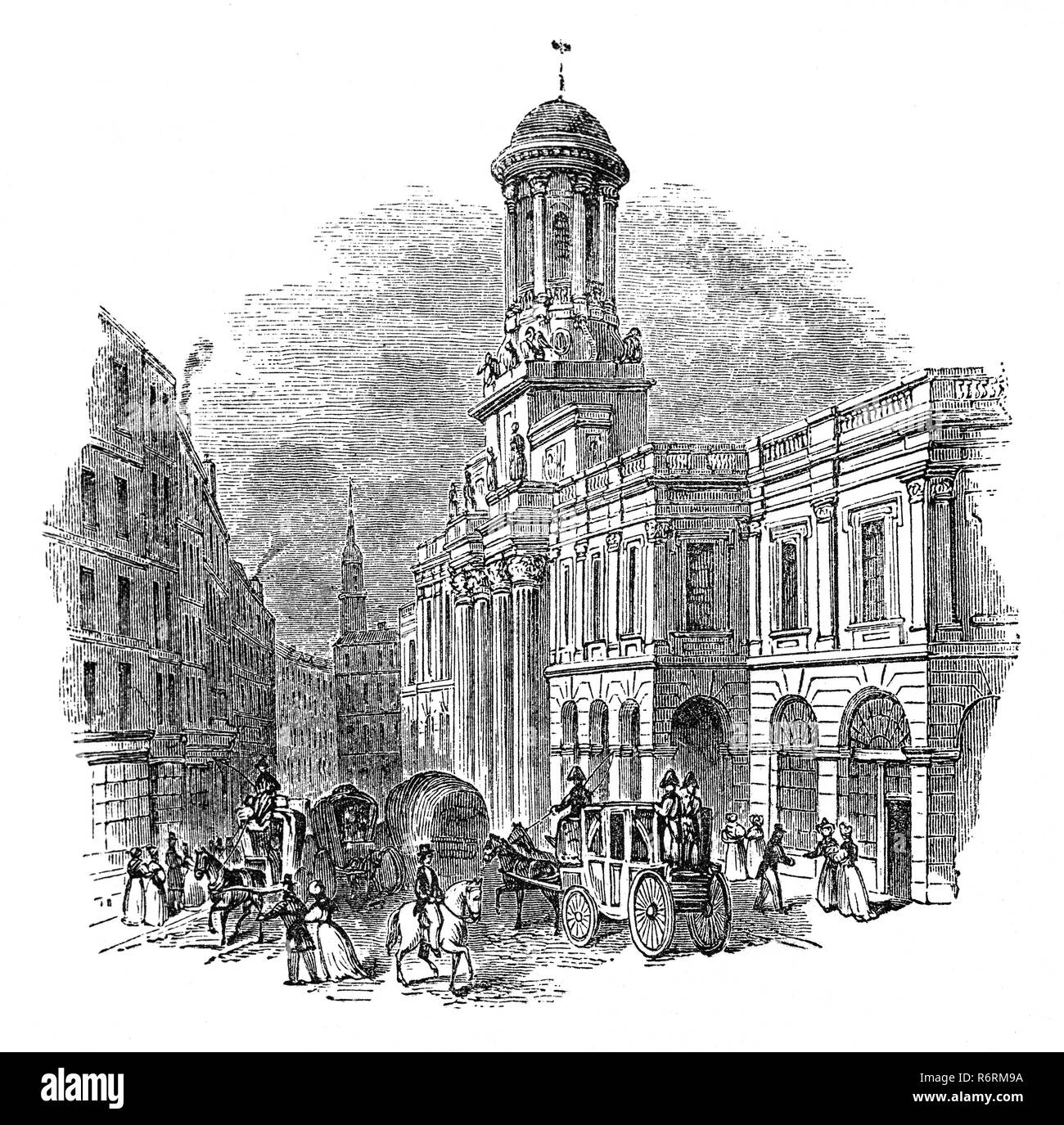 The Royal Exchange in London was founded in the 16th century by the merchant Thomas Gresham to act as a centre of commerce for the City of London. It is the place where certain royal proclamations (such as the dissolution of parliament) are read out by either a herald or a crier. Following the death or abdication of a monarch and the confirmation of the next monarch's accession to the throne by the Accession Council, the Royal Exchange Building is one of the locations where a herald proclaims the new monarch's reign to the public. This building destroyed by fire in the 1840s. Stock Photohttps://www.alamy.com/image-license-details/?v=1https://www.alamy.com/the-royal-exchange-in-london-was-founded-in-the-16th-century-by-the-merchant-thomas-gresham-to-act-as-a-centre-of-commerce-for-the-city-of-london-it-is-the-place-where-certain-royal-proclamations-such-as-the-dissolution-of-parliament-are-read-out-by-either-a-herald-or-a-crier-following-the-death-or-abdication-of-a-monarch-and-the-confirmation-of-the-next-monarchs-accession-to-the-throne-by-the-accession-council-the-royal-exchange-building-is-one-of-the-locations-where-a-herald-proclaims-the-new-monarchs-reign-to-the-public-this-building-destroyed-by-fire-in-the-1840s-image227943558.html
The Royal Exchange in London was founded in the 16th century by the merchant Thomas Gresham to act as a centre of commerce for the City of London. It is the place where certain royal proclamations (such as the dissolution of parliament) are read out by either a herald or a crier. Following the death or abdication of a monarch and the confirmation of the next monarch's accession to the throne by the Accession Council, the Royal Exchange Building is one of the locations where a herald proclaims the new monarch's reign to the public. This building destroyed by fire in the 1840s. Stock Photohttps://www.alamy.com/image-license-details/?v=1https://www.alamy.com/the-royal-exchange-in-london-was-founded-in-the-16th-century-by-the-merchant-thomas-gresham-to-act-as-a-centre-of-commerce-for-the-city-of-london-it-is-the-place-where-certain-royal-proclamations-such-as-the-dissolution-of-parliament-are-read-out-by-either-a-herald-or-a-crier-following-the-death-or-abdication-of-a-monarch-and-the-confirmation-of-the-next-monarchs-accession-to-the-throne-by-the-accession-council-the-royal-exchange-building-is-one-of-the-locations-where-a-herald-proclaims-the-new-monarchs-reign-to-the-public-this-building-destroyed-by-fire-in-the-1840s-image227943558.htmlRMR6RM9A–The Royal Exchange in London was founded in the 16th century by the merchant Thomas Gresham to act as a centre of commerce for the City of London. It is the place where certain royal proclamations (such as the dissolution of parliament) are read out by either a herald or a crier. Following the death or abdication of a monarch and the confirmation of the next monarch's accession to the throne by the Accession Council, the Royal Exchange Building is one of the locations where a herald proclaims the new monarch's reign to the public. This building destroyed by fire in the 1840s.
 Lord Siva as a bridegroom on wedding, Lord Brahma performing wedding pooja, Lord Siva tying mangala sutra to Goddess Parvathi. 17th century wooden Stock Photohttps://www.alamy.com/image-license-details/?v=1https://www.alamy.com/lord-siva-as-a-bridegroom-on-wedding-lord-brahma-performing-wedding-pooja-lord-siva-tying-mangala-sutra-to-goddess-parvathi-17th-century-wooden-image543359477.html
Lord Siva as a bridegroom on wedding, Lord Brahma performing wedding pooja, Lord Siva tying mangala sutra to Goddess Parvathi. 17th century wooden Stock Photohttps://www.alamy.com/image-license-details/?v=1https://www.alamy.com/lord-siva-as-a-bridegroom-on-wedding-lord-brahma-performing-wedding-pooja-lord-siva-tying-mangala-sutra-to-goddess-parvathi-17th-century-wooden-image543359477.htmlRF2PG04FH–Lord Siva as a bridegroom on wedding, Lord Brahma performing wedding pooja, Lord Siva tying mangala sutra to Goddess Parvathi. 17th century wooden
 The Micklebar Gate, in Micklegate Street in the southern entrance to the City of York, England. The name means 'Great Street', 'gate' coming from the Old Norse gata, or street. The lower section was built in the 12th century and the top storeys in the 14th Century. Following the Battle of Wakefield during the Wars of the Roses, the heads of Richard Plantagenet, 3rd Duke of York (father of Edward IV and Richard III), Edmund, Earl of Rutland (another son of Richard) and Richard Neville, 5th Earl of Salisbury were displayed on Micklegate Bar. Stock Photohttps://www.alamy.com/image-license-details/?v=1https://www.alamy.com/the-micklebar-gate-in-micklegate-street-in-the-southern-entrance-to-the-city-of-york-england-the-name-means-great-street-gate-coming-from-the-old-norse-gata-or-street-the-lower-section-was-built-in-the-12th-century-and-the-top-storeys-in-the-14th-century-following-the-battle-of-wakefield-during-the-wars-of-the-roses-the-heads-of-richard-plantagenet-3rd-duke-of-york-father-of-edward-iv-and-richard-iii-edmund-earl-of-rutland-another-son-of-richard-and-richard-neville-5th-earl-of-salisbury-were-displayed-on-micklegate-bar-image226009434.html
The Micklebar Gate, in Micklegate Street in the southern entrance to the City of York, England. The name means 'Great Street', 'gate' coming from the Old Norse gata, or street. The lower section was built in the 12th century and the top storeys in the 14th Century. Following the Battle of Wakefield during the Wars of the Roses, the heads of Richard Plantagenet, 3rd Duke of York (father of Edward IV and Richard III), Edmund, Earl of Rutland (another son of Richard) and Richard Neville, 5th Earl of Salisbury were displayed on Micklegate Bar. Stock Photohttps://www.alamy.com/image-license-details/?v=1https://www.alamy.com/the-micklebar-gate-in-micklegate-street-in-the-southern-entrance-to-the-city-of-york-england-the-name-means-great-street-gate-coming-from-the-old-norse-gata-or-street-the-lower-section-was-built-in-the-12th-century-and-the-top-storeys-in-the-14th-century-following-the-battle-of-wakefield-during-the-wars-of-the-roses-the-heads-of-richard-plantagenet-3rd-duke-of-york-father-of-edward-iv-and-richard-iii-edmund-earl-of-rutland-another-son-of-richard-and-richard-neville-5th-earl-of-salisbury-were-displayed-on-micklegate-bar-image226009434.htmlRMR3KH9E–The Micklebar Gate, in Micklegate Street in the southern entrance to the City of York, England. The name means 'Great Street', 'gate' coming from the Old Norse gata, or street. The lower section was built in the 12th century and the top storeys in the 14th Century. Following the Battle of Wakefield during the Wars of the Roses, the heads of Richard Plantagenet, 3rd Duke of York (father of Edward IV and Richard III), Edmund, Earl of Rutland (another son of Richard) and Richard Neville, 5th Earl of Salisbury were displayed on Micklegate Bar.
 CUBA Havana Central town house with washing drying and local school bus in front March 2009 Stock Photohttps://www.alamy.com/image-license-details/?v=1https://www.alamy.com/stock-photo-cuba-havana-central-town-house-with-washing-drying-and-local-school-23446941.html
CUBA Havana Central town house with washing drying and local school bus in front March 2009 Stock Photohttps://www.alamy.com/image-license-details/?v=1https://www.alamy.com/stock-photo-cuba-havana-central-town-house-with-washing-drying-and-local-school-23446941.htmlRMBA42PN–CUBA Havana Central town house with washing drying and local school bus in front March 2009
 Horse, Cart and Peasants on Road by Old Houses, n.d. Stock Photohttps://www.alamy.com/image-license-details/?v=1https://www.alamy.com/horse-cart-and-peasants-on-road-by-old-houses-nd-image462413610.html
Horse, Cart and Peasants on Road by Old Houses, n.d. Stock Photohttps://www.alamy.com/image-license-details/?v=1https://www.alamy.com/horse-cart-and-peasants-on-road-by-old-houses-nd-image462413610.htmlRM2HT8N7P–Horse, Cart and Peasants on Road by Old Houses, n.d.
 The 17th century Turkish mosque Giali Tzamisi, Chania, Crete Stock Photohttps://www.alamy.com/image-license-details/?v=1https://www.alamy.com/stock-photo-the-17th-century-turkish-mosque-giali-tzamisi-chania-crete-54113652.html
The 17th century Turkish mosque Giali Tzamisi, Chania, Crete Stock Photohttps://www.alamy.com/image-license-details/?v=1https://www.alamy.com/stock-photo-the-17th-century-turkish-mosque-giali-tzamisi-chania-crete-54113652.htmlRMD412EC–The 17th century Turkish mosque Giali Tzamisi, Chania, Crete
 Members of the Worshipful Company of Carmen drive their historic carts and vehicles to Guildhall, in the City of London, for the annual Cart Marking Ceremony. The tradition, originating in the licensing of vehicles for hire in the 17th century, sees each vehicle branded with a letter to mark its official licensed status. Picture date: Wednesday July 18th, 2018. Photo credit should read: Matt Crossick/ EMPICS Entertainment. Stock Photohttps://www.alamy.com/image-license-details/?v=1https://www.alamy.com/members-of-the-worshipful-company-of-carmen-drive-their-historic-carts-and-vehicles-to-guildhall-in-the-city-of-london-for-the-annual-cart-marking-ceremony-the-tradition-originating-in-the-licensing-of-vehicles-for-hire-in-the-17th-century-sees-each-vehicle-branded-with-a-letter-to-mark-its-official-licensed-status-picture-date-wednesday-july-18th-2018-photo-credit-should-read-matt-crossick-empics-entertainment-image382994681.html
Members of the Worshipful Company of Carmen drive their historic carts and vehicles to Guildhall, in the City of London, for the annual Cart Marking Ceremony. The tradition, originating in the licensing of vehicles for hire in the 17th century, sees each vehicle branded with a letter to mark its official licensed status. Picture date: Wednesday July 18th, 2018. Photo credit should read: Matt Crossick/ EMPICS Entertainment. Stock Photohttps://www.alamy.com/image-license-details/?v=1https://www.alamy.com/members-of-the-worshipful-company-of-carmen-drive-their-historic-carts-and-vehicles-to-guildhall-in-the-city-of-london-for-the-annual-cart-marking-ceremony-the-tradition-originating-in-the-licensing-of-vehicles-for-hire-in-the-17th-century-sees-each-vehicle-branded-with-a-letter-to-mark-its-official-licensed-status-picture-date-wednesday-july-18th-2018-photo-credit-should-read-matt-crossick-empics-entertainment-image382994681.htmlRM2D72WHD–Members of the Worshipful Company of Carmen drive their historic carts and vehicles to Guildhall, in the City of London, for the annual Cart Marking Ceremony. The tradition, originating in the licensing of vehicles for hire in the 17th century, sees each vehicle branded with a letter to mark its official licensed status. Picture date: Wednesday July 18th, 2018. Photo credit should read: Matt Crossick/ EMPICS Entertainment.
![View of the Fire of London: a man running with his arms flung out, down the street from Ludgate. A castellated gateway on the left which is in flames, a man amongst the rubble of the adjoining jail on the right, which has fallen to reveal old St Paul's and old Bow Church in the background. A couple loading a horse-drawn cart with bundles of clothes and a baby lying waiting in a cradle on the ground, in the foreground. THE GREAT FIRE OF LONDON in the Year 1666. [London] : Engrav'd and Publish'd by W. Birch, Enamel Painter, No, 2, Macclesfield Street, Soho., Decr. 1st. 1792. Etching and aquatint Stock Photo View of the Fire of London: a man running with his arms flung out, down the street from Ludgate. A castellated gateway on the left which is in flames, a man amongst the rubble of the adjoining jail on the right, which has fallen to reveal old St Paul's and old Bow Church in the background. A couple loading a horse-drawn cart with bundles of clothes and a baby lying waiting in a cradle on the ground, in the foreground. THE GREAT FIRE OF LONDON in the Year 1666. [London] : Engrav'd and Publish'd by W. Birch, Enamel Painter, No, 2, Macclesfield Street, Soho., Decr. 1st. 1792. Etching and aquatint Stock Photo](https://c8.alamy.com/comp/R5EKWG/view-of-the-fire-of-london-a-man-running-with-his-arms-flung-out-down-the-street-from-ludgate-a-castellated-gateway-on-the-left-which-is-in-flames-a-man-amongst-the-rubble-of-the-adjoining-jail-on-the-right-which-has-fallen-to-reveal-old-st-pauls-and-old-bow-church-in-the-background-a-couple-loading-a-horse-drawn-cart-with-bundles-of-clothes-and-a-baby-lying-waiting-in-a-cradle-on-the-ground-in-the-foreground-the-great-fire-of-london-in-the-year-1666-london-engravd-and-publishd-by-w-birch-enamel-painter-no-2-macclesfield-street-soho-decr-1st-1792-etching-and-aquatint-R5EKWG.jpg) View of the Fire of London: a man running with his arms flung out, down the street from Ludgate. A castellated gateway on the left which is in flames, a man amongst the rubble of the adjoining jail on the right, which has fallen to reveal old St Paul's and old Bow Church in the background. A couple loading a horse-drawn cart with bundles of clothes and a baby lying waiting in a cradle on the ground, in the foreground. THE GREAT FIRE OF LONDON in the Year 1666. [London] : Engrav'd and Publish'd by W. Birch, Enamel Painter, No, 2, Macclesfield Street, Soho., Decr. 1st. 1792. Etching and aquatint Stock Photohttps://www.alamy.com/image-license-details/?v=1https://www.alamy.com/view-of-the-fire-of-london-a-man-running-with-his-arms-flung-out-down-the-street-from-ludgate-a-castellated-gateway-on-the-left-which-is-in-flames-a-man-amongst-the-rubble-of-the-adjoining-jail-on-the-right-which-has-fallen-to-reveal-old-st-pauls-and-old-bow-church-in-the-background-a-couple-loading-a-horse-drawn-cart-with-bundles-of-clothes-and-a-baby-lying-waiting-in-a-cradle-on-the-ground-in-the-foreground-the-great-fire-of-london-in-the-year-1666-london-engravd-and-publishd-by-w-birch-enamel-painter-no-2-macclesfield-street-soho-decr-1st-1792-etching-and-aquatint-image227131004.html
View of the Fire of London: a man running with his arms flung out, down the street from Ludgate. A castellated gateway on the left which is in flames, a man amongst the rubble of the adjoining jail on the right, which has fallen to reveal old St Paul's and old Bow Church in the background. A couple loading a horse-drawn cart with bundles of clothes and a baby lying waiting in a cradle on the ground, in the foreground. THE GREAT FIRE OF LONDON in the Year 1666. [London] : Engrav'd and Publish'd by W. Birch, Enamel Painter, No, 2, Macclesfield Street, Soho., Decr. 1st. 1792. Etching and aquatint Stock Photohttps://www.alamy.com/image-license-details/?v=1https://www.alamy.com/view-of-the-fire-of-london-a-man-running-with-his-arms-flung-out-down-the-street-from-ludgate-a-castellated-gateway-on-the-left-which-is-in-flames-a-man-amongst-the-rubble-of-the-adjoining-jail-on-the-right-which-has-fallen-to-reveal-old-st-pauls-and-old-bow-church-in-the-background-a-couple-loading-a-horse-drawn-cart-with-bundles-of-clothes-and-a-baby-lying-waiting-in-a-cradle-on-the-ground-in-the-foreground-the-great-fire-of-london-in-the-year-1666-london-engravd-and-publishd-by-w-birch-enamel-painter-no-2-macclesfield-street-soho-decr-1st-1792-etching-and-aquatint-image227131004.htmlRMR5EKWG–View of the Fire of London: a man running with his arms flung out, down the street from Ludgate. A castellated gateway on the left which is in flames, a man amongst the rubble of the adjoining jail on the right, which has fallen to reveal old St Paul's and old Bow Church in the background. A couple loading a horse-drawn cart with bundles of clothes and a baby lying waiting in a cradle on the ground, in the foreground. THE GREAT FIRE OF LONDON in the Year 1666. [London] : Engrav'd and Publish'd by W. Birch, Enamel Painter, No, 2, Macclesfield Street, Soho., Decr. 1st. 1792. Etching and aquatint
 Central America, Nicaragua. Colonial city of Granada. Traditional horse carriage in front of historic Guadalupe Church, founded in 1624-1626. Stock Photohttps://www.alamy.com/image-license-details/?v=1https://www.alamy.com/stock-image-central-america-nicaragua-colonial-city-of-granada-traditional-horse-165989591.html
Central America, Nicaragua. Colonial city of Granada. Traditional horse carriage in front of historic Guadalupe Church, founded in 1624-1626. Stock Photohttps://www.alamy.com/image-license-details/?v=1https://www.alamy.com/stock-image-central-america-nicaragua-colonial-city-of-granada-traditional-horse-165989591.htmlRMKJ1DBK–Central America, Nicaragua. Colonial city of Granada. Traditional horse carriage in front of historic Guadalupe Church, founded in 1624-1626.
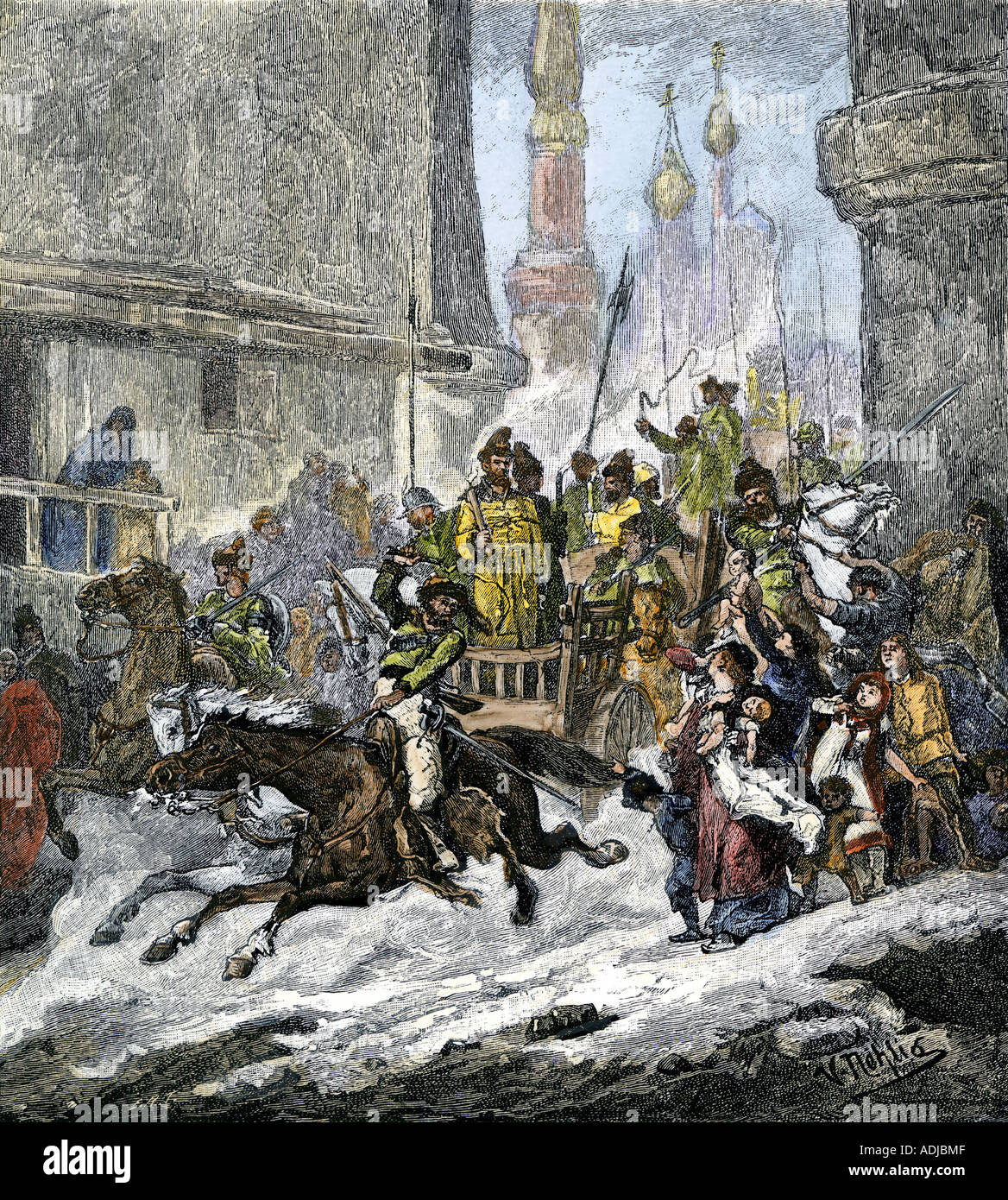 Streltsi taken to execution for their revolt against Tsar Peter the Great 1698. Hand-colored woodcut Stock Photohttps://www.alamy.com/image-license-details/?v=1https://www.alamy.com/streltsi-taken-to-execution-for-their-revolt-against-tsar-peter-the-image7675534.html
Streltsi taken to execution for their revolt against Tsar Peter the Great 1698. Hand-colored woodcut Stock Photohttps://www.alamy.com/image-license-details/?v=1https://www.alamy.com/streltsi-taken-to-execution-for-their-revolt-against-tsar-peter-the-image7675534.htmlRMADJBMF–Streltsi taken to execution for their revolt against Tsar Peter the Great 1698. Hand-colored woodcut
 VIENNA, AUSTRIA - NOV 26: famous horse drawm fiaker at the Stephans Dome by night on November 26,2010 in Vienna, Austria. Since the 17th century, the Stock Photohttps://www.alamy.com/image-license-details/?v=1https://www.alamy.com/vienna-austria-nov-26-famous-horse-drawm-fiaker-at-the-stephans-dome-by-night-on-november-262010-in-vienna-austria-since-the-17th-century-the-image487503250.html
VIENNA, AUSTRIA - NOV 26: famous horse drawm fiaker at the Stephans Dome by night on November 26,2010 in Vienna, Austria. Since the 17th century, the Stock Photohttps://www.alamy.com/image-license-details/?v=1https://www.alamy.com/vienna-austria-nov-26-famous-horse-drawm-fiaker-at-the-stephans-dome-by-night-on-november-262010-in-vienna-austria-since-the-17th-century-the-image487503250.htmlRF2K93KAA–VIENNA, AUSTRIA - NOV 26: famous horse drawm fiaker at the Stephans Dome by night on November 26,2010 in Vienna, Austria. Since the 17th century, the
 Horse carriage and dome of Sheikh Lotfollah Mosque, Imam Square; Isfahan, Iran Stock Photohttps://www.alamy.com/image-license-details/?v=1https://www.alamy.com/stock-photo-horse-carriage-and-dome-of-sheikh-lotfollah-mosque-imam-square-isfahan-85760523.html
Horse carriage and dome of Sheikh Lotfollah Mosque, Imam Square; Isfahan, Iran Stock Photohttps://www.alamy.com/image-license-details/?v=1https://www.alamy.com/stock-photo-horse-carriage-and-dome-of-sheikh-lotfollah-mosque-imam-square-isfahan-85760523.htmlRMEYEMBR–Horse carriage and dome of Sheikh Lotfollah Mosque, Imam Square; Isfahan, Iran
 Tverskaya Street, Moscow, Russia Stock Photohttps://www.alamy.com/image-license-details/?v=1https://www.alamy.com/tverskaya-street-moscow-russia-image66072484.html
Tverskaya Street, Moscow, Russia Stock Photohttps://www.alamy.com/image-license-details/?v=1https://www.alamy.com/tverskaya-street-moscow-russia-image66072484.htmlRMDRDT3G–Tverskaya Street, Moscow, Russia
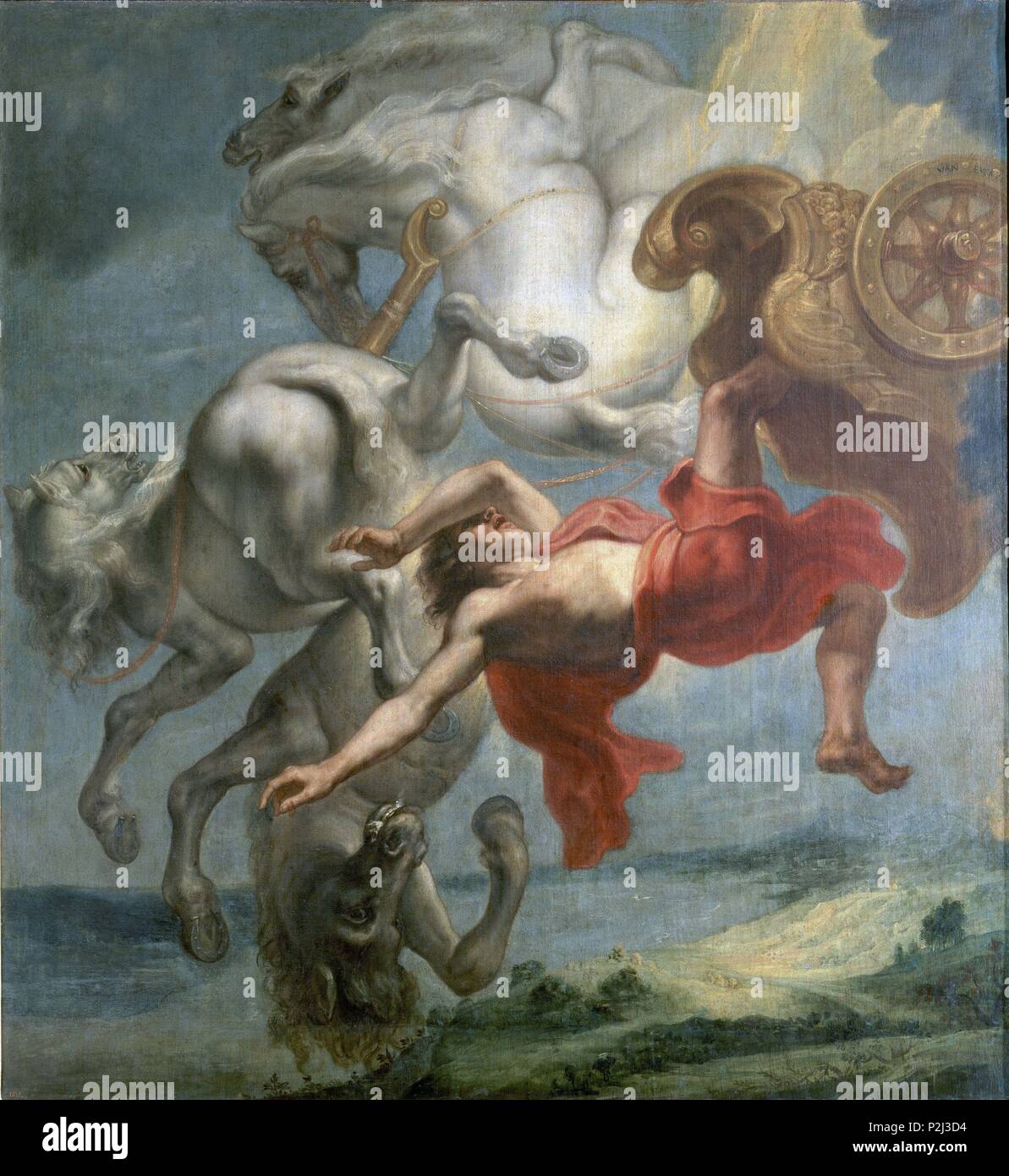 'The Fall of Phaeton', 17th century, Oil on canvas, 197 cm x 180 cm, P01345. Author: Jan Carel van Eyck (b. c. 1649). Location: MUSEO DEL PRADO-PINTURA, MADRID, SPAIN. Stock Photohttps://www.alamy.com/image-license-details/?v=1https://www.alamy.com/the-fall-of-phaeton-17th-century-oil-on-canvas-197-cm-x-180-cm-p01345-author-jan-carel-van-eyck-b-c-1649-location-museo-del-prado-pintura-madrid-spain-image208151584.html
'The Fall of Phaeton', 17th century, Oil on canvas, 197 cm x 180 cm, P01345. Author: Jan Carel van Eyck (b. c. 1649). Location: MUSEO DEL PRADO-PINTURA, MADRID, SPAIN. Stock Photohttps://www.alamy.com/image-license-details/?v=1https://www.alamy.com/the-fall-of-phaeton-17th-century-oil-on-canvas-197-cm-x-180-cm-p01345-author-jan-carel-van-eyck-b-c-1649-location-museo-del-prado-pintura-madrid-spain-image208151584.htmlRMP2J3D4–'The Fall of Phaeton', 17th century, Oil on canvas, 197 cm x 180 cm, P01345. Author: Jan Carel van Eyck (b. c. 1649). Location: MUSEO DEL PRADO-PINTURA, MADRID, SPAIN.
![Mont Cenis Railway scenery: the Dora Valley, near Oulx, 1871. 'The opening of the great railway tunnel through the Alps between Savoy and Piedmont, on the 17th September, has been followed, this week, by the opening of the short line from the tunnel's mouth to the Modane station of the Paris, Lyons, and Mediterranean Company's line in Savoy, by which means there will henceforth be uninterrupted traffic of goods and passengers between France and Italy...[View shows] the scenery on the Italian side of Mont Cenis, the Col de Clairée and Mont Genèvre, where the Dora Riparia flows down to Stock Photo Mont Cenis Railway scenery: the Dora Valley, near Oulx, 1871. 'The opening of the great railway tunnel through the Alps between Savoy and Piedmont, on the 17th September, has been followed, this week, by the opening of the short line from the tunnel's mouth to the Modane station of the Paris, Lyons, and Mediterranean Company's line in Savoy, by which means there will henceforth be uninterrupted traffic of goods and passengers between France and Italy...[View shows] the scenery on the Italian side of Mont Cenis, the Col de Clairée and Mont Genèvre, where the Dora Riparia flows down to Stock Photo](https://c8.alamy.com/comp/2Y3BYDX/mont-cenis-railway-scenery-the-dora-valley-near-oulx-1871-the-opening-of-the-great-railway-tunnel-through-the-alps-between-savoy-and-piedmont-on-the-17th-september-has-been-followed-this-week-by-the-opening-of-the-short-line-from-the-tunnels-mouth-to-the-modane-station-of-the-paris-lyons-and-mediterranean-companys-line-in-savoy-by-which-means-there-will-henceforth-be-uninterrupted-traffic-of-goods-and-passengers-between-france-and-italy-view-shows-the-scenery-on-the-italian-side-of-mont-cenis-the-col-de-clairxe9e-and-mont-genxe8vre-where-the-dora-riparia-flows-down-to-2Y3BYDX.jpg) Mont Cenis Railway scenery: the Dora Valley, near Oulx, 1871. 'The opening of the great railway tunnel through the Alps between Savoy and Piedmont, on the 17th September, has been followed, this week, by the opening of the short line from the tunnel's mouth to the Modane station of the Paris, Lyons, and Mediterranean Company's line in Savoy, by which means there will henceforth be uninterrupted traffic of goods and passengers between France and Italy...[View shows] the scenery on the Italian side of Mont Cenis, the Col de Clairée and Mont Genèvre, where the Dora Riparia flows down to Stock Photohttps://www.alamy.com/image-license-details/?v=1https://www.alamy.com/mont-cenis-railway-scenery-the-dora-valley-near-oulx-1871-the-opening-of-the-great-railway-tunnel-through-the-alps-between-savoy-and-piedmont-on-the-17th-september-has-been-followed-this-week-by-the-opening-of-the-short-line-from-the-tunnels-mouth-to-the-modane-station-of-the-paris-lyons-and-mediterranean-companys-line-in-savoy-by-which-means-there-will-henceforth-be-uninterrupted-traffic-of-goods-and-passengers-between-france-and-italy-view-shows-the-scenery-on-the-italian-side-of-mont-cenis-the-col-de-clairxe9e-and-mont-genxe8vre-where-the-dora-riparia-flows-down-to-image621680246.html
Mont Cenis Railway scenery: the Dora Valley, near Oulx, 1871. 'The opening of the great railway tunnel through the Alps between Savoy and Piedmont, on the 17th September, has been followed, this week, by the opening of the short line from the tunnel's mouth to the Modane station of the Paris, Lyons, and Mediterranean Company's line in Savoy, by which means there will henceforth be uninterrupted traffic of goods and passengers between France and Italy...[View shows] the scenery on the Italian side of Mont Cenis, the Col de Clairée and Mont Genèvre, where the Dora Riparia flows down to Stock Photohttps://www.alamy.com/image-license-details/?v=1https://www.alamy.com/mont-cenis-railway-scenery-the-dora-valley-near-oulx-1871-the-opening-of-the-great-railway-tunnel-through-the-alps-between-savoy-and-piedmont-on-the-17th-september-has-been-followed-this-week-by-the-opening-of-the-short-line-from-the-tunnels-mouth-to-the-modane-station-of-the-paris-lyons-and-mediterranean-companys-line-in-savoy-by-which-means-there-will-henceforth-be-uninterrupted-traffic-of-goods-and-passengers-between-france-and-italy-view-shows-the-scenery-on-the-italian-side-of-mont-cenis-the-col-de-clairxe9e-and-mont-genxe8vre-where-the-dora-riparia-flows-down-to-image621680246.htmlRM2Y3BYDX–Mont Cenis Railway scenery: the Dora Valley, near Oulx, 1871. 'The opening of the great railway tunnel through the Alps between Savoy and Piedmont, on the 17th September, has been followed, this week, by the opening of the short line from the tunnel's mouth to the Modane station of the Paris, Lyons, and Mediterranean Company's line in Savoy, by which means there will henceforth be uninterrupted traffic of goods and passengers between France and Italy...[View shows] the scenery on the Italian side of Mont Cenis, the Col de Clairée and Mont Genèvre, where the Dora Riparia flows down to
 Tverskaya Street, Moscow, Russia Stock Photohttps://www.alamy.com/image-license-details/?v=1https://www.alamy.com/tverskaya-street-moscow-russia-image66072713.html
Tverskaya Street, Moscow, Russia Stock Photohttps://www.alamy.com/image-license-details/?v=1https://www.alamy.com/tverskaya-street-moscow-russia-image66072713.htmlRMDRDTBN–Tverskaya Street, Moscow, Russia
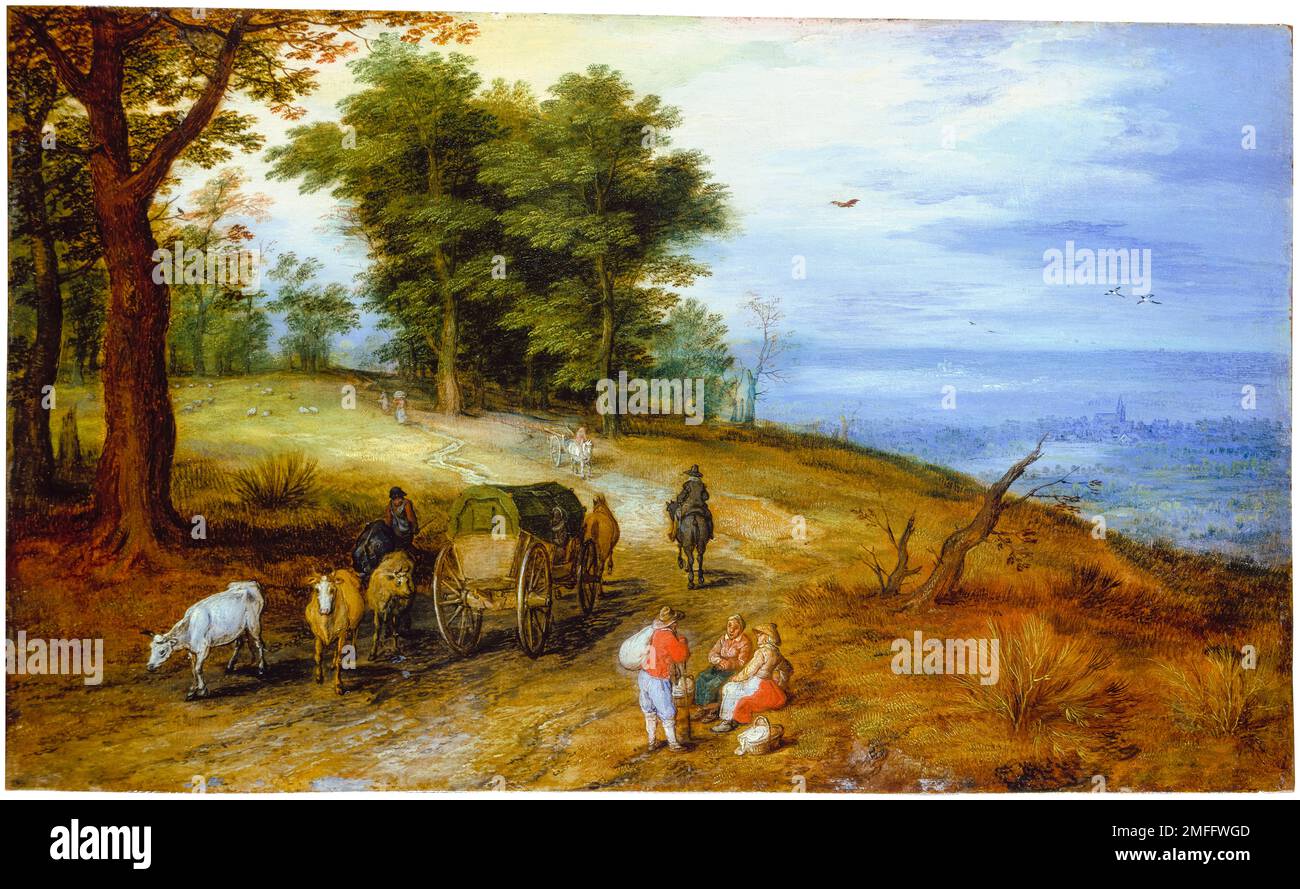 Jan Brueghel the Elder, Wooded Landscape with Figures, painting in oil on copper, 1605-1610 Stock Photohttps://www.alamy.com/image-license-details/?v=1https://www.alamy.com/jan-brueghel-the-elder-wooded-landscape-with-figures-painting-in-oil-on-copper-1605-1610-image508669853.html
Jan Brueghel the Elder, Wooded Landscape with Figures, painting in oil on copper, 1605-1610 Stock Photohttps://www.alamy.com/image-license-details/?v=1https://www.alamy.com/jan-brueghel-the-elder-wooded-landscape-with-figures-painting-in-oil-on-copper-1605-1610-image508669853.htmlRM2MFFWGD–Jan Brueghel the Elder, Wooded Landscape with Figures, painting in oil on copper, 1605-1610
 Illustration by Cecil Aldin, Old Manor Houses Stock Photohttps://www.alamy.com/image-license-details/?v=1https://www.alamy.com/stock-photo-illustration-by-cecil-aldin-old-manor-houses-105387086.html
Illustration by Cecil Aldin, Old Manor Houses Stock Photohttps://www.alamy.com/image-license-details/?v=1https://www.alamy.com/stock-photo-illustration-by-cecil-aldin-old-manor-houses-105387086.htmlRMG3CP8E–Illustration by Cecil Aldin, Old Manor Houses
 Der Fuhrmann (The Carter), wood engraving by Christoph Weigel. Stock Photohttps://www.alamy.com/image-license-details/?v=1https://www.alamy.com/der-fuhrmann-the-carter-wood-engraving-by-christoph-weigel-image247144998.html
Der Fuhrmann (The Carter), wood engraving by Christoph Weigel. Stock Photohttps://www.alamy.com/image-license-details/?v=1https://www.alamy.com/der-fuhrmann-the-carter-wood-engraving-by-christoph-weigel-image247144998.htmlRMTA2BY2–Der Fuhrmann (The Carter), wood engraving by Christoph Weigel.
 Old Arsenal and shipyard, (1617), 1920s. Artist: Unknown Stock Photohttps://www.alamy.com/image-license-details/?v=1https://www.alamy.com/old-arsenal-and-shipyard-1617-1920s-artist-unknown-image262778469.html
Old Arsenal and shipyard, (1617), 1920s. Artist: Unknown Stock Photohttps://www.alamy.com/image-license-details/?v=1https://www.alamy.com/old-arsenal-and-shipyard-1617-1920s-artist-unknown-image262778469.htmlRMW7EGH9–Old Arsenal and shipyard, (1617), 1920s. Artist: Unknown
 Aert van der Neer (c.1603-1677). Dutch painter. River View by Moonlight, c. 1640-1650. Rijksmuseum. Amsterdam. Holland. Stock Photohttps://www.alamy.com/image-license-details/?v=1https://www.alamy.com/aert-van-der-neer-c1603-1677-dutch-painter-river-view-by-moonlight-image66167327.html
Aert van der Neer (c.1603-1677). Dutch painter. River View by Moonlight, c. 1640-1650. Rijksmuseum. Amsterdam. Holland. Stock Photohttps://www.alamy.com/image-license-details/?v=1https://www.alamy.com/aert-van-der-neer-c1603-1677-dutch-painter-river-view-by-moonlight-image66167327.htmlRMDRJ52R–Aert van der Neer (c.1603-1677). Dutch painter. River View by Moonlight, c. 1640-1650. Rijksmuseum. Amsterdam. Holland.
 Northumberland House, Westminster, London, 1815.Artist: J Shury Stock Photohttps://www.alamy.com/image-license-details/?v=1https://www.alamy.com/northumberland-house-westminster-london-1815artist-j-shury-image262763254.html
Northumberland House, Westminster, London, 1815.Artist: J Shury Stock Photohttps://www.alamy.com/image-license-details/?v=1https://www.alamy.com/northumberland-house-westminster-london-1815artist-j-shury-image262763254.htmlRMW7DW5X–Northumberland House, Westminster, London, 1815.Artist: J Shury
 Moving Day by unknown painter Stock Photohttps://www.alamy.com/image-license-details/?v=1https://www.alamy.com/stock-photo-moving-day-by-unknown-painter-30420689.html
Moving Day by unknown painter Stock Photohttps://www.alamy.com/image-license-details/?v=1https://www.alamy.com/stock-photo-moving-day-by-unknown-painter-30420689.htmlRMBNDNW5–Moving Day by unknown painter
 'Landscape with Figures Crossing a Brook', 17th century. Artist: Peeter Gysels. Stock Photohttps://www.alamy.com/image-license-details/?v=1https://www.alamy.com/landscape-with-figures-crossing-a-brook-17th-century-artist-peeter-gysels-image186211651.html
'Landscape with Figures Crossing a Brook', 17th century. Artist: Peeter Gysels. Stock Photohttps://www.alamy.com/image-license-details/?v=1https://www.alamy.com/landscape-with-figures-crossing-a-brook-17th-century-artist-peeter-gysels-image186211651.htmlRMMPXJT3–'Landscape with Figures Crossing a Brook', 17th century. Artist: Peeter Gysels.
 An old engraving of Tyburn, London, Middlesex, England, UK in the early 1600s. It is from a Victorian history book of c.1900. Tyburn was the site of the famous Tyburn Gallows (‘Tyburn Tree’ now occupied by Marble Arch). Hangings at Tyburn often included a procession of the condemned from Newgate Gaol. In 1571 the Tyburn Tree gallows was erected, consisting of a horizontal wooden triangle supported by three legs (a ‘three-legged mare’ or ‘three-legged stool’). Multiple criminals could be hanged at once. Observing the proceedings could also be from the stands (here left). Stock Photohttps://www.alamy.com/image-license-details/?v=1https://www.alamy.com/an-old-engraving-of-tyburn-london-middlesex-england-uk-in-the-early-1600s-it-is-from-a-victorian-history-book-of-c1900-tyburn-was-the-site-of-the-famous-tyburn-gallows-tyburn-tree-now-occupied-by-marble-arch-hangings-at-tyburn-often-included-a-procession-of-the-condemned-from-newgate-gaol-in-1571-the-tyburn-tree-gallows-was-erected-consisting-of-a-horizontal-wooden-triangle-supported-by-three-legs-a-three-legged-mare-or-three-legged-stool-multiple-criminals-could-be-hanged-at-once-observing-the-proceedings-could-also-be-from-the-stands-here-left-image625198123.html
An old engraving of Tyburn, London, Middlesex, England, UK in the early 1600s. It is from a Victorian history book of c.1900. Tyburn was the site of the famous Tyburn Gallows (‘Tyburn Tree’ now occupied by Marble Arch). Hangings at Tyburn often included a procession of the condemned from Newgate Gaol. In 1571 the Tyburn Tree gallows was erected, consisting of a horizontal wooden triangle supported by three legs (a ‘three-legged mare’ or ‘three-legged stool’). Multiple criminals could be hanged at once. Observing the proceedings could also be from the stands (here left). Stock Photohttps://www.alamy.com/image-license-details/?v=1https://www.alamy.com/an-old-engraving-of-tyburn-london-middlesex-england-uk-in-the-early-1600s-it-is-from-a-victorian-history-book-of-c1900-tyburn-was-the-site-of-the-famous-tyburn-gallows-tyburn-tree-now-occupied-by-marble-arch-hangings-at-tyburn-often-included-a-procession-of-the-condemned-from-newgate-gaol-in-1571-the-tyburn-tree-gallows-was-erected-consisting-of-a-horizontal-wooden-triangle-supported-by-three-legs-a-three-legged-mare-or-three-legged-stool-multiple-criminals-could-be-hanged-at-once-observing-the-proceedings-could-also-be-from-the-stands-here-left-image625198123.htmlRM2Y946GB–An old engraving of Tyburn, London, Middlesex, England, UK in the early 1600s. It is from a Victorian history book of c.1900. Tyburn was the site of the famous Tyburn Gallows (‘Tyburn Tree’ now occupied by Marble Arch). Hangings at Tyburn often included a procession of the condemned from Newgate Gaol. In 1571 the Tyburn Tree gallows was erected, consisting of a horizontal wooden triangle supported by three legs (a ‘three-legged mare’ or ‘three-legged stool’). Multiple criminals could be hanged at once. Observing the proceedings could also be from the stands (here left).
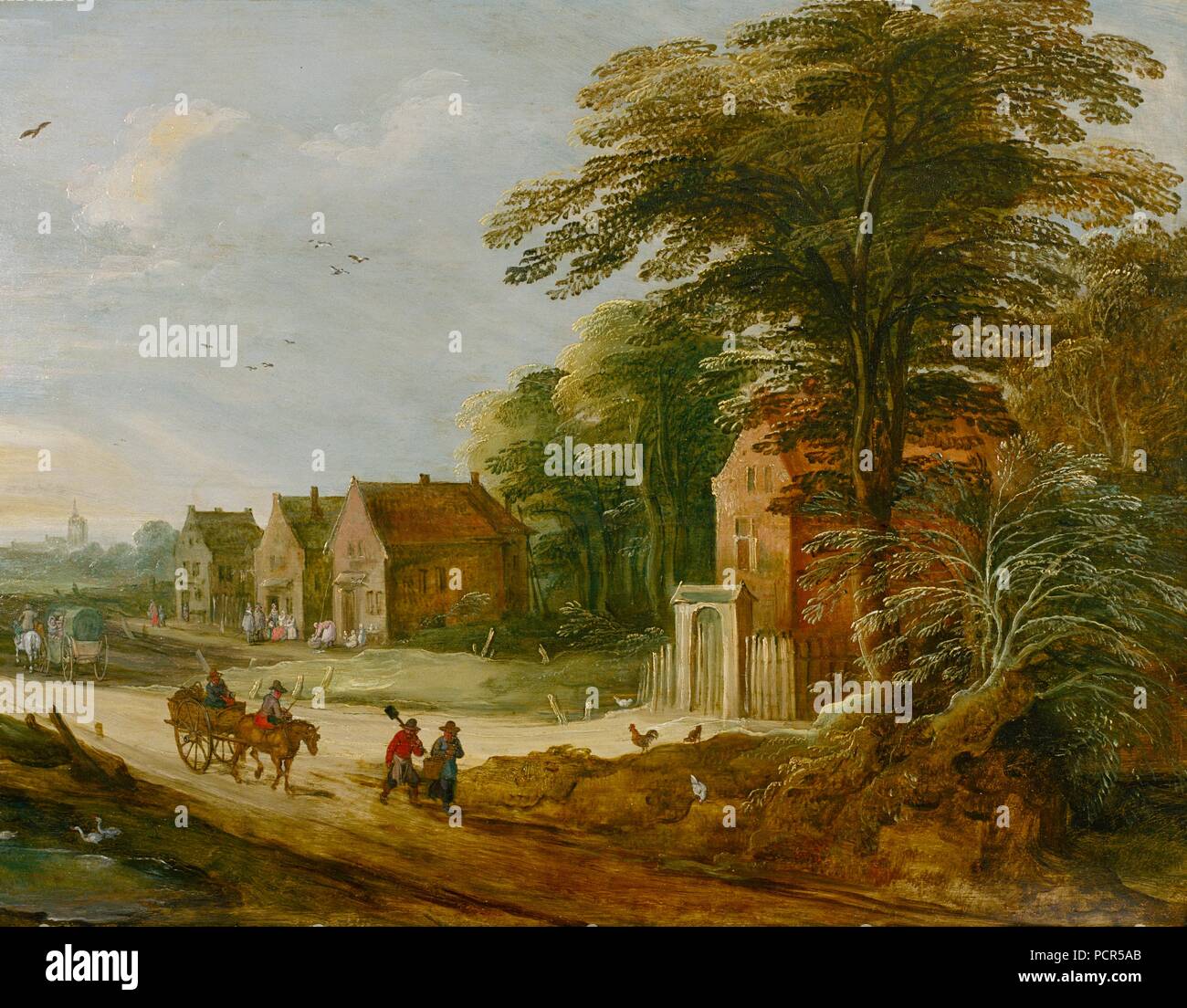 'Travellers Passing through a Village', late 16th or early 17th century. Artist: Joos de Momper, the younger. Stock Photohttps://www.alamy.com/image-license-details/?v=1https://www.alamy.com/travellers-passing-through-a-village-late-16th-or-early-17th-century-artist-joos-de-momper-the-younger-image214409395.html
'Travellers Passing through a Village', late 16th or early 17th century. Artist: Joos de Momper, the younger. Stock Photohttps://www.alamy.com/image-license-details/?v=1https://www.alamy.com/travellers-passing-through-a-village-late-16th-or-early-17th-century-artist-joos-de-momper-the-younger-image214409395.htmlRMPCR5AB–'Travellers Passing through a Village', late 16th or early 17th century. Artist: Joos de Momper, the younger.
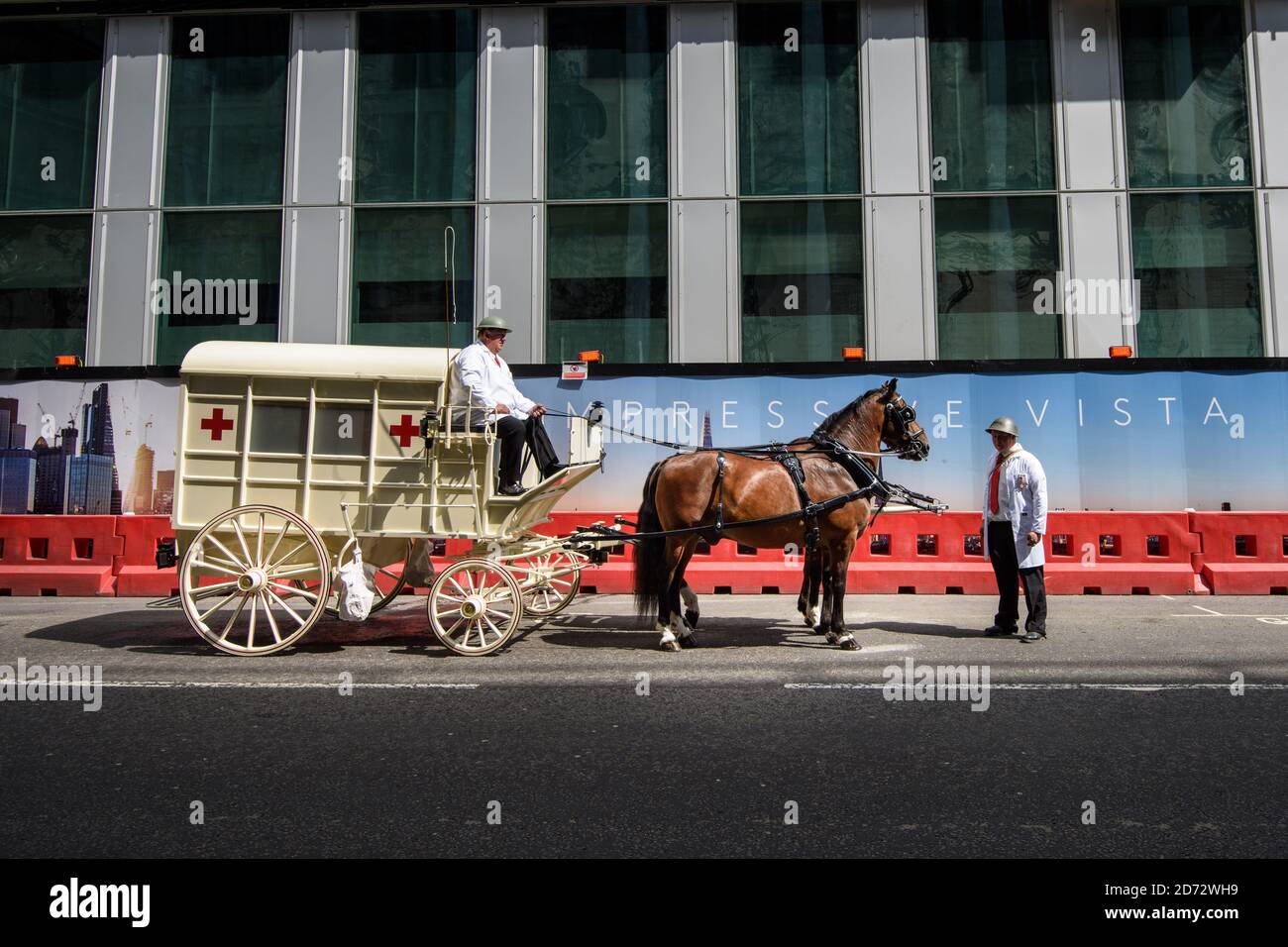 Members of the Worshipful Company of Carmen drive their historic carts and vehicles to Guildhall, in the City of London, for the annual Cart Marking Ceremony. The tradition, originating in the licensing of vehicles for hire in the 17th century, sees each vehicle branded with a letter to mark its official licensed status. Picture date: Wednesday July 18th, 2018. Photo credit should read: Matt Crossick/ EMPICS Entertainment. Stock Photohttps://www.alamy.com/image-license-details/?v=1https://www.alamy.com/members-of-the-worshipful-company-of-carmen-drive-their-historic-carts-and-vehicles-to-guildhall-in-the-city-of-london-for-the-annual-cart-marking-ceremony-the-tradition-originating-in-the-licensing-of-vehicles-for-hire-in-the-17th-century-sees-each-vehicle-branded-with-a-letter-to-mark-its-official-licensed-status-picture-date-wednesday-july-18th-2018-photo-credit-should-read-matt-crossick-empics-entertainment-image382994677.html
Members of the Worshipful Company of Carmen drive their historic carts and vehicles to Guildhall, in the City of London, for the annual Cart Marking Ceremony. The tradition, originating in the licensing of vehicles for hire in the 17th century, sees each vehicle branded with a letter to mark its official licensed status. Picture date: Wednesday July 18th, 2018. Photo credit should read: Matt Crossick/ EMPICS Entertainment. Stock Photohttps://www.alamy.com/image-license-details/?v=1https://www.alamy.com/members-of-the-worshipful-company-of-carmen-drive-their-historic-carts-and-vehicles-to-guildhall-in-the-city-of-london-for-the-annual-cart-marking-ceremony-the-tradition-originating-in-the-licensing-of-vehicles-for-hire-in-the-17th-century-sees-each-vehicle-branded-with-a-letter-to-mark-its-official-licensed-status-picture-date-wednesday-july-18th-2018-photo-credit-should-read-matt-crossick-empics-entertainment-image382994677.htmlRM2D72WH9–Members of the Worshipful Company of Carmen drive their historic carts and vehicles to Guildhall, in the City of London, for the annual Cart Marking Ceremony. The tradition, originating in the licensing of vehicles for hire in the 17th century, sees each vehicle branded with a letter to mark its official licensed status. Picture date: Wednesday July 18th, 2018. Photo credit should read: Matt Crossick/ EMPICS Entertainment.
 View of Westminster Hall and New Palace Yard, London, c1648. Artist: John Seller Stock Photohttps://www.alamy.com/image-license-details/?v=1https://www.alamy.com/view-of-westminster-hall-and-new-palace-yard-london-c1648-artist-john-image60219870.html
View of Westminster Hall and New Palace Yard, London, c1648. Artist: John Seller Stock Photohttps://www.alamy.com/image-license-details/?v=1https://www.alamy.com/view-of-westminster-hall-and-new-palace-yard-london-c1648-artist-john-image60219870.htmlRMDDY71J–View of Westminster Hall and New Palace Yard, London, c1648. Artist: John Seller
 Central America, Nicaragua. Colonial city of Granada. Traditional horse carriage in front of historic Guadalupe Church, founded in 1624-1626. Stock Photohttps://www.alamy.com/image-license-details/?v=1https://www.alamy.com/stock-image-central-america-nicaragua-colonial-city-of-granada-traditional-horse-165989728.html
Central America, Nicaragua. Colonial city of Granada. Traditional horse carriage in front of historic Guadalupe Church, founded in 1624-1626. Stock Photohttps://www.alamy.com/image-license-details/?v=1https://www.alamy.com/stock-image-central-america-nicaragua-colonial-city-of-granada-traditional-horse-165989728.htmlRMKJ1DGG–Central America, Nicaragua. Colonial city of Granada. Traditional horse carriage in front of historic Guadalupe Church, founded in 1624-1626.
 VIENNA, AUSTRIA - NOV 26: famous horse drawm fiaker at the Stephans Dome by night on November 26,2010 in Vienna, Austria. Since the 17th century, the Stock Photohttps://www.alamy.com/image-license-details/?v=1https://www.alamy.com/vienna-austria-nov-26-famous-horse-drawm-fiaker-at-the-stephans-dome-by-night-on-november-262010-in-vienna-austria-since-the-17th-century-the-image487503253.html
VIENNA, AUSTRIA - NOV 26: famous horse drawm fiaker at the Stephans Dome by night on November 26,2010 in Vienna, Austria. Since the 17th century, the Stock Photohttps://www.alamy.com/image-license-details/?v=1https://www.alamy.com/vienna-austria-nov-26-famous-horse-drawm-fiaker-at-the-stephans-dome-by-night-on-november-262010-in-vienna-austria-since-the-17th-century-the-image487503253.htmlRF2K93KAD–VIENNA, AUSTRIA - NOV 26: famous horse drawm fiaker at the Stephans Dome by night on November 26,2010 in Vienna, Austria. Since the 17th century, the
 Figures with horses and a cart on a country path; a large tree on the left-hand side; the ruins of a large building in the middle ground; a church or cathedral spire on the left-hand side in the distance. A Ruine neere Chichester. c. 1660. Etching. Source: Maps K.Top.42.19.a.4. Language: English. Author: Dunstall, John. Stock Photohttps://www.alamy.com/image-license-details/?v=1https://www.alamy.com/figures-with-horses-and-a-cart-on-a-country-path-a-large-tree-on-the-left-hand-side-the-ruins-of-a-large-building-in-the-middle-ground-a-church-or-cathedral-spire-on-the-left-hand-side-in-the-distance-a-ruine-neere-chichester-c-1660-etching-source-maps-ktop4219a4-language-english-author-dunstall-john-image226965913.html
Figures with horses and a cart on a country path; a large tree on the left-hand side; the ruins of a large building in the middle ground; a church or cathedral spire on the left-hand side in the distance. A Ruine neere Chichester. c. 1660. Etching. Source: Maps K.Top.42.19.a.4. Language: English. Author: Dunstall, John. Stock Photohttps://www.alamy.com/image-license-details/?v=1https://www.alamy.com/figures-with-horses-and-a-cart-on-a-country-path-a-large-tree-on-the-left-hand-side-the-ruins-of-a-large-building-in-the-middle-ground-a-church-or-cathedral-spire-on-the-left-hand-side-in-the-distance-a-ruine-neere-chichester-c-1660-etching-source-maps-ktop4219a4-language-english-author-dunstall-john-image226965913.htmlRMR5759D–Figures with horses and a cart on a country path; a large tree on the left-hand side; the ruins of a large building in the middle ground; a church or cathedral spire on the left-hand side in the distance. A Ruine neere Chichester. c. 1660. Etching. Source: Maps K.Top.42.19.a.4. Language: English. Author: Dunstall, John.
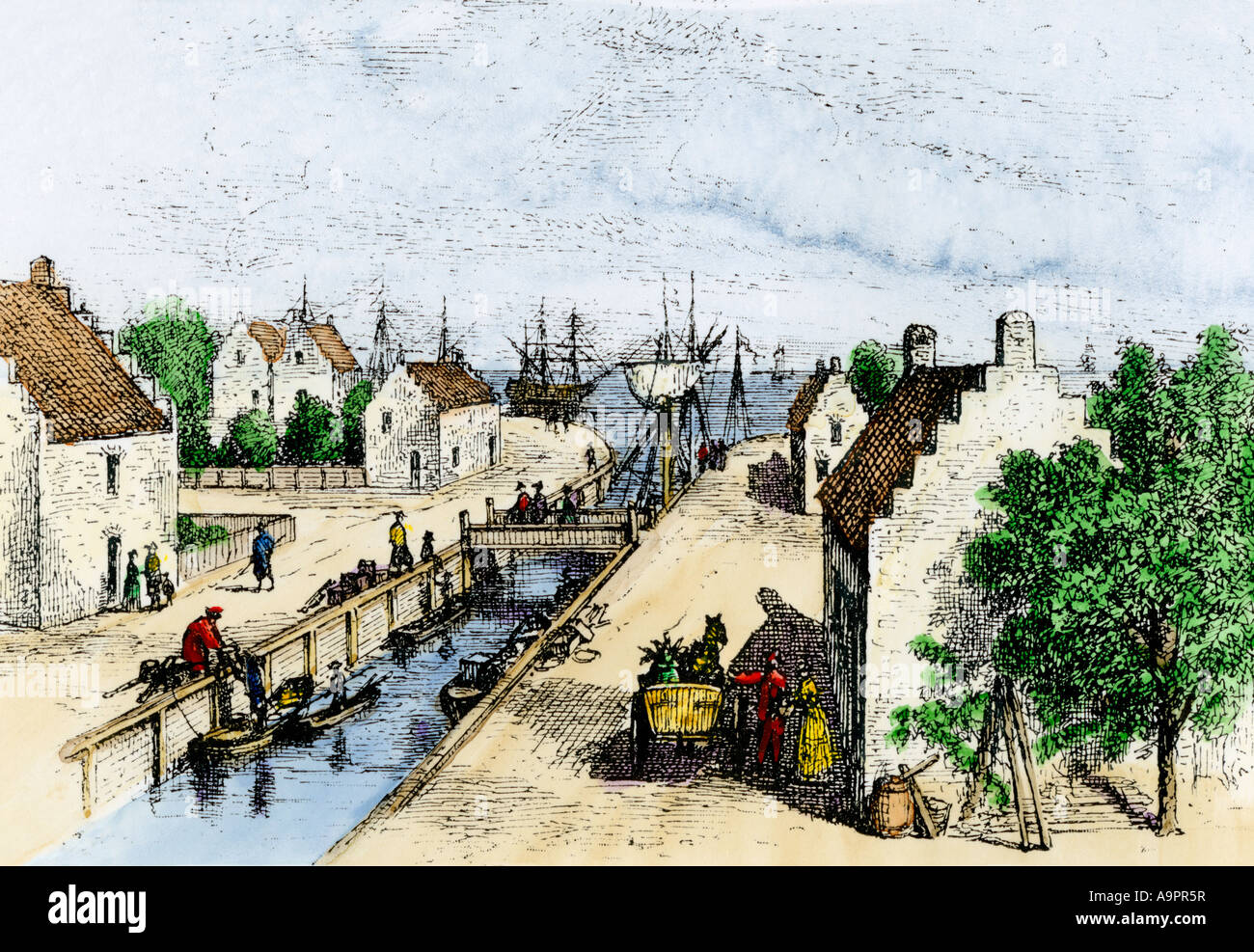 The canal in Broad Street New Amsterdam now New York City 1600s. Hand-colored woodcut Stock Photohttps://www.alamy.com/image-license-details/?v=1https://www.alamy.com/stock-photo-the-canal-in-broad-street-new-amsterdam-now-new-york-city-1600s-hand-12420082.html
The canal in Broad Street New Amsterdam now New York City 1600s. Hand-colored woodcut Stock Photohttps://www.alamy.com/image-license-details/?v=1https://www.alamy.com/stock-photo-the-canal-in-broad-street-new-amsterdam-now-new-york-city-1600s-hand-12420082.htmlRMA9PR5R–The canal in Broad Street New Amsterdam now New York City 1600s. Hand-colored woodcut
 Jan Carel van Eyck / 'The Fall of Phaeton', 17th century, Flemish School, Oil on canvas, 197 cm x 180 cm, P01345. Museum: MUSEO DEL PRADO, MADRID, SPAIN. Stock Photohttps://www.alamy.com/image-license-details/?v=1https://www.alamy.com/jan-carel-van-eyck-the-fall-of-phaeton-17th-century-flemish-school-oil-on-canvas-197-cm-x-180-cm-p01345-museum-museo-del-prado-madrid-spain-image630871603.html
Jan Carel van Eyck / 'The Fall of Phaeton', 17th century, Flemish School, Oil on canvas, 197 cm x 180 cm, P01345. Museum: MUSEO DEL PRADO, MADRID, SPAIN. Stock Photohttps://www.alamy.com/image-license-details/?v=1https://www.alamy.com/jan-carel-van-eyck-the-fall-of-phaeton-17th-century-flemish-school-oil-on-canvas-197-cm-x-180-cm-p01345-museum-museo-del-prado-madrid-spain-image630871603.htmlRM2YJAK4K–Jan Carel van Eyck / 'The Fall of Phaeton', 17th century, Flemish School, Oil on canvas, 197 cm x 180 cm, P01345. Museum: MUSEO DEL PRADO, MADRID, SPAIN.
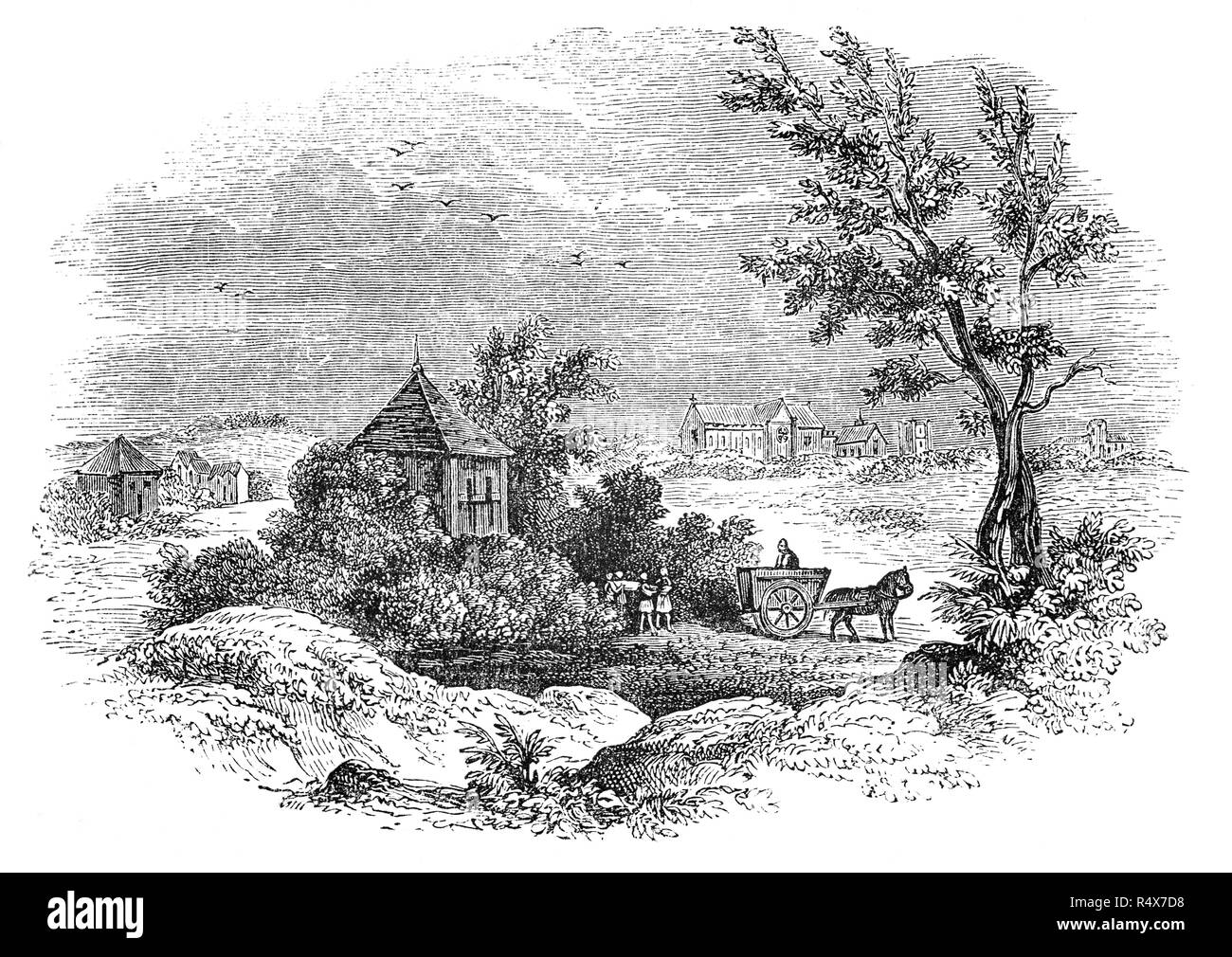 A 'Pest house' (isolation hospital in times of plague), Tothill Fields, Westminster, London, England. After Cromwell's victory at the Battle of Worcester in September 1651, some 4,000 defeated Royalists were imprisoned at Tothill Fields prior to being sold as slaves to merchants trading with Africa and the West Indies. Facilities at the prison camp on the marshy ground were so poor that 1,200 prisoners were recorded as having died in the primitive conditions. Stock Photohttps://www.alamy.com/image-license-details/?v=1https://www.alamy.com/a-pest-house-isolation-hospital-in-times-of-plague-tothill-fields-westminster-london-england-after-cromwells-victory-at-the-battle-of-worcester-in-september-1651-some-4000-defeated-royalists-were-imprisoned-at-tothill-fields-prior-to-being-sold-as-slaves-to-merchants-trading-with-africa-and-the-west-indies-facilities-at-the-prison-camp-on-the-marshy-ground-were-so-poor-that-1200-prisoners-were-recorded-as-having-died-in-the-primitive-conditions-image226770020.html
A 'Pest house' (isolation hospital in times of plague), Tothill Fields, Westminster, London, England. After Cromwell's victory at the Battle of Worcester in September 1651, some 4,000 defeated Royalists were imprisoned at Tothill Fields prior to being sold as slaves to merchants trading with Africa and the West Indies. Facilities at the prison camp on the marshy ground were so poor that 1,200 prisoners were recorded as having died in the primitive conditions. Stock Photohttps://www.alamy.com/image-license-details/?v=1https://www.alamy.com/a-pest-house-isolation-hospital-in-times-of-plague-tothill-fields-westminster-london-england-after-cromwells-victory-at-the-battle-of-worcester-in-september-1651-some-4000-defeated-royalists-were-imprisoned-at-tothill-fields-prior-to-being-sold-as-slaves-to-merchants-trading-with-africa-and-the-west-indies-facilities-at-the-prison-camp-on-the-marshy-ground-were-so-poor-that-1200-prisoners-were-recorded-as-having-died-in-the-primitive-conditions-image226770020.htmlRMR4X7D8–A 'Pest house' (isolation hospital in times of plague), Tothill Fields, Westminster, London, England. After Cromwell's victory at the Battle of Worcester in September 1651, some 4,000 defeated Royalists were imprisoned at Tothill Fields prior to being sold as slaves to merchants trading with Africa and the West Indies. Facilities at the prison camp on the marshy ground were so poor that 1,200 prisoners were recorded as having died in the primitive conditions.
 Stage coaches and carts to be used on set for Ridley Scott film on Napoleon being filmed in part at Greenwich Old Royal Naval College Stock Photohttps://www.alamy.com/image-license-details/?v=1https://www.alamy.com/stage-coaches-and-carts-to-be-used-on-set-for-ridley-scott-film-on-napoleon-being-filmed-in-part-at-greenwich-old-royal-naval-college-image463572027.html
Stage coaches and carts to be used on set for Ridley Scott film on Napoleon being filmed in part at Greenwich Old Royal Naval College Stock Photohttps://www.alamy.com/image-license-details/?v=1https://www.alamy.com/stage-coaches-and-carts-to-be-used-on-set-for-ridley-scott-film-on-napoleon-being-filmed-in-part-at-greenwich-old-royal-naval-college-image463572027.htmlRF2HX5ERR–Stage coaches and carts to be used on set for Ridley Scott film on Napoleon being filmed in part at Greenwich Old Royal Naval College

